- English (EN)
- Español (ES)
- Português (BR)

Is Sao Paulo Safe? Crime Rates & Safety Report
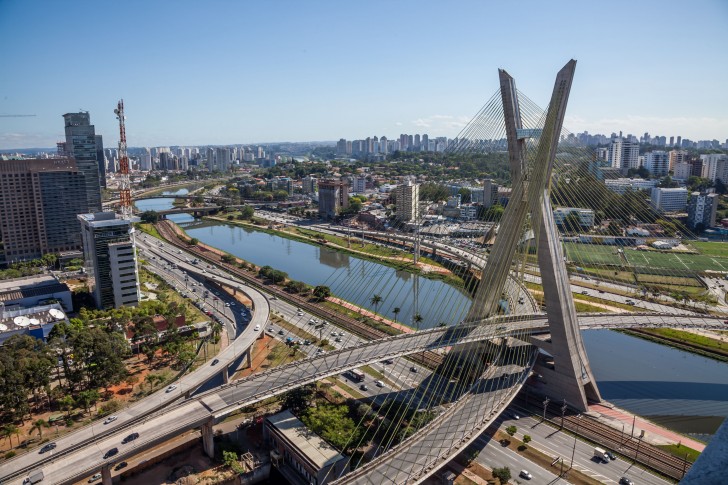
Brazil : Safety by City
- Belo Horizonte
- Florianopolis
- Porto Alegre
- Rio de Janeiro
São Paulo, the largest city in Brazil has a city population of 11 million and even more than 20 million in the metropolitan region.
Many immigrants used to be attracted to this incredible city, so it is one of the most diverse cities in the world.
Sao Paulo is the capital of rich people, nightlife and culture.
Although tourists who visit Brazil often prefer the beaches of Salvador de Bahia or Rio de Janeiro, Sao Paulo is surely a great tourist destination with its museums, restaurants or jovial nightlife.
Some of the must-see sights of Sao Paulo are the Neo-Byzantine Catedral de Sé, the Municipal Market and São Paulo Museum of Art.
- Warnings & Dangers in Sao Paulo
OVERALL RISK: MEDIUM
If you take into consideration all the possible dangers in Sao Paulo, it is an averagely safe city. As in any other city, some unsafe parts should be avoided, particularly at night.
TRANSPORT & TAXIS RISK: MEDIUM
Public transport in Sao Paulo can be considered unsafe. While the metro and buses are believed to be generally safe, buses and bus stops are risky, mainly at night.
PICKPOCKETS RISK: MEDIUM
Areas around Praca de Sé, the metro and bus, and train stations, as well as crowded zones, are the main locations of the pickpockets. Thieves also operate in markets and hotels. Caution is compulsory when traveling at night through rural areas since a few precautions will minimize the chance of being pickpocketed.
NATURAL DISASTERS RISK: MEDIUM
Some natural disasters, like the flooding caused by the heavy rainfall, which affects the mud to rush down the mountains and destroy the towns by knocking down houses are possible in Sao Paulo.
MUGGING RISK: HIGH
Mugging and kidnapping are very common in Sao Paulo particularly in urban areas where tourists are forced to take their money from ATMs and give it to the kidnappers to be released. The best solution to avoid the risk of being kidnapped during the night is to travel in a private car.
TERRORISM RISK: LOW
When the terrorism risk is concerned, Sao Paulo is believed to be a very safe city and it is marked as a low-threat location for terrorist activity.
SCAMS RISK: MEDIUM
Tourist places are locations where lawbreakers will try to scam you. In Sao Paulo, tourists should be extremely cautious around ATMs and avoid being surrounded by groups of teenagers with strange behavior or people who want to help them.
WOMEN TRAVELERS RISK: LOW
Women are generally safe in Sao Paulo and can walk alone through the city, but still, nights are extremely dangerous, so it is not always advisable for a female to find herself alone on empty and dark streets.
- So... How Safe Is Sao Paulo Really?
Brazil is the country that has some unsolved issues with crime and that continues to be the principal danger to its visitors.
Fortunately, the crime rates are decreasing especially in Sao Paulo being a great tourist destination.
The Westside of Sao Paulo is a center of business, nightlife, and education, and it is safer than other parts, being the city’s richest area.
The police presence around Praça de Sé in the old city center makes this area safe, unlike the Crackland area near the Parque de la Luz that needs to be completely avoided by tourists due to the appearance of the drug addicts, prostitutes, and criminals.
Some areas are very dangerous for travelers as well as the citizens of Sao Paulo since robbery, assault, burglary, and theft happens at all times of the day.
Violent crimes like murder, rape, and kidnappings are attributed to street gangs and organized groups and they are not very frequent.
Regardless of all these dangers, Sao Paulo should not be taken as a city to be avoided.
Quite contrary, it is a great city to explore, with its world-class restaurants and major cultural and historical attractions, as long as you remain vigilant while touring the city.
- How Does Sao Paulo Compare?
- Useful Information
Tourists from the US who want to visit Brazil have to pay a 160$ fee to get the visa. However, some other countries do not need visas if it is less than 90 days visit. Travelers can check the official Brazil tourism website to get information about visas.
Brazil’s official currency is the Brazilian Real (R$). Even though Brazil is one of the most expensive countries in South America, it is considered a relatively cheap tourist destination.
Sao Paulo is the city that can be visited throughout the whole year because winter temperatures range between 8 and 21 °C. The record high temperature was 37.8 °C and the lowest −2 ° C. Because of its elevation, Sao Paulo has a temperate climate.
There are two main airports in Sao Paulo, São Paulo–Guarulhos International Airport and Congonhas-São Paulo Airport for domestic flights. The number of air passenger movements makes Sao Paulo one of the top 15 busiest airports in the world. Other alternative airports are Viracopos-Campinas International Airport, São José dos Campos Airport and Jundiaí Airport which can be used to avoid the crowds.
Travel Insurance
When traveling anywhere in the world, accidents and illnesses cannot be predicted. So when traveling to Sao Paulo, it is suggested to have international travel health insurance as well as the insurance in case of theft and loss of personal items.
Sao Paulo Weather Averages (Temperatures)
- Average High/Low Temperature
Brazil - Safety by City
- Where to Next?

36 Reviews on Sao Paulo
I am from middle east. will they think i am a tourist when im there? cus my skin color is likely the same as brazilian people
You will love Brasil
Once you speak, they will know you are a tourist. I have been to Sao Paulo and trust me, the people are great. They are friendly and very helpful. They look upon it as an honour you are visiting their country and they are proud of their country. There was no racism or anti colour feeling there that I saw. You will love the place.
People are not helpful if your skin is brown or darker, just don’t go. This review is simply not true.
São Paulo is a great city
I spent a year in São Paulo in the Jardin neighborhood. Walked all hours of the night and never had an issue. In other areas of the city, of course, there are problems.
Stay at the Renaissance off Paulista it’s a great safe neighborhood as much as a big city can be safe.
Many places such as rio de janeiro and sao paulo are majority white so no
Brazilians minimize everything
They are not. Brazilians love to say that but it’s simply not true. I’d say in SP people are around 30-35% fully white. Then you get around 40% who are mixed and brazilians call them(selves) white but they wouldn’t be classified as white in North America (or even in Australia). Finally, the rest are simply not white and not mixed.
Yes, we will, plus you’re not welcome.
Nice brudda. How interesting. thanks for sharing bro. Thanks for letting me know. Thanks for sharing info. I got knifed in the back of the head bro. Rip bro.
Some guy shot at but I dodged the bullet so you’ll probs die
My opinion about São Paulo
As a Brazilian I would say that São Paulo is a melting pot (I myself am descendant of Japanese) and you may be mistaken at first for a local. However, racism is present and if you come to São Paulo you’ll notice that if you go to nice and rich neighborhoods the majority of people you will find there will be white. Sadly, it’s true that if your skin color is brighter you will be treated better than someone with darker skin. It’s not always, but it happens a lot. Last but not least, just to align expectations, let me tell you that São Paulo is just a very large city, good for business, qirh nice restaurants, but not full of nature as some foreigners would expect of any Brazilian city.
It really depends
It’s alright, São Paulo is safe is certain areas but if you’re in a sketchy looking place, then trust your gut.
It's a great city
I was born in São Paulo and still live here. I am 30 years old and have never been mugged, stolen or suffered any kind of violence. I’m not saying that it doesn’t happen here, but it changes a lot from one place to another. If you are going to tourist places, just be aware of your surroundings and don’t be too naive. Streetwise is a differential.
Beware brazilians opinions
Stop lying mate, you know your city is only safe compared to Rio which is one of the most violent places in the western hemisphere.
Kidnapped, tortured, made homeless and robbed
He is lying: when I was in Sao Paulo I was kidnapped in a fake hotel by people that either were or were linked to terrorists, tortured by the police who used pharmocological torture. I had my computer stolen, bought another had this one stolen, had my phone stolen: when kidnapped. I also had my passport stolen at knife point in GRU airport, and had to go effectively homeless because I could not discern how to make sure any hotel was real and not for kidnapping. When I got back to the airport the people that I had my flights with would not let me use their phone to call my embassy. Instead they said they would call but would not because obviously as a white British westerner I somehow am at fault that their country is not a first world country. I ended up in the airport for almost a month. Its an extremely dangerous country which In say people should avoid at all cost.
Well, if it's true it wasn't your day!
I’m Brazilian although the country isn’t safe at all your story sounds phony. Sorry, it’s too “fantastic”, almost a psychological thriller by David Lynch.
Golden rule
The golden rule is to exercise caution when walking on streets or other public places. Even during the day. Do not stop to talk with strangers who come with some persuasive talk or some ordinary question. By night, avoid nearly any street walking, with the exception of crowded restaurant and bar streets such as those from Vila Madalena neighborhood. Said that, everything else tend to be pretty safe.
The rule is be cautious. If you ever lose direction, don’t show it out, read ch out for map and get yours ass fixed. Teens are equally malicious in the city.
How is São Paulo mediumly safe? Muggers can smell turists in 10miles. There is a 0% chance that you will not be mugged if you come from outside south America and if you stay here long enough. Locals saying “I have never been mugged” OF COURSE! YOU ARE BRAZILIAN!! Brazilian come out of their houses with no wallet, no purse and dressed like they are entering a favela. Of course they don’t get mugged. If they are rich they simply never leave their safe places, they never take a walk, ESPECIALLY AT NIGHT. I dare you going out for drinks in ANY fancy neighborhood (NOT SKETCHY ONES, it would be too easy to get mugged there) and walking there without getting mugged. I also dare you to put your phone in your bag in ANY form of public transportation. Let’s see how many seconds it lasts. Especially if you are from Europe. Now I will go down the rabbit hole that this website is to find out which city has earned a worse classification of São Paulo, asking myself how is that even possible, unless you count Rio or those states in Brazil with saints names in it. (Also ref: I am from Southern Europe and I have been working and living in pinherios, São Paulo for 5 years)
Yeah good shout
10000000% accurate!! don’t trusth brazilians specially in this kind of websites!
I worked in Brookling Paulista and I agree with you, city is big and that’s why it has big companies but is simply… TRASH.
Ugliest largest city in South America
It’s extemely misleading about getting scam… in real life brazilians deal with scammers everyday, they call them ‘golpistas’. If you are a gringo your chances or getting scammed are VERY HIGH.
City is extremely unsafe near downtown, and very unsafe and dangerous around Avenida Paulista and somewhat in the rest of the neighborhoods. Don’t trust brazilians about it being ‘safer than Rio’. Río has war-like statistics, so maybe even Bagdad is safer than Rio!
They say São Paulo is richer state in Brazil but city is very poor… you will see some rich people living in bunker-like towers and using helicopters but 90% of the city is ugly and quite poor. Graffities and homeless everywhere, small streets of 40cm wide with no threes and ugly houses or buildings (usually you only will see a fence in decay). I suggest you to check on google street view how people live there before you dare to go.
Also, avoid it all cost if you african american. People are racist and hate crime is rampant trough whole city.
It wasn’t worth my time and they tried to scam me several times. At least Rio is ugly and dangerous but has Pao de Acucar; São Paulo it’s just ugly and dangerous.
Didn't enjoy it but i was in a cruiser
Agree with most of reviews here
Agree with the negative reviews, seems than most of the ones who gave positive comments are brazilians or in love with one…
Extremely dangerous for woman, been there and regret it.
I had one of my worst times down there.
Brazil not worth it
I visited Brazil once and that is the only South-American country I will never visit again for sure. People are not helpfull and not friendly. I did not experience any robberies or crime activities but damn, it just is not a nice place to be. I suggest going to Colombia or central-american countries like Panama and Costa Rica, much much better and people there are sincerely friendly unlike to Brazil. Sad because it could be a top destination, but that country is just fkd up due to corruption and crime
Not hot water
They don’t have hot water and sanitation is bad
got stabbed went to hospital got bad disease
Safe if you aren't easy target
Shame to see all the negative reviews. I spent 3 months in SP. I am a tall, white male that is clearly a foreigner.
I stayed in the nicer parts of the city (think Jardins/Itaim) and never had an issues except losing my phone at a nightclub (I ended up recovering it).
There were a few times where I walked alone at night, and while I was definitely on-guard, never had any problems. I carried myself with confidence. Never made myself an easy target.
I went out / partied a lot. There were plenty of times where I was sauced af, but still, no issues. Those 3 months in SP were amazing.
What made my experience safer and better was I had local brazilian friends who live there, and I also spoke conversational Portuguese.
I hope to return soon!
I know you were there because I can tell by your story which is the exact same story as mine except I was there for a year in the same location.
I would leave O’Malley’s all hours of the night and walk back to the Renaissance with no issues. Ali the owner of O’Malley‘s told me it was safe but be aware.
Felt safe, but you can’t be naive
I’ve had a similar experience during my time in Brazil. Many travelers are arrogant, naive and don’t plan ahead. If you don’t speak any portuguese or know anyone you’re more likely to have issues. I’ve been here for a month and go out constantly. Never had an isse and I find Brazilians helpful if you try and apeak portuguese
I felt safe
I personally been to both. São Paulo and Rio and at no point did I ever feel scared for my life or unsafe. I was however accompanied by a local Brazilian. Mostly traveled in a group of 3 but did walk alone a night a few times to grab food. I however am a black man . I did experience colorism though. If you’re dark skin they will automatically assume you don’t have any money which honestly is fine by me. They weren’t Harassing me on the beach to buy sunglasses like they did my white counterpart. Nice how far the dollar stretches down there. You can easily ball out for a few hundred dollars out there.
I loved brazil very nice place welcoming people hardworking and friendly
I have been to brazil and found it a very nice respectful safe place I’m a tourist there and just loved the culture people and the food and drink. Like any where just take precautions when out and about especially at night. It’s not safe to travel on your own at night especially as a woman and I do agree on what others have said. I was alone female travelling to brazil on my own and went throughout brazil caught buses trains went on cable cars etc never had a problem I made sure I had little money on me I made sure when I took taxis they was from booked from airport or hotel and I didnt walk alone in any streets I wasnt confident about. Its using your common sense and just having caution and taking responsibility. Respect the locals they are lovely very welcoming friendly hardworking people yes they are dangers about but you can minimised the risk by taking advice from locals and taking responsibility too using common sense dressing down not showing off valuables money and using licenced taxis
Share Your Experience Cancel reply
Your Review
Title of your review
Article Contents
- Sao Paulo : Safety by City
- Overall Risk
- Transport & Taxis Risk
- Pickpockets Risk
- Natural Disasters Risk
- Mugging Risk
- Terrorism Risk
- Women Travelers Risk
- Weather Averages (Temperatures)
- User Reviews
- Share Your Experience
Popular Destinations

Safety Index
Recent reviews & comments.
- Joan Coleman on 10 Safest Cities in Kansas
- Norman Delavigne on 10 Safest Cities in Kansas
- Nick Logan on 10 Safest Cities in Kansas
- Teddy Brown on Valley City
Popular US States
- Pennsylvania
We’re sorry, this site is currently experiencing technical difficulties. Please try again in a few moments. Exception: request blocked
2024 U.S. Election September 23, 2024
Returning your absentee ballot from overseas.
- Travel Advisories |
- Contact Us |
- MyTravelGov |
Find U.S. Embassies & Consulates
Travel.state.gov, congressional liaison, special issuance agency, u.s. passports, international travel, intercountry adoption, international parental child abduction, records and authentications, popular links, travel advisories, mytravelgov, stay connected, legal resources, legal information, info for u.s. law enforcement, replace or certify documents.
Before You Go
Learn About Your Destination
While Abroad
Emergencies
Share this page:
Travel Advisory October 19, 2023
Brazil - level 2: exercise increased caution.
Reissued with updates to Country Summary.
Exercise increased caution in Brazil due to crime . Some areas have increased risk. Read the entire Travel Advisory.
Do not travel to:
- Any areas within 150 km/100 miles of Brazil’s land borders with Venezuela, Colombia, Peru, Bolivia, Guyana, Suriname, French Guiana, and Paraguay due to crime . (Note: This does not apply to the Foz do Iguacu National Park or Pantanal National Park.)
- Informal housing developments (commonly referred to in Brazil as favelas, vilas, comunidades, and/or conglomerados) at any time of day due to crime (see additional information below).
- Brasilia’s administrative regions (commonly known as “satellite cities”) of Ceilandia, Santa Maria, Sao Sebastiao, and Paranoa during non-daylight hours due to crime (see additional information below).
Country Summary: Violent crime, such as murder, armed robbery, and carjacking, is common in urban areas, day and night. Gang activity and organized crime is widespread. Assaults, including with sedatives and drugs placed in drinks, are common. U.S. government personnel are discouraged from using municipal buses in all parts of Brazil due to an elevated risk of robbery and assault at any time of day, and especially at night.
If you decide to travel to Brazil:
- Be aware of your surroundings.
- Do not physically resist any robbery attempt.
- Do not accept food or drinks from strangers.
- Use caution when walking or driving at night.
- Avoid going to bars or nightclubs alone.
- Avoid walking on beaches after dark.
- Do not display signs of wealth, such as wearing expensive watches or jewelry.
- Be extra vigilant when visiting banks or ATMs.
- Use caution at, or going to, major transportation centers or on public transportation, especially at night. Passengers face an elevated risk of robbery or assault using public, municipal bus transportation throughout Brazil.
- Use increased caution when hiking in isolated areas.
- Enroll in the Smart Traveler Enrollment Program (STEP) to receive Alerts and make it easier to locate you in an emergency.
- Follow the Department of State on Facebook and Twitter .
- Review the Country Security Report for Brazil.
- Prepare a contingency plan for emergency situations. Review the Traveler’s Checklist .
- Visit the CDC page for the latest Travel Health Information related to your travel.
International Borders – Level 4: Do Not Travel
U.S. government personnel are not permitted to travel to areas within 150 km/100 miles of the international land borders with Venezuela, Colombia, Peru, Bolivia, Guyana, Suriname, French Guiana, and Paraguay without advance approval from security officials due to crime. Travel to the Foz do Iguacu National Park and Pantanal National Park is permitted.
Visit our website for Travel to High-Risk Areas .
Informal Housing Developments (commonly known as “Favelas”) – Level 4: Do Not Travel
Do not travel to informal housing developments (commonly referred to in Brazil as favelas, vilas, comunidades, and/or conglomerados), even on a guided tour. Neither the tour companies nor the police can guarantee your safety when entering these communities. Even in these communities that the police or local governments deem safe, the situation can change quickly and without notice. While some informal housing developments have clear boundaries or gates, or even names such as “favela”, “vila”, “comunidade”, or “conglomerado”, other such developments may be less obvious, and may be identified by crowded quarters, poorer conditions, and/or irregular construction. In addition, exercise caution in areas surrounding these communities, as occasionally, inter-gang fighting and confrontations with police move beyond the confines of these communities. Except under limited circumstances and with advance approval, U.S. government personnel are not permitted to enter any informal housing developments in Brazil. Read the Safety and Security Section on the country information page and consult the maps on the Embassy’s website for further information regarding favelas.
Visit our website for Travel High-Risk Areas .
Brasilia’s Administrative Regions (commonly known as “Satellite Cities”) – Level 4: Do Not Travel
Without advance approval from security officials, U.S. government personnel are not permitted to travel to Brasilia’s Administrative Regions of Ceilandia, Santa Maria, Sao Sebastiao, and Paranoa between the hours of 6:00 p.m. and 6:00 a.m. (non-daylight hours) due to crime.
Embassy Messages
View Alerts and Messages Archive
Quick Facts
Must be valid on the date of entry
One page required for entry stamp
Yes, beginning April 10, 2025
None required, but see Health section
More than 10,000 BR must be declared to Customs
Embassies and Consulates
U.S. Embassy Brasilia SES 801- Avenida das Nacoes, Lote 03 70403-900 - Brasilia, DF Brazil Telephone: 011-55-61-3312-7000 Emergency After-Hours Telephone: 011-55-61-3312-7400 Fax: (61) 3312-7651 Email: [email protected]
Embassy Branch Office in Belo Horizonte Avenida do Contorno, 4520 / 2nd floor – Funcionários 30110-028 Belo Horizonte, MG – Brazil Telephone: +55 (31) 3338-4000 E-mail: [email protected] Emergency After-Hours Telephone: Please contact the U.S. Embassy in Brasilia
Consular Agency in Brasilia’s Consular District Manaus Consular Agency Edificio Atrium, Suite 306 Rua Franco de Sá, 310 69.079-210 Manaus, AM Brazil Telephone: 011-55-92-3611-3333 Emergency After-Hours Telephone: Please contact the U.S. Embassy in Brasilia
U.S. Consulate General Porto Alegre Avenida Assis Brasil, 1889 Passo d' Areia 91010-004 - Porto Alegre, RS Brazil Telephone: 011-55-51-3345-6000 Email: [email protected]
U.S. Consulate General Recife Rua Goncalves Maia, 163, Boa Vista 50070-125 - Recife, PE Brazil Telephone: 011-55-81-3416-3050 or 011-55-81-3416-3080 Emergency After-Hours Telephone: 011-55-81-3416-3060 or 011-55-81-9916-9470 Email: [email protected]
Consular Agency in Recife’s Consular District U.S. Consular Agency Fortaleza Avenida Santos Dumont 2828, Aldeota, Suite 708 60150-162- Fortaleza, CE Brazil Telephone: 011-55-85-3223-4902 Emergency After-Hours Telephone: Please contact the U.S. Consulate General in Recife
U.S. Consulate General Rio de Janeiro Avenida Presidente Wilson, 147, Castelo 20030-020, Rio de Janeiro, RJ Brazil Telephone: 011-55-213823-2000 Emergency After-Hours Telephone: 011-55-21-3823-2029 Email: [email protected]
Consular Agency in Rio de Janeiro’s Consular District U.S. Consular Agency Salvador da Bahia Avenida Tancredo Neves, 1632, Caminho das Arvores Salvador Trade Center-Torre Sul, Room 1401 41820-020 - Salvador, Bahia Brazil Telephone: 011-55-71-3113-2090/2091/2092 Emergency After-Hours Telephone: Please contact the U.S. Consulate General in Rio de Janeiro: (21) 3823-2029
U.S. Consulate General Sao Paulo Rua Henri Dunant, 500 Chacara Santo Antonio 04709-110 - Sao Paulo, SP Brazil Telephone: 011-55-11-3250-5000 Emergency After-Hours Telephone: 011-55-11-3250-5373 Email: [email protected]
Destination Description
See the Department of State’s Fact Sheet on Brazil for information on U.S.-Brazil relations.
Entry, Exit and Visa Requirements
There are no COVID-related entry requirements for U.S. citizens.
Effective midnight on April 10, 2025 , a visa will be required for U.S. citizens to travel to Brazil, regardless of the purpose of travel. For more information about visa requirements, visit the Brazilian government-authorized website, https://brazil.vfsevisa.com
You will need:
- A valid U.S. passport.
- A valid Brazilian visa or e-visa, beginning April 10, 2025 for tourists and currently for all other types of travel.
- Visit the Brazilian government-authorized website to obtain your e-visa: https://brazil.vfsevisa.com
Find a Brazilian consulate abroad .
Brazilian law requires any minor who is a Brazilian citizen (even dual nationals who are both U.S. and Brazilian citizens) to have permission from each parent to travel within Brazil or exit the country. When a minor travels with both parents, no written authorization is needed. When the minor travels with only one parent or without either parent, s/he must have two original written authorization letters from each absent parent and carry a copy* of the child’s birth certificate or have an annotation in his/her Brazilian passport authorizing travel alone or with only one parent. Brazilian citizen minors without authorization letters and a birth certificate* or an annotated Brazilian passport likely will not be allowed by authorities to pass through immigration or to board a flight departing Brazil.
The U.S. Embassy and its consulates cannot intervene in Brazilian immigration matters or request that this requirement be waived for U.S. citizen travelers.
Written Authorization Letter: If the absent parent is in Brazil, written authorization letters must be in Portuguese and notarized by a Brazilian notary. If the absent parent is in the United States or elsewhere outside of Brazil, the authorization must be done at the nearest Brazilian Embassy or Consulate using the form provided by that office. Again, please note that Brazilian law requires two original authorizations for each absent parent. This is important, because Federal Police may request and retain one authorization upon the minor’s entry into Brazil. Authorities may then request the second original document upon the minor’s departure. Authorizations written in English or executed before a U.S. (or any non-Brazilian) notary public are not accepted by the Brazilian Federal Police. Similarly, birth certificates issued outside of Brazil that are not apostilled * and translated by a certified translator may not be accepted.
Brazilian Passport Annotation: In lieu of carrying authorization letters, parents of dual U.S.-Brazilian citizen minors may instead request an annotation be placed in the minor’s Brazilian passport authorizing the minor to travel with only one parent, or to travel alone or with a third party. This annotation replaces the requirement for written authorization letters until the passport expires. Parents residing in Brazil should contact the Brazilian Federal Police for details on obtaining an annotated passport. Parents residing abroad should contact the nearest Brazilian Embassy or Consulate. The annotated Brazilian passport must not be expired and must be carried along with the minor’s U.S. passport at all times for Brazilian Federal Police to accept it in lieu of an authorization letter. There is no comparable annotation available in U.S. passports.
Children who are not dual citizens of Brazil: Please note that, while Brazilian law related to travel authorization does not explicitly apply to non-citizens of Brazil, Federal Police have, at times, delayed the travel of non-Brazilian minors who lack appropriate authorization from both parents. For this reason, we recommend that families of non-Brazilian minors who may travel through Brazil without one or both parents execute written authorizations (following the instructions in the preceding paragraph) in advance of travel and ensure that the minor, or the minor’s traveling companion, carries the original or notarized copy** of the minor’s birth certificate.
An exemplar of the form used by Brazilian authorities to document parental permission for minors to travel without one or both parents may be found here.
*There is a useful pamphlet published by the Hague Conference called “ The ABCs of Apostilles .” The Brazilian competent authority that issues apostilles is the Conselho Nacional de Justiça .
**If the birth certificate was issued in Brazil, copies must be notarized by a Brazilian notary. If issued outside of Brazil, copies must be apostilled and translated by a certified translator into Portuguese.
HIV/AIDS Restrictions: The U.S. Department of State is unaware of any HIV/AIDS entry restrictions for visitors to or foreign residents of Brazil.
Find information on dual nationality , prevention of international child abduction , and customs regulations on our websites.
Safety and Security
Crime: The violent crime rate is high in most Brazilian urban centers. Public transportation, hotel sectors, and tourist areas report high crime rates, but these incidents can happen anywhere and at any time. Be aware of your surroundings.
- Informal housing developments in Brazil (commonly referred to in Brazil as favelas, vilas, comunidades, and/or satellite cities), even on a guided tour, at any time of day due to crime. Neither the tour companies nor the police can guarantee your safety when entering these areas. Even in favelas that the police or local governments deem safe, the situation can change quickly and without notice. In addition, exercise caution in areas surrounding favelas, as occasionally, inter-gang fighting and confrontations with police move beyond the confines of these communities.
- Brasilia’s administrative regions (commonly known as “satellite cities”) of Ceilandia, Santa Maria, Sao Sebastiao, and Paranoa during non-daylight hours due to crime.
- Any areas within 150 km of Brazil’s land borders with Venezuela, Colombia, Peru, Bolivia, Guyana, Suriname, French Guiana, and Paraguay due to crime. (Note: This does not apply to the Foz do Iguacu National Park or Pantanal National Park.)
- Consider avoiding the use of public, municipal buses in Brazil at any time of day, and especially at night. Crime trends indicate an elevated risk of robbery or assault on public bus systems throughout Brazil. The U.S. government recommends against personnel using public, municipal buses in all parts of Brazil.
- Avoid going to bars or nightclubs alone and avoid leaving with strangers.
- Before going on a date with someone you met on a dating app, tell a loved one who you are meeting, where you are going, and the details of the dating application account.
- Be wary about inviting individuals to your residence. If inviting a new acquaintance to your residence, speak to your door attendant in advance about your invited guest.
- Trust your instincts – if something does not feel right or if you suddenly feel ill, walk away from the situation.
- If you believe you may have been drugged, seek immediate medical attention. Some people can have life-threatening reactions to these drugs. After that, report the crime to local police and contact us at the numbers listed below.
- Traveling Outside Metropolitan Areas After Dark: Travelers are encouraged to organize their trips so that they can travel during daylight hours. Road conditions throughout Brazil can vary widely, and travelers must exercise caution due to debris in the road, horse-drawn carriages, unmarked speed bumps, and other infrastructure deficiencies.
- Armed hold-ups of pedestrians and motorists can happen, including at or near public beaches. Personal belongings, left unattended even for a moment, are often taken. If you are robbed, hand over your personal belongings without resisting. Resisting will increase your risk of injury.
- Carjackings and hold-ups can occur at any time of the day or night, especially at intersections and in tunnels. Some robberies involve individuals robbed at gunpoint and taken to make purchases or to withdraw as much money as possible from one or more ATMs.
- Crime on public transportation occurs. Registered taxis have red license plates and openly display company information and phone numbers.
- Credit card fraud and ATM scams are common in Brazil. Work closely with your financial institutions to monitor accounts and keep your credit card in view while it is scanned at a point of sale.
- Avoid using ATMs in unfamiliar, secluded, or lightly protected areas. Be aware that criminals often target ATMs and businesses in the early hours of the morning when there are fewer witnesses and law enforcement response times may be delayed. If you opt to use an ATM, select those that are located inside of secure facilities, such as an airport, hospital, bank, or government building.
- Avoid openly displaying your cell phone. When using a ride share service or taxi, wait for its arrival in a secure area.
- Avoid large groups or events where crowds have gathered. Public events of any nature, including concerts and sporting events, can unexpectedly turn violent.
- Travel to any areas within 150 km of the international borders with Venezuela, Colombia, Peru, Bolivia, Guyana, Suriname, French Guiana, and Paraguay, except in limited circumstances with the appropriate U.S. Department of State approvals. Individuals with ties to illegal criminal networks operate along Brazilian borders. Travel to the Foz do Iguaçu National Park and Pantanal National Park is permitted.
- Enter any informal housing developments in Brazil (commonly referred to in Brazil as favelas, vilas, comunidades, and/or satellite cities), except in limited circumstances with the appropriate approvals.
- Enter Brasilia’s administrative regions (commonly known as “satellite cities”) of Ceilandia, Santa Maria, Sao Sebastiao, and Paranoa during non-daylight hours.
To reduce the chance of becoming the victim of a crime, in addition to the above recommendations, please review the below precautions:
- Limit the personal belongings you carry with you. Carry your money in your front pockets and limit the number of credit cards you carry. Make copies of all of your personal documents – including your credit cards, license, passport, etc. – and keep them in a safe place. This will be helpful if you lose your documents.
- Do not carry or wear valuable items that will attract the attention of thieves. If you need to wear expensive jewelry or carry a camera, conceal it until you arrive at your destination.
- Be aware of the street environment and avoid contact with those who may be looking for robbery targets. Seek a safer location. Go into a store, bank, or simply cross the street.
- Do not walk on beaches after dark. Assaults are common.
- Use increased caution when hiking in isolated areas, particularly near popular tourist locations in the city of Rio de Janeiro.
Demonstrations and strikes are common in urban areas, may occur unexpectedly, disrupt transportation, and may escalate into violence.
- Even demonstrations intended to be peaceful can turn confrontational and possibly become violent.
- Avoid areas around protests and demonstrations.
- Check local media for updates and traffic advisories.
- Check the website of the Embassy or Consulate nearest you for current information on demonstrations.
International Financial Scams: See the Department of State and the FBI pages for information.
Victims of Crime:
U.S. citizen victims of crime should contact the local authorities to file a Brazilian police report before departing Brazil. In most instances, you can report crimes to the tourist or civil police. U.S. citizens should also inform the nearest U.S. Embassy or Consulate, but local authorities are responsible for investigating and prosecuting the crime.
- Police number - 190
- the U.S. Embassy at 011-55-61-3312-7000
- the U.S. Consulate General in Porto Alegre at 011-55-51-3345-6000
- the U.S. Consulate General in Recife at 011-55-81-3416-3050 or 011-55-81-3416-3080
- the U.S. Consulate General in Rio de Janeiro at 011-55-21-3823-2000
- the U.S. Consulate General in Sao Paulo at 011-55-11-3250-5000
See our webpage on help for U.S. victims of crime overseas .
- Replace a lost or stolen passport
- Contact relatives or friends with your written consent
- Help you find appropriate medical care
- Assist you in reporting a crime to the police
- Provide an emergency loan for repatriation to the United States and/or limited medical support in cases of destitution
- Help you find accommodation and arrange flights home
- Provide information on victims' compensation programs in the U.S .
- Provide a list of local lawyers who speak English
The local equivalent to the “911” emergency line in Brazil is divided among four services:
- 190 - Policia (Police)
- 191 - Policia Rodoviaria (on interstate roads)
- 192 - Ambulancia (Ambulance)
- 193 - Bombeiros (Fire Department)
Victims of Domestic Violence or Sexual Assault: Contact the nearest Embassy or Consulate for assistance after contacting local authorities.
Tourism: The tourism industry is unevenly regulated, and safety inspections for equipment and facilities are inconsistent. Inquire with property management about the presence and functionality of safety equipment, such as fire alarms and carbon monoxide detectors. Hazardous areas/activities are normally identified with appropriate signage in major urban centers but may not be in other locations. Tourism industry staff may not be trained or certified either by the host government or by recognized authorities in the field. In the event of an injury, appropriate and timely medical treatment is consistently available only in or near major cities. First responders can face delays accessing areas outside of major cities to quickly provide urgent medical treatment. U.S. citizens are encouraged to purchase medical evacuation insurance. See our webpage for more information on insurance providers for overseas coverage
Local Laws & Special Circumstances
Criminal Penalties: You are subject to local laws. If you violate local laws, even unknowingly, you may be expelled, arrested, or imprisoned. Individuals establishing a business or practicing a profession that requires additional permits or licensing should seek information from the competent local authorities, prior to practicing or operating a business.
Furthermore, some laws are also prosecutable in the United States, regardless of local law. For examples, see our website on crimes against minors abroad and the Department of Justice website.
Arrest Notification: If you are arrested or detained, ask police or prison officials to notify the U.S. Embassy or Consulate immediately. See our webpage for further information.
Firearms: Brazil forbids importing, exporting, and possessing firearms without prior authorization of the Brazilian Government. U.S. citizens are subject to arrest and prosecution in Brazil for possession of unauthorized firearms or firearm components anywhere in the country, including airports. This prohibition extends to spent shell casings or ammunition, even if inside luggage during transit, regardless of whether those items were legally purchased in the United States or elsewhere.
Counterfeit and Pirated Goods: Although counterfeit and pirated goods are prevalent in many countries, they may still be illegal according to local laws. You may also pay fines or have to give them up if you bring them back to the United States. See the U.S. Department of Justice website for more information.
Water Hazards: Many of Brazil’s beaches have very dangerous riptides, even if the water looks safe. Ocean currents and waves are unpredictable, even in popular beaches frequented by tourists. Shark attacks are reported in the waters of some beaches in northeastern Brazil, particularly near Recife. Always observe posted warnings and never swim while under the influence of alcohol. Follow local authorities’ guidance and refrain from swimming alone in areas marked with red warning signs or at beaches where there are no municipal lifeguards or first responder services.
Electricity Blackouts: Power failures in large urban centers are common and sometimes followed by increased crime. Most tourist hotels are equipped with generators, minimizing the impact of a blackout, but you should remain cautious.
Natural Disasters: Flooding and mudslides occur throughout the country and can be fatal. Monitor news and weather reports and adhere to municipal advisories before traveling to areas prone to flooding or landslides. Many of Brazil’s larger cities have frequent heavy rainstorms that cause flash flooding and can disrupt traffic.
Customs Restrictions : Contact the Brazilian Embassy in Washington, D.C. or one of Brazil's consulates in the United States for specific information regarding import and export regulations. Please also refer to our information on customs regulations .
- Brazilian customs authorities may enforce strict regulations concerning temporarily importing or exporting items such as firearms, antiquities, mineral samples, tropical plants, wildlife, medications, and business and communication equipment.
- In the Amazon region, there is special scrutiny of exporting biological material. People raising, growing, or exporting biological materials without permits can be charged with “biopiracy.”
Faith-Based Travelers: See our following webpages for details:
- Faith-Based Travel Information
- International Religious Freedom Report – see country reports
- Human Rights Report – see country reports
- Hajj Fact Sheet for Travelers
- Best Practices for Volunteering Abroad
LGBTI Travelers: Brazil does not have legal restrictions on same-sex marriage, relations, or events coordinated by LGBTI organizations. However, according to the 2019 Human Rights Report, violence against lesbian, gay, bisexual, transgender, and intersex (LGBTI) individuals was a serious concern, with local NGOs reporting 297 LGBTI persons were victims of hate killings. See our LGBTI Travel Information page and section 6 of our Human Rights report for further details.
Travelers Who Require Accessibility Assistance: Brazilian law prohibits discrimination against persons with physical and mental disabilities in employment, education, and access to health care. However, accessibility to public transportation and the ability to accommodate the needs of physically disabled persons are limited in most areas.
Students: See our Students Abroad page and FBI travel tips .
Women Travelers: See our travel tips for Women Travelers .
COVID-19 Testing: Brazil is a very large, diverse country with varying medical resources, both private and public, throughout the country. Many private labs perform COVID-19 testing at various prices, typically between $20 and $100. PCR, serology-based antibody tests, and antigen tests are available. Turn-around time varies widely depending upon location. Please verify turn-around time with your chosen lab before taking the test. Express results within 2-4 hours are available in many locations at an increased fee, including in the Guarulhos International Airport in São Paulo and Galeão International Airport in Rio de Janeiro. Testing is available in the private sector without a doctor’s prescription, but a prescription may be required for insurance payment.
In the public healthcare system, each Brazilian state has its own COVID-19 testing plan. We recommend that you contact local/state authorities for more information. Typically, a COVID-19 test is ordered by an emergency room physician and then sent to a public lab. Turnaround time is much slower and can take up to seven days, but tests are generally free. Information on testing sites and procedures is available through the official app of the Ministry of Health.
COVID-19 Vaccines: The COVID-19 vaccine is available for U.S. citizens to receive in Brazil once they register with the public Unified Health System (SUS) . According to the Ministry of Health, available vaccines include AstraZeneca/Oxford (Fiocruz), CoronaVac (Butantan), Janssen (Johnson & Johnson), and Pfizer (BioNTech). For more information on local availability of COVID-19 vaccines, please see the Brazilian Ministry of Health’s website and also contact local health authorities .
For emergency services in Brazil, dial 192.
Ambulance services are not present throughout the country or are unreliable in most areas except in state capitals and other large cities.
We do not pay medical bills. Be aware that U.S. Medicare/Medicaid does not apply overseas. Most hospitals and doctors overseas do not accept U.S. health insurance.
Medical Insurance: Make sure your health insurance plan provides coverage overseas. Most care providers overseas only accept cash payments. See our webpage for more information on overseas insurance coverage. Visit the U.S. Centers for Disease Control and Prevention for more information on type of insurance you should consider before you travel overseas.
We strongly recommend supplemental insurance to cover medical evacuation.
If traveling with prescription medication, check with the Government of Brazil to ensure the medication is legal in Brazil. Always carry your prescription medication in original packaging, along with your doctor’s prescription.
Vaccinations: Be up-to-date on all vaccinations recommended by the U.S. Centers for Disease Control and Prevention.
Though the yellow fever vaccine is not required to enter Brazil, travelers wishing to be vaccinated should consider receiving it prior to travel, as local supplies are limited. Please note that the yellow fever vaccine should be administered ten days prior to travel for it to be effective.
Also note that, while yellow fever vaccine is not required to enter Brazil, some neighboring countries (French Guiana, Suriname, Guyana, Bolivia, and Paraguay) do require travelers with recent entries in Brazil to show proof of yellow fever vaccination.
All travelers to the country are advised to carry documentation, such as a vaccination card, that they have been appropriately vaccinated for yellow fever.
The following diseases are prevalent in Brazil:
- Chikungunya
- Leishmaniasis
- Travelers' diarrhea
- Tuberculosis
- Schistosomiasis
In recent years, outbreaks of these diseases have also been detected in certain areas of Brazil:
- Yellow fever
Elective Surgery : Although Brazil has many elective/cosmetic surgery facilities that are on par with those found in the United States, the quality of care varies widely. If you plan to undergo surgery in Brazil, make sure that emergency medical facilities are available and professionals are accredited and qualified. Some “boutique” plastic surgery operations offer luxurious facilities but are not hospitals and are unable to handle emergencies.
Visit the U.S. Centers for Disease Control and Prevention website for information on Medical Tourism, the risks of medical tourism, and what you can do to prepare before traveling to Brazil.
Non-traditional Medicine: Several U.S. citizens have died while seeking medical care from non-traditional “healers” and practitioners in Brazil. Ensure you have access to licensed emergency medical facilities if seeking such services.
Further health information:
- World Health Organization
- U.S. Centers for Disease Control and Prevention (CDC)
Travel and Transportation
Public Transportation: Consider avoiding the use of public, municipal buses in Brazil at any time of day, and especially at night. Crime trends indicate an elevated risk of robbery or assault on public bus systems throughout Brazil. The U.S. government recommends against personnel using public, municipal buses in all parts of Brazil.
Public buses are one of the main modes of inter-city road travel. Buses can range (depending on route and price) from luxurious and well-maintained to basic and mechanically unsound. Bus hijacking can occur at random.
Road Conditions and Safety: Driving on Brazil's roads poses significant risks. Poor driving skills, bad roads, and high-density traffic make road travel more hazardous than in the United States. Road maintenance is inadequate in many areas and some long-distance roads through the Amazon forest are impassable much of the year due to flooding.
Apart from toll roads, which generally have their own services, roadside assistance is available only sporadically and informally through local mechanics. The fastest way to summon assistance in an emergency anywhere in the country is to dial 193, a universal number staffed by local fire departments. This service is in Portuguese only.
Traffic Laws: Travelers planning on staying for more than 180 days should obtain an Inter-American Driving Permit to carry with their valid U.S. license if they plan to drive in Brazil. Such permits can be obtained through AAA or other sources. Please note:
- Everyone in the vehicle must wear a seatbelt. Brazilian federal law requires child seats for all children under the age of 7 ½. From age 7 ½ years to 10, children must only ride in the back seat.
- Drivers must yield the right of way to cars on their right. Compliance with stop signs is rarely enforced, so many motorists treat them as yield signs. It is common for drivers to turn or cross one or more lanes of traffic without warning.
- Drivers often flash their lights or wave their hand out the window to signal other drivers to slow down.
- Pedestrian crossings are only observed in some places, such as Brasilia.
- Drivers must have their daytime running lights on during the day and headlights on at night on Federal Highways.
- Under Brazil’s Lei Seca (“Dry Law”), you cannot operate a vehicle with any measurable blood-alcohol level. Checkpoints are often set up in urban areas, and randomly chosen drivers are required to perform a breathalyzer test. Those in violation are subject to legal penalties and having their vehicle impounded.
See our Road Safety page for more information. Visit the website of Brazil’s national tourist office and national authority responsible for road safety .
Aviation Safety Oversight: The U.S. Federal Aviation Administration (FAA) has assessed the government of Brazil’s Civil Aviation Authority as being in compliance with International Civil Aviation Organization (ICAO) aviation safety standards for oversight of Brazil’s air carrier operations. Further information may be found on the FAA’s safety assessment page .
Maritime Travel: Mariners planning travel to Brazil should also check for U.S. maritime advisories and alerts . Information may also be posted to the U.S. Coast Guard homeport website , and the NGA broadcast warnings .
For additional travel information
- Enroll in the Smart Traveler Enrollment Program (STEP) to receive security messages and make it easier to locate you in an emergency.
- Call us in Washington, D.C. at 1-888-407-4747 (toll-free in the United States and Canada) or 1-202-501-4444 (from all other countries) from 8:00 a.m. to 8:00 p.m., Eastern Standard Time, Monday through Friday (except U.S. federal holidays).
- See the State Department’s travel website for the Worldwide Caution and Travel Advisories .
- Follow us on X (formerly known as "Twitter") and Facebook .
- See traveling safely abroad for useful travel tips.
Brazil was cited in the State Department’s 2022 Annual Report to Congress on International Child Abduction for demonstrating a pattern of non-compliance with respect to international parental child abduction. Review information about International Parental Child Abduction in Brazil . For additional IPCA-related information, please see the International Child Abduction Prevention and Return Act ( ICAPRA ) report.
Travel Advisory Levels
Assistance for u.s. citizens, learn about your destination, enroll in step.

Subscribe to get up-to-date safety and security information and help us reach you in an emergency abroad.
Recommended Web Browsers: Microsoft Edge or Google Chrome.
Make two copies of all of your travel documents in case of emergency, and leave one with a trusted friend or relative.
Afghanistan
Antigua and Barbuda
Bonaire, Sint Eustatius, and Saba
Bosnia and Herzegovina
British Virgin Islands
Burkina Faso
Burma (Myanmar)
Cayman Islands
Central African Republic
Cote d Ivoire
Czech Republic
Democratic Republic of the Congo
Dominican Republic
El Salvador
Equatorial Guinea
Eswatini (Swaziland)
Falkland Islands
France (includes Monaco)
French Guiana
French Polynesia
French West Indies
Guadeloupe, Martinique, Saint Martin, and Saint Barthélemy (French West Indies)
Guinea-Bissau
Isle of Man
Israel, The West Bank and Gaza
Liechtenstein
Marshall Islands
Netherlands
New Caledonia
New Zealand
North Korea (Democratic People's Republic of Korea)
Papua New Guinea
Philippines
Republic of North Macedonia
Republic of the Congo
Saint Kitts and Nevis
Saint Lucia
Saint Vincent and the Grenadines
Sao Tome and Principe
Saudi Arabia
Sierra Leone
Sint Maarten
Solomon Islands
South Africa
South Korea
South Sudan
Switzerland
The Bahamas
Timor-Leste
Trinidad and Tobago
Turkmenistan
Turks and Caicos Islands
United Arab Emirates
United Kingdom
Vatican City (Holy See)
External Link
You are about to leave travel.state.gov for an external website that is not maintained by the U.S. Department of State.
Links to external websites are provided as a convenience and should not be construed as an endorsement by the U.S. Department of State of the views or products contained therein. If you wish to remain on travel.state.gov, click the "cancel" message.
You are about to visit:
Cookies on GOV.UK
We use some essential cookies to make this website work.
We’d like to set additional cookies to understand how you use GOV.UK, remember your settings and improve government services.
We also use cookies set by other sites to help us deliver content from their services.
You have accepted additional cookies. You can change your cookie settings at any time.
You have rejected additional cookies. You can change your cookie settings at any time.
Safety and security
This guide also has safety advice for regions of Brazil .
There is a high threat of terrorist attack globally affecting UK interests and British nationals, including from groups and individuals who view the UK and British nationals as targets. Stay aware of your surroundings at all times.
UK Counter Terrorism Policing has information and advice on staying safe abroad and what to do in the event of a terrorist attack. Find out how to reduce your risk from terrorism while abroad .
Terrorism in Brazil
Terrorist attacks in Brazil cannot be ruled out.
Protests and civil unrest
Protests, demonstrations and strikes take place regularly in cities across Brazil, with reports of arrests and clashes between police and protesters. They can disrupt transport. Even peaceful events can sometimes turn confrontational and escalate into violence. Police have used rubber bullets and tear gas extensively to disperse protesters. The effects of tear gas can be felt several hundred metres beyond the immediate site of demonstrations.
You should:
- avoid political rallies or other events where crowds have congregated to protest
- follow local news reports
- comply with the instructions of local authorities
If you encounter a political protest or feel uncomfortable in a large gathering, leave the area immediately.
Favelas (‘slum’ or ‘shanty town’) are urban neighbourhoods of high-density informal housing. They exist in all major Brazilian cities and can border areas used by tourists and visitors.
The security situation in many favelas is unpredictable. Visiting a favela can be dangerous. Avoid all favelas, including favela tours marketed to tourists and any accommodation, restaurants or bars advertised as being within a favela.
- make sure the suggested route does not take you into a favela if you’re using GPS navigation
- avoid entering unpaved, cobbled or narrow streets which may lead into a favela - tourists have been shot after accidentally entering favelas
If you’re unsure about a location, check with your hotel or the local authorities.
Carnival and other large-scale celebrations
If you are attending a large-scale celebration in Brazil, such as the Carnival in Rio de Janeiro or other major cities, be aware that criminals target people who appear to be wealthy or easy targets, for example, those who have drunk a lot of alcohol.
Be aware of your personal security and surroundings, and be cautious about proposals from strangers that take you away from public areas.
If you’re the victim of crime, contact the local police number 190 or the nearest British embassy or consulate.
Read our guidance if you’re the victim of a crime abroad .
Criminal kidnaps
Short-term opportunistic kidnapping (called ‘express kidnapping’) can happen. Victims have been kidnapped for a short period of time and driven to an ATM to withdraw money before being abandoned. Express kidnappers may use violence.
To reduce your risk:
- avoid wearing expensive clothing or jewellery, particularly in public
- avoid casual taxis, use official or pre-booked taxis instead where the driver is registered
- be vigilant, especially at night
Pickpocketing is common. Do not go on to city beaches after dark.
If threatened, hand over your valuables without resistance. Attackers may be armed and under the influence of drugs. Do not resist attackers – this increases the risk of harm to you.
You can take steps to reduce the risk to yourself and your belongings, including:
- avoiding wearing expensive jewellery and watches
- avoiding carrying large sums of money – consider wearing a money belt
- avoiding using a mobile phone in the street
- keeping cameras out of sight when not in use
- leaving your passport and valuables in a safe place, but carry a copy of your passport and another form of photo ID, if you have one, at all times
Thefts are particularly common on public beaches and include ‘arrastões’ where large groups of thieves sometimes run through an area of the beach grabbing possessions. Keep your belongings close and avoid taking valuables to the beach.
Robberies on buses are common in many cities. Thieves target mobile phones, particularly between 4pm and 9pm.
Bank and credit card scams are common, including card cloning from ATMs and in shops. Keep sight of your card and do not use an ATM if you notice anything suspicious.
If you withdraw cash at an ATM and the cash has pink marks on it, speak to the bank (or police) straight away to get it changed. It may have been marked as damaged or counterfeit.
Sexual assault and drink spiking
Rape and other sexual offences against tourists are not common, but there have been attacks against both women and men. Some have involved date rape drugs. Buy your own drinks and keep them in sight.
If you begin to feel strange, sick or drunk after only a couple of drinks, tell a trusted friend or security staff. They should take you to a safe place, such as your hotel room or a hospital. You can phone the local police, a hospital or the nearest British embassy or consulate for advice.
Read our advice on what to do if you have been raped, sexually assaulted or drugged abroad .
Child sexual abuse
There are widespread cases of sexual abuse of children in Brazil. All sexual activity with children (persons under the age of 18) is illegal, regardless of the age of consent locally. If you commit sex offences against children abroad, you can be prosecuted in the UK.
Parental child abduction
Parental child abduction is not common but can happen in Brazil. Dial 190 to report a missing child or go to the nearest police station. Read the guidance on international parental child abduction if your child may be at risk of this.
Theft from cars is common. Keep valuables out of sight.
Carjacking can happen, particularly on major roads and in tunnels. To reduce your risk you should:
- approach your car with your keys in your hand so you can get into your car quickly
- keep doors locked and windows closed
- take particular care at traffic lights
- drive in the middle lane if possible
- avoid deserted or poorly lit areas, unless you have reliable local advice
- be cautious of people approaching to ask for information, especially at night
- If driving at night outside the city, avoid stopping at the roadside – if you must stop, try to stop in a petrol station or well-lit area
Laws and cultural differences
Illegal drugs and trafficking scams.
Drug trafficking is widespread in Brazil and the penalties are severe. The penalties for possessing drugs for personal use range from educational classes to community service.
British nationals have been targeted through email scams where fraudsters offer a financial reward for travelling to Brazil, where they are then asked to carry items out of Brazil, including to the UK. These items are often illegal drugs. Anyone caught will face detention for drug trafficking, regardless of the circumstances.
Electronic smoking devices
As of 2 May 2024, all electronic cigarettes and vaping devices are banned in Brazil. Refills, parts, and accessories are also banned.
The Brazilian Health Regulatory Agency (Anvisa) prohibits the import, transport, sale, storage and advertisement of these items. Customs officials have the authority to confiscate any vape products found in travellers’ luggage (both checked in and carry on) during inspections.
LGBT+ travellers
There is no legislation against homosexuality in Brazil. Same-sex marriage is legal and LGBT+ couples have equal rights in law.
São Paulo holds the world’s largest Pride celebration, which is usually very peaceful. Violence at the event is rare. Pride in Rio de Janeiro and other cities also attracts large numbers.
Brazil is generally tolerant. However, Brazilian society is quite conservative, particularly outside the larger towns and cities. Violence against LGBT+ people is a concern. Instances of discrimination, violence and harassment against the community have been reported. Factors contributing to these concerns include societal attitudes, cultural influences and the presence of conservative perspectives. Urban areas can be more accepting.
Read more advice for LGBT+ travellers .
Outdoor activities and adventure tourism
Swimming safety.
Strong currents can be a danger off some beaches. Get local advice before going in the water. Pay attention to warning flags and the location of lifeguards if present on the beach.
Shark attacks are a danger, particularly on the beaches around Recife in north-east Brazil. Pay attention to warning signs and consult lifeguards if unsure. Do not enter the water if there are warning signs. Sharks have been known to attack in waist-deep water and deaths have occurred.
See water safety on holiday from the Royal Life Saving Society.
Transport risks
Road travel.
You can use a UK photocard driving licence to drive in Brazil. If you still have a paper driving licence, you may need to update it to a photocard licence or get the 1968 version of the international driving permit ( IDP ) as well. An IDP is recommended. After 180 days, you need to apply for a Brazilian driving licence.
Driving standards
Brazil has a high road accident rate. Driving standards are poor. Take care on the roads and avoid riding bicycles. In many rural areas, roads are in poor condition away from the main highways. Bus and coach crashes are frequent.
Immediately report all accidents involving personal injury to the police: call 190 or file a report at a police station. Also call the police if the vehicles are obstructing traffic and you need help.
You can report an accident:
- at the nearest police station
- to the tourist police (DEAT)
Drink-driving
Drink-driving is a serious offence in Brazil and checkpoints are often set up. If you’re caught driving under the influence of alcohol, you will be prosecuted. Penalties range from fines and a suspension from driving for 12 months, to up to 3 years in prison.
Allow plenty of time to arrive at the airport for your flight. Traffic in the main cities, especially São Paulo and Rio de Janeiro, can be very heavy.
If you have been a victim of a passport theft and you need to fly to Brasilia, São Paulo or Rio de Janeiro for consular services, you can travel on domestic flights with a valid photo ID or a police report.
Check whether your tour operator has concerns about airlines in Brazil.
There have been armed and unarmed attacks on merchant vessels, including British flag vessels off the Brazilian coast and in some Brazilian ports.
Rail travel
There is a limited railway infrastructure in Brazil, and there have been safety incidents on the rail network.
Extreme weather and natural disasters
Heavy rainfall .
The rainy season runs from November until March in the south and south-east (including Rio de Janeiro – see Regional risks ) and from April until July in the north-east of Brazil. However heavy rainfall and flooding can also occur outside of the designated rainy seasons, in any region of the country.
Heavy rains often disrupt infrastructure, particularly in rural areas. Flash floods and landslides, especially in poorer urban areas, are common during heavy rains. Monitor local media and follow any instructions given by the local authorities.
Forest fires
Forest fires are common from May to September, especially during July and August due to the arrival of dry season. They are highly dangerous and unpredictable. Check the latest alerts and weather forecast (in Portuguese) and follow advice of local authorities if you’re considering travelling to affected areas.
Related content
Is this page useful.
- Yes this page is useful
- No this page is not useful
Help us improve GOV.UK
Don’t include personal or financial information like your National Insurance number or credit card details.
To help us improve GOV.UK, we’d like to know more about your visit today. Please fill in this survey (opens in a new tab) .
- Skip to main content
- Skip to "About this site"
Language selection
Search travel.gc.ca.
Help us to improve our website. Take our survey !
COVID-19: travel health notice for all travellers
Brazil travel advice
Latest updates: Health – editorial update
Last updated: September 16, 2024 14:17 ET
On this page
Safety and security, entry and exit requirements, laws and culture, natural disasters and climate, brazil - exercise a high degree of caution.
Exercise a high degree of caution in Brazil due to high crime rates and regular incidents of gang-related and other violence in urban areas.
Border areas - Avoid non-essential travel
- within 20 km of the border with Argentina, excluding Iguaçu National Park
- within 20 km of the border with Bolivia, excluding Pantanal National Park
- within 20 km of the border with Colombia
- within 20 km of the border with French Guiana
- within 20 km of the border with Guyana
- within 20 km of the border with Paraguay
- within 20 km of the border with Peru
- within 20 km of the border with Suriname
- within 50 km of the border with Venezuela
Back to top
Border areas
Criminal activity related to narcotics trafficking and arms smuggling poses a threat to your personal security.
If you choose to travel near border areas
- exercise caution at all times
- monitor local media to stay informed on the evolving situation
- follow instructions from local authorities and security forces
Crime rates are high throughout the country, particularly in:
- Porto Alegre
- Rio de Janeiro
- São Paulo
Tourists are mostly affected by theft, but incidents of violent crime have occurred.
Violent crime
Violent crime occurs, including:
- armed robbery
- sexual assault
Violent crime, often involving weapons, is common. Incidents of mass shootings occur, often resulting in casualties. Although tourists are rarely involved, you could be in the wrong place at the wrong time.
Violent crime often occurs in the following areas:
- Rio de Janeiro
- Christ the Redeemer statue
- Copacabana Beach
- Corcovado Trail
- Ipanema Beach
- Lapa neighbourhood
- Santa Teresa neighbourhood
- around São Paulo Cathedral
- Avenida Paulista
- historical downtown area
- Municipal Market
- Princess Isabel Square
- Luz station
- Satellite cities of Brasilia
- Ceilândia
- Paranoá
- Santa Maria
- São Sebastião
If you decide to travel to these areas:
- be aware of your surroundings at all times
- avoid going out after dark
- travel in groups
- avoid isolated areas
- don't resist an attack
Robberies occur regularly and often involve weapons such as guns and knives. Thieves generally target people who appear wealthy, such as those using cell phones and laptops.
Robberies can occur anywhere.
Drive-by snatching by armed thieves on motorcycles occurs regularly, particularly in São Paulo and Porto Alegre.
- Keep car windows and doors locked at all times
- If you feel threatened while driving, do not stop
Mass robberies ( arrastões ) involve a group of criminals that swarm public places and snatch valuable items such as cash, jewellery and cell phones. This type of crime can occur day and night at:
- traffic jams
- shopping centres
- restaurants
Criminals sometimes attempt to rob you by offering to help you if you appear lost. If you’re lost, go into a nearby business or hotel to ask for directions.
Victims have been seriously injured or killed when resisting perpetrators, who were armed or under the influence of drugs.
Petty crime
Petty crime increases around big events and festivities, such as:
- large-scale sporting events
- international conferences
Foreign tourists are most affected by theft. Petty theft, including pickpocketing, purse snatching and car theft, is common in Brazil’s large cities.
Thefts commonly occur at or near:
- outdoor markets
- bars and nightclubs
- airports and bus stations
- parking lots
During your trip:
- keep your personal belongings, including your passport and your other travel documents in a secure place
- be aware of your surroundings, especially in busy tourist areas
- don’t carry large sums of cash or valuables unnecessarily
- don’t show signs of affluence or wear expensive jewellery
- avoid using your cell phone in public
Spiked food and drinks
Spiked food and drink incidents are increasing in Brazil, particularly in Rio de Janeiro.
Incidents of spiked food and drinks to force victims to use their debit or credit card to withdraw money from ATMs have been reported, including on beaches in Rio de Janeiro and crowded restaurants in São Paulo.
The use of drugs to facilitate sexual assault and robbery against foreigners has also been reported. Assaults frequently occur in unofficial taxis.
Incidents are most likely to occur:
- in bars and restaurants
- in nightclubs
- at public beaches
While you’re in Brazil:
- be wary of accepting items from new acquaintances
- never leave food or drinks unattended or in the care of strangers
- ask for drinks coming from sealed bottles or cans instead of in plastic cups
Express kidnappings
The number of kidnappings in the Rio de Janeiro Metropolitan area has significantly increased since 2022.
Criminals may kidnap a victim for a few hours and force them to withdraw funds at an ATM for their release. Thieves may put drugs into food and drinks, temporarily incapacitating victims, who become quickly disoriented and are vulnerable to kidnapping.
- Only use reputable cab companies or ride-sharing apps
- Avoid showing signs of affluence, such as using cell phones, headphones and wearing jewelry
Carjackings
Carjacking is common in cities, especially at night in remote areas. Theft often occurs at intersections and in tunnels. Perpetrators usually carry weapons.
- Keep doors and windows locked at all times
- Pay attention to your surroundings while waiting at traffic lights
- Avoid poorly lit areas
- Avoid stopping on the side of highways
- Be wary of strangers offering to help you
Women’s safety
Sexual assault has been committed, including against foreign women.
Women travelling alone may be subject to some forms of harassment or verbal abuse.
- Avoid walking alone at night
- Keep your hotel doors and windows locked
- Do not accept offers of transportation from strangers
Advice for women travellers
Home invasions
Home invasions by armed gangs occur, especially in December and January, when many people take summer or Christmas holidays. Affluent neighbourhoods and foreigners’ homes have been targeted by criminals due to perceived wealth.
Be aware that police response often takes time.
Organized crime
Organized crime associated with international drug trafficking occurs in Brazil, as it is situated along transit routes. This is most common in the north and northeastern regions.
Drug trafficking
An increasing number of travellers, particularly senior citizens, report having been used as unwitting drug couriers.
Penalties for drug-related criminal activities are severe. Even unsuspecting individuals transporting packages containing narcotics can be criminally charged and face long jail sentences.
Be wary of individuals, even those you know, who ask you to carry a suitcase from Brazil on their behalf.
Useful links
- Alcohol, drug and travel
- Warning to Canadian seniors targeted by international drug smuggling scams
Vulnerable neighborhoods
Vulnerable neighborhoods, commonly referred to as “favelas” or “comunidades”, are characterized by informal housing developments, crowded quarters, poorer conditions, and/or irregular construction.
Gang-related violence and organized crime is prevalent in these areas. Access and assistance from emergency services is very limited.
Avoid renting accommodations in vulnerable neighborhoods, and travelling to these areas, even on a guided tour.
Police operations
Armed clashes and shootouts between security forces and alleged criminals regularly occur in vulnerable neighbourhoods. Police operations have led to retaliation by criminal gangs. Vulnerable neighbourhoods are located across major cities. As a result, there is risk of violence spilling over to neighbouring areas, including affluent neighbourhoods and tourist destinations. There have been casualties as a result of stray bullets in and near vulnerable neighbourhoods.
Common tourist scams include:
- carrying unsuspected drug packages
- online romance scams
Brazil is a drug trafficking hub. An increasing number of travellers have fallen victim to scams in which illegal drugs are hidden inside luggage that an acquaintance asked them to take with them when departing Brazil. Websites targeting senior citizens are reportedly a source of such scams.
Romance scams on dating sites or through social media have occurred. If you fall victim to a scam, you may be:
- a drug courier
- forced to transfer and withdraw money
Before travelling to Brazil to visit someone you met online:
- be wary of individuals who ask you to carry a package from Brazil on their behalf
- beware of people who show a keen interest in you online
Useful links:
- Overseas fraud
Credit card and ATM fraud
Credit card and ATM fraud occur frequently. Criminals have used proximity card readers to charge the credit cards of unsuspecting persons.
When using your debit or credit card:
- cover the keypad with one hand when entering your PIN
- pay careful attention when others are handling your cards
- avoid using card readers with an irregular or unusual feature
- use ATMs located in public areas or inside a bank or business
- check for any unauthorized transactions on your account statements
- consider disabling the tap function of your credit card
Cybercrime, malware attacks and online extortion occur in Brazil. Criminals can compromise public Wi-Fi networks to steal personal data or credit information.
- Be cautious when posting information or photos on social media
- Use your own USB adaptor or carry an extra battery pack
- Use secure public Wi-Fi networks
- Beware of people who show a keen interest in you online
- Cyber security while travelling
Demonstrations
Demonstrations occur frequently. Even peaceful demonstrations can turn violent at any time. They can also lead to disruptions to traffic and public transportation.
- Avoid areas where demonstrations and large gatherings are taking place
- Follow the instructions of local authorities
- Monitor local media for information on ongoing demonstrations
Mass gatherings (large-scale events)
2SLGBTQI+ persons
2SLGBTQI+ persons in Brazil have been victims of violence based on their sexual orientation, gender identity, gender expression, or sex characteristics. Violent incidents include physical assault resulting in severe injury. Public displays of affection are more socially acceptable in larger cities, but they are not normally acceptable in most of the country.
Public displays of affection are more socially acceptable in larger cities, but they are not normally acceptable in most of the country.
Travel and your sexual orientation, gender identity, gender expression and sex characteristics
Soccer matches and sports events
Sports events sometimes lead to rowdy behaviour and violent incidents.
- Avoid wearing team colours during soccer game days
- Be vigilant if you attend soccer matches and sports rallies
- Leave as soon as possible if violence breaks out
Coastal waters can be dangerous as riptides are common. Public beaches in major cities are often polluted and unfit for swimming.
- Respect the areas reserved for swimming
- Always respect warning flags advising of dangerous conditions
- Be wary of sharks, especially in Brazil’s northeast near Recife
Water safety abroad
Adventure tourism
Outdoor activities, such as hiking, can be dangerous in remote areas as trails may become impassable due to flash floods.
If you intend to participate in adventure tourism activities:
- share your itinerary with a friend or family member if hiking alone
- stay on marked trails and consider hiring an experienced guide from a reputable company
- obtain detailed information on your activity and on the environment in which you will be setting out
Visit Brazil - Tourism Committee of Brazil
Electricity outages
Power shortages occur regularly in major cities. Transport and business services can be disrupted. Most large hotels are equipped with a generator.
Road safety
Fatal accidents are frequent.
Roadside assistance is not widely available. If you need roadside assistance, call your vehicle insurance provider, or choose a commercial service available in your area.
Road conditions
Road conditions are generally good in large cities and on federal highways, especially those linking large cities. Regional highways are generally adequate but state and municipal roads in rural areas are often poorly maintained.
Driving can also be dangerous due to:
- lack of traffic signs
- unpaved roads
- insufficient lighting
- landslides
- driving under the influence of alcohol
Driving habits
Drivers often disregard traffic laws, and Brazilian police do not strictly enforce them.
Drivers often speed and they can be aggressive and reckless. Motorcyclists often ride between lanes. Be careful when crossing the street, as drivers do not always give pedestrians the right of way.
Drinking and driving is common.
At night and in large cities, drivers commonly treat red lights as stop signs to protect against hold-ups at intersections.
If you choose to drive:
- be careful of motorbikes when changing lanes
- if you feel threatened at any time, do not stop
- if you are in a traffic accident, call the police immediately
- never confront the driver of another vehicle
Public transportation
Public transportation can be very crowded at peak transit times, and pickpocketing is common at bus and subway stations. Be extremely cautious when using public transportation at night.
Petty theft is common in the subway system, especially when crowded.
There are subway cars reserved for women and children in Rio de Janeiro and Brasilia.
Buses and coaches
There have been reports of theft and violence on city buses in Rio de Janeiro and near vulnerable neighbourhoods across the country, especially during rush hour.
Inter-city buses are generally reliable. Ensure that you use a reputable company before you book your travel.
Bus accidents occur regularly.
Major bus services charge fixed, pre-paid rates.
Do not use public vans.
Assaults, thefts, and scams often occur in unofficial taxis.
Registered taxis are identifiable and have a taxi meter to determine the legal fare. In Brasilia, most registered taxis are white with a green sign on the doors. In Rio de Janeiro, most registered taxis are yellow with a blue stripe and have a company’s name labelled near the blue stripe at the back. Malls and the airport often have their own registered taxis.
- Only use officially marked taxis
- Arrange your pickup with your hotel before arrival when travelling by air, or use authorized cabs at the airport
- Avoid paying with credit cards
Ridesharing apps
Ridesharing apps are available in Brazil. If you use a ridesharing app, confirm the driver’s identity and the licence plate before getting in the car.
Pirate attacks and armed robbery against ships occur in coastal waters in the north-east. Pirates have also attacked lodges along the Amazon River.
Live piracy report - International Maritime Bureau’s Piracy Reporting Centre
We don’t make assessments on the compliance of foreign domestic airlines with international safety standards.
Flying while in other countries
Every country or territory decides who can enter or exit through its borders. The Government of Canada cannot intervene on your behalf if you do not meet your destination’s entry or exit requirements.
We have obtained the information on this page from the Brazilian authorities. It can, however, change at any time.
Verify this information with the Foreign Representatives in Canada .
Entry requirements vary depending on the type of passport you use for travel.
Before you travel, check with your transportation company about passport requirements. Its rules on passport validity may be more stringent than the country’s entry rules.
Regular Canadian passport
Your passport must be valid for at least 6 months beyond the date you expect to leave Brazil.
Passport for official travel
Different entry rules may apply.
Official travel
Passport with “X” gender identifier
While the Government of Canada issues passports with an “X” gender identifier, it cannot guarantee your entry or transit through other countries. You might face entry restrictions in countries that do not recognize the “X” gender identifier. Before you leave, check with the closest foreign representative for your destination.
Other travel documents
Different entry rules may apply when travelling with a temporary passport or an emergency travel document. Before you leave, check with the closest foreign representative for your destination.
- Foreign Representatives in Canada
- Canadian passports
Tourist visa: not required for stays of up to 90 days until April 10, 2025 Business visa: not required for stays of up to 90 days Student visa: not required for stays of up to 90 days
Length of stay
If you intend to stay more than 90 days, you must obtain an extension from the Federal Police before your authorized stay expires. You may be required to authenticate your documents.
- Extended stay in Brazil – Government of Brazil (in Portuguese)
- Immigration public services – Government of Brazil
- Authentication of documents
Other entry requirements
Customs officials may ask you to show them:
- a return or onward ticket
- proof that you have sufficient funds for the duration of your stay
- Children and travel
Learn more about travelling with children .
Yellow fever
Learn about potential entry requirements related to yellow fever (vaccines section).
Relevant Travel Health Notices
- Global Measles Notice - 13 March, 2024
- Zika virus: Advice for travellers - 31 August, 2023
- COVID-19 and International Travel - 13 March, 2024
- Dengue: Advice for travellers - 9 September, 2024
- Oropouche virus disease in the Americas - 16 September, 2024
This section contains information on possible health risks and restrictions regularly found or ongoing in the destination. Follow this advice to lower your risk of becoming ill while travelling. Not all risks are listed below.
Consult a health care professional or visit a travel health clinic preferably 6 weeks before you travel to get personalized health advice and recommendations.
Routine vaccines
Be sure that your routine vaccinations , as per your province or territory , are up-to-date before travelling, regardless of your destination.
Some of these vaccinations include measles-mumps-rubella (MMR), diphtheria, tetanus, pertussis, polio, varicella (chickenpox), influenza and others.
Pre-travel vaccines and medications
You may be at risk for preventable diseases while travelling in this destination. Talk to a travel health professional about which medications or vaccines may be right for you, based on your destination and itinerary.
Yellow fever is a disease caused by a flavivirus from the bite of an infected mosquito.
Travellers get vaccinated either because it is required to enter a country or because it is recommended for their protection.
- There is a risk of yellow fever in this country.
Country Entry Requirement*
- Proof of vaccination is not required to enter this country.
Recommendation
- Vaccination is recommended depending on your itinerary.
- Contact a designated Yellow Fever Vaccination Centre well in advance of your trip to arrange for vaccination.
- Discuss travel plans, activities, and destinations with a health care professional.
- Protect yourself from mosquito bites.
About Yellow Fever Yellow Fever Vaccination Centres in Canada * It is important to note that country entry requirements may not reflect your risk of yellow fever at your destination. It is recommended that you contact the nearest diplomatic or consular office of the destination(s) you will be visiting to verify any additional entry requirements.
There is a risk of hepatitis A in this destination. It is a disease of the liver. People can get hepatitis A if they ingest contaminated food or water, eat foods prepared by an infectious person, or if they have close physical contact (such as oral-anal sex) with an infectious person, although casual contact among people does not spread the virus.
Practise safe food and water precautions and wash your hands often. Vaccination is recommended for all travellers to areas where hepatitis A is present.
Hepatitis B is a risk in every destination. It is a viral liver disease that is easily transmitted from one person to another through exposure to blood and body fluids containing the hepatitis B virus. Travellers who may be exposed to blood or other bodily fluids (e.g., through sexual contact, medical treatment, sharing needles, tattooing, acupuncture or occupational exposure) are at higher risk of getting hepatitis B.
Hepatitis B vaccination is recommended for all travellers. Prevent hepatitis B infection by practicing safe sex, only using new and sterile drug equipment, and only getting tattoos and piercings in settings that follow public health regulations and standards.
Measles is a highly contagious viral disease. It can spread quickly from person to person by direct contact and through droplets in the air.
Anyone who is not protected against measles is at risk of being infected with it when travelling internationally.
Regardless of where you are going, talk to a health care professional before travelling to make sure you are fully protected against measles.
Coronavirus disease (COVID-19) is an infectious viral disease. It can spread from person to person by direct contact and through droplets in the air.
It is recommended that all eligible travellers complete a COVID-19 vaccine series along with any additional recommended doses in Canada before travelling. Evidence shows that vaccines are very effective at preventing severe illness, hospitalization and death from COVID-19. While vaccination provides better protection against serious illness, you may still be at risk of infection from the virus that causes COVID-19. Anyone who has not completed a vaccine series is at increased risk of being infected with the virus that causes COVID-19 and is at greater risk for severe disease when travelling internationally.
Before travelling, verify your destination’s COVID-19 vaccination entry/exit requirements. Regardless of where you are going, talk to a health care professional before travelling to make sure you are adequately protected against COVID-19.
The best way to protect yourself from seasonal influenza (flu) is to get vaccinated every year. Get the flu shot at least 2 weeks before travelling.
The flu occurs worldwide.
- In the Northern Hemisphere, the flu season usually runs from November to April.
- In the Southern Hemisphere, the flu season usually runs between April and October.
- In the tropics, there is flu activity year round.
The flu vaccine available in one hemisphere may only offer partial protection against the flu in the other hemisphere.
The flu virus spreads from person to person when they cough or sneeze or by touching objects and surfaces that have been contaminated with the virus. Clean your hands often and wear a mask if you have a fever or respiratory symptoms.
Malaria is a serious and sometimes fatal disease that is caused by parasites spread through the bites of mosquitoes. There is a risk of malaria in certain areas and/or during a certain time of year in this destination.
Antimalarial medication may be recommended depending on your itinerary and the time of year you are travelling. Consult a health care professional or visit a travel health clinic before travelling to discuss your options. It is recommended to do this 6 weeks before travel, however, it is still a good idea any time before leaving. Protect yourself from mosquito bites at all times: • Cover your skin and use an approved insect repellent on uncovered skin. • Exclude mosquitoes from your living area with screening and/or closed, well-sealed doors and windows. • Use insecticide-treated bed nets if mosquitoes cannot be excluded from your living area. • Wear permethrin-treated clothing. If you develop symptoms similar to malaria when you are travelling or up to a year after you return home, see a health care professional immediately. Tell them where you have been travelling or living.
In this destination, rabies is carried by dogs and some wildlife, including bats. Rabies is a deadly disease that spreads to humans primarily through bites or scratches from an infected animal. While travelling, take precautions , including keeping your distance from animals (including free-roaming dogs), and closely supervising children.
If you are bitten or scratched by an animal while travelling, immediately wash the wound with soap and clean water and see a health care professional. Rabies treatment is often available in this destination.
Before travel, discuss rabies vaccination with a health care professional. It may be recommended for travellers who are at high risk of exposure (e.g., occupational risk such as veterinarians and wildlife workers, children, adventure travellers and spelunkers, and others in close contact with animals).
Safe food and water precautions
Many illnesses can be caused by eating food or drinking beverages contaminated by bacteria, parasites, toxins, or viruses, or by swimming or bathing in contaminated water.
- Learn more about food and water precautions to take to avoid getting sick by visiting our eat and drink safely abroad page. Remember: Boil it, cook it, peel it, or leave it!
- Avoid getting water into your eyes, mouth or nose when swimming or participating in activities in freshwater (streams, canals, lakes), particularly after flooding or heavy rain. Water may look clean but could still be polluted or contaminated.
- Avoid inhaling or swallowing water while bathing, showering, or swimming in pools or hot tubs.
Travellers' diarrhea is the most common illness affecting travellers. It is spread from eating or drinking contaminated food or water.
Risk of developing travellers' diarrhea increases when travelling in regions with poor standards of hygiene and sanitation. Practise safe food and water precautions.
The most important treatment for travellers' diarrhea is rehydration (drinking lots of fluids). Carry oral rehydration salts when travelling.
Typhoid is a bacterial infection spread by contaminated food or water. Risk is higher among children, travellers going to rural areas, travellers visiting friends and relatives or those travelling for a long period of time.
Travellers visiting regions with a risk of typhoid, especially those exposed to places with poor sanitation, should speak to a health care professional about vaccination.
There is a risk of schistosomiasis in this destination. Schistosomiasis is a parasitic disease caused by tiny worms (blood flukes) which can be found in freshwater (lakes, rivers, ponds, and wetlands). The worms can break the skin, and their eggs can cause stomach pain, diarrhea, flu-like symptoms, or urinary problems. Schistosomiasis mostly affects underdeveloped and r ural communities, particularly agricultural and fishing communities.
Most travellers are at low risk. Travellers should avoid contact with untreated freshwater such as lakes, rivers, and ponds (e.g., swimming, bathing, wading, ingesting). There is no vaccine or medication available to prevent infection.
Insect bite prevention
Many diseases are spread by the bites of infected insects such as mosquitoes, ticks, fleas or flies. When travelling to areas where infected insects may be present:
- Use insect repellent (bug spray) on exposed skin
- Cover up with light-coloured, loose clothes made of tightly woven materials such as nylon or polyester
- Minimize exposure to insects
- Use mosquito netting when sleeping outdoors or in buildings that are not fully enclosed
To learn more about how you can reduce your risk of infection and disease caused by bites, both at home and abroad, visit our insect bite prevention page.
Find out what types of insects are present where you’re travelling, when they’re most active, and the symptoms of the diseases they spread.
There is a risk of chikungunya in this country. The level of risk may vary by:
The virus that causes chikungunya is spread through the bite of an infected mosquito. It can cause fever and pain in the joints. In some cases, the joint pain can be severe and last for months or years.
Protect yourself from mosquito bites at all times.
Learn more:
Insect bite and pest prevention Chikungunya
Cutaneous and mucosal leishmaniasis causes skin sores and ulcers. It is caused by a parasite spread through the bite of a female sandfly.
Risk is generally low for most travellers. Protect yourself from sandfly bites, which typically occur after sunset in rural and forested areas and in some urban centres. There is no vaccine or medication to protect against leishmaniasis.
Visceral leishmaniasis (or kala azar) affects the bone marrow and internal organs. It is caused by a parasite spread through the bite of a female sandfly. It can also be transmitted by blood transfusion or sharing contaminated needles. If left untreated it can cause death. Risk is generally low for most travellers. Protect yourself from sandfly bites, which typically occur after sunset in rural and forested areas and in some urban centres. There is no vaccine or medication to protect against leishmaniasis.
- In this country, dengue is a risk to travellers. It is a viral disease spread to humans by mosquito bites.
- Dengue can cause flu-like symptoms. In some cases, it can lead to severe dengue, which can be fatal.
- The level of risk of dengue changes seasonally, and varies from year to year. The level of risk also varies between regions in a country and can depend on the elevation in the region.
- Mosquitoes carrying dengue typically bite during the daytime, particularly around sunrise and sunset.
- Protect yourself from mosquito bites . There is no vaccine or medication that protects against dengue.
Zika virus is a risk in this country.
Zika virus is primarily spread through the bite of an infected mosquito. It can also be sexually transmitted. Zika virus can cause serious birth defects.
- Prevent mosquito bites at all times.
- Use condoms correctly or avoid sexual contact, particularly if you are pregnant.
If you are pregnant or planning a pregnancy, you should discuss the potential risks of travelling to this destination with your health care provider. You may choose to avoid or postpone travel.
For more information, see Zika virus: Pregnant or planning a pregnancy.
American trypanosomiasis (Chagas disease) is a risk in this country. It is caused by a parasite spread by infected triatomine bugs. The infection can be inactive for decades, but humans can eventually develop complications causing disability and even death.
Risk is generally low for most travellers. Protect yourself from triatomine bugs, which are active at night, by using mosquito nets if staying in poorly-constructed housing. There is no vaccine available for Chagas disease.
Oropouche fever is a disease caused by the Oropouche virus, which is spread to humans through the bite of an infected midge or mosquito. Symptoms of Oropouche fever are similar to dengue, and usually include fever, headache, joint and muscle pain, chills, and sometimes nausea and vomiting. In some cases, aseptic meningitis (inflammation of the membranes that surround the brain) may occur.
Most travellers are at low risk. Individuals travelling in the Amazon rainforest, or travelling to work in agriculture or forestry are at higher risk.
Protect yourself from midge and mosquito bites. There is no vaccine or medication that protects against Oropouche fever.
Animal precautions
Some infections, such as rabies and influenza, can be shared between humans and animals. Certain types of activities may increase your chance of contact with animals, such as travelling in rural or forested areas, camping, hiking, and visiting wet markets (places where live animals are slaughtered and sold) or caves.
Travellers are cautioned to avoid contact with animals, including dogs, livestock (pigs, cows), monkeys, snakes, rodents, birds, and bats, and to avoid eating undercooked wild game.
Closely supervise children, as they are more likely to come in contact with animals.
Person-to-person infections
Stay home if you’re sick and practise proper cough and sneeze etiquette , which includes coughing or sneezing into a tissue or the bend of your arm, not your hand. Reduce your risk of colds, the flu and other illnesses by:
- washing your hands often
- avoiding or limiting the amount of time spent in closed spaces, crowded places, or at large-scale events (concerts, sporting events, rallies)
- avoiding close physical contact with people who may be showing symptoms of illness
Sexually transmitted infections (STIs) , HIV , and mpox are spread through blood and bodily fluids; use condoms, practise safe sex, and limit your number of sexual partners. Check with your local public health authority pre-travel to determine your eligibility for mpox vaccine.
Medical services and facilities
Good health care is usually only available in urban areas. Quality of care varies greatly throughout the country.
You can access free health care at public hospitals and clinics. You will likely experience overcrowding, understaffing, longer wait times and medication shortages. Most doctors don't speak English. Private hospitals generally don't expect immediate cash payment.
Private hospitals and clinics located in cities are often better staffed and equipped than public or rural facilities. Some doctors speak English. Private hospitals provide expensive medical care, require proof of insurance, and may often request immediate payment.
Some medical facilities in the state of Rio de Janeiro have closed or are providing limited services due to a lack of funding. Private hospitals remain operational.
Emergency services can be slow outside of major cities.
Medical evacuation can be very expensive, and you may need it in case of serious illness or injury.
Make sure you get travel insurance that includes coverage for medical evacuation and hospital stays.
Health and safety outside Canada
Medical tourism
Before leaving for medical travel, you should do your research, especially on:
- the health and financial risks
- the medical facility where the procedure will be performed
- language barriers, which can lead to misunderstandings about your medical care and conditions
- travel insurance that includes coverage for the type of medical procedure you will be undergoing
You should discuss your medical plans with your primary healthcare provider in Canada before travelling. Most provincial and territorial health care programs are extremely limited in their coverage offered abroad.
- Make sure that the healthcare providers you choose are authorized by the Brazilian health authorities
- Ask to see the credentials of the healthcare providers
- Obtain a written agreement detailing the proposed treatment or procedure
- Travelling outside Canada to receive medical care
- If you become sick or injured while travelling outside Canada or after your return
Some prescription medications may not be available in Brazil.
If you take prescription medication, you're responsible for determining their legality in the country.
- Bring sufficient quantities of your medication with you
- Always keep your medication in the original container
- Pack them in your carry-on luggage
- Carry a copy of your prescriptions
Travelling with medication
Keep in Mind...
The decision to travel is the sole responsibility of the traveller. The traveller is also responsible for his or her own personal safety.
Be prepared. Do not expect medical services to be the same as in Canada. Pack a travel health kit , especially if you will be travelling away from major city centres.
You must abide by local laws.
Learn about what you should do and how we can help if you are arrested or detained abroad .
Transfer to a Canadian prison
Canada and Brazil are signatories to the Convention on the Transfer of Sentenced Persons. This enables a Canadian imprisoned in Brazil to request a transfer to a Canadian prison to complete a sentence. The transfer requires the agreement of both Canadian and Brazilian authorities.
This process can take a long time, and there is no guarantee that the transfer will be approved by either or both sides.
Penalties for possession, use or trafficking of illegal drugs are severe. Convicted offenders can expect a jail sentence and a heavy fine.
Travellers have fallen victim to scams in which illegal drugs are hidden inside luggage that an acquaintance has asked them to take away from Brazil.
- Pack your own luggage and monitor it closely at all times
- Never transport other people’s packages, bags, or suitcases
- Alcohol, drugs and travel
Brazilian law doesn’t criminalize sexual acts or relationships between persons of the same sex.
However, 2SLGBTQI+ persons could be discriminated against based on their sexual orientation, gender identity, gender expression, or sex characteristics.
Child sex tourism
Brazil is actively seeking to prevent child sex tourism. Several tourists have been convicted of offences relating to the exploitation of minors.
The legal age of sexual consent in Brazil is 18. Prison sentences are severe.
Child Sex Tourism: It’s a Crime
Dual citizenship
Dual citizenship is legally recognized in Brazil.
If you are a Canadian citizen, but also a citizen of Brazil, our ability to offer you consular services may be limited while you're there. You may also be subject to different entry/exit requirements .
Dual citizens
The legal blood alcohol limit is 0.00% in Brazil. If the police suspect you of drinking and driving, they could confiscate your driver’s licence on the spot. If convicted, you can expect heavy fines and jail sentences. Brazilian police may conduct periodic controls during the day and night, often to check for drunk driving. If you approach a police control, slow down and co-operate with the officers.
You can drive in Brazil for up to 180 days with a valid Canadian driver’s licence.
You should carry an international driving permit. This official Portuguese translation of your Canadian driver’s licence will help when dealing with local authorities.
International driving permit
Identification
Authorities may request to see your ID at any time.
- Carry valid identification or a photocopy of it at all times
- Keep a photocopy, ideally notarised, of your passport in case it’s lost or seized
- Keep a digital copy of your ID and travel documents
Imports and exports
There are very strict rules regarding the importation and exportation of:
- antiquities
- business and communication equipment
- medications
- tropical plants
- wildlife
Brazil’s Ministry of Health provides Information about food items that you can and cannot bring to Brazil.
Exporting to Brazil – Government of Brazil
Smoking and vaping
Smoking and vaping are prohibited in all enclosed public spaces.
It’s illegal to bring these items into Brazil:
- electronic cigarettes
- vaping devices
- vaping solutions
If you have them in your possession upon arrival, customs officials could confiscate them, and you could receive a fine.
Electronic cigarette regulations - National Health Regulatory Agency (in Portuguese)
International Child Abduction
The Hague Convention on the Civil Aspects of International Child Abduction is an international treaty. It can help parents with the return of children who have been removed to or retained in certain countries in violation of custody rights. The convention applies between Canada and Brazil.
If your child was wrongfully taken to, or is being held in Brazil, and if the applicable conditions are met, you may apply for the return of your child to the Brazilian court.
If you are in this situation:
- act as quickly as you can
- contact the Central Authority for your province or territory of residence for information on starting an application under The Hague Convention
- consult a lawyer in Canada and in Brazil to explore all the legal options for the return of your child
- report the situation to the nearest Canadian government office abroad or to the Vulnerable Children's Consular Unit at Global Affairs Canada by calling the Emergency Watch and Response Centre
If your child was removed from a country other than Canada, consult a lawyer to determine if The Hague Convention applies.
Be aware that Canadian consular officials cannot interfere in private legal matters or in another country's judicial affairs.
- List of Canadian Central Authorities for the Hague Convention
- International Child Abductions: A guide for affected parents
- The Hague Convention – Hague Conference on Private International Law
- Canadian embassies and consulates by destination
- Request emergency assistance
The currency of Brazil is the Brazilian real (BRL).
Canadian bank cards usually work in ATMs. Credit and debit cards are widely accepted.
ATMs are scarcely available in rural areas.
Carry cash for small transactions and when visiting remote areas.
It’s difficult to exchange Canadian dollars in Brazil.
Wildfires across the country
Brazil is experiencing extreme drought, which is exacerbating wildfires across the country. The São Paulo state government has issued a high-risk alert for wildfires across the state.
Wildfires are common during the dry season, between May and September, particularly in:
- Cerrado region
- Pantanal region
Heavy smoke may deteriorate the air quality in areas near active fires.
In case of a major fire:
- stay away from the affected area, particularly if you suffer from respiratory ailments
- monitor local media for the latest information
- follow the instructions of local authorities, including evacuation orders
Wildfires – Get Prepared
El Niño
The complex weather phenomenon called El Niño happens at irregular intervals of 2 to 7 years. El Niño generally generates droughts and heavy rainfalls for 6 to 9 months, which could cause flooding, landslides, and mudslides and could severely disrupt travel. Extreme droughts and heavy rains could limit access to food, drinking water, hygiene products, and medication. Severe weather could occur, such as:
- below-average rainfall and droughts in the north and northeast
- excessive rains in the south and southeast of the country
- above-average temperatures in all regions
Keep informed of regional weather forecasts before and during your travels, and plan accordingly. Ensure you have adequate insurance to cover the consequences of such events, including the disruption of travel plans.
Learn about El Niño
Rainy seasons
The rainy seasons extend from:
- January to July in the north
- October to April in the south and southeast
- April to July in the northeast
Flash floods can occur outside of the rainy season.
They can hamper overland travel, especially in rural areas. Roads may become impassable and bridges damaged. Travel conditions on mountain roads and on highways leading to beaches can be dangerous. Seasonal flooding can also reduce the provision of essential services. Power outages are frequent during the rainy season.
- Avoid the affected areas
- Keep informed of regional weather forecasts
- Weather warnings – National Institute of Meteorology (in Portuguese)
- Severe storms outside Canada
Landslides
Landslides are becoming more common in Brazil and are the result of heavy rainfall.
Landslides — Get Prepared
Heat and humidity
Humidity and heat may be most severe during the hot season, from December to March.
Know the symptoms of dehydration and heatstroke, which can both be fatal.
Dry season and droughts
Brasilia and the country's interior experience extreme dry periods between May and October. Humidity levels can drop below 10% and heat levels rise significantly.
Western Brazil can experience periods of prolonged drought, which can lead to water shortages.
Stay informed of regional weather forecasts and plan accordingly.
Local services
In case of emergency, dial:
- police (military): 190
- medical assistance: 192
- firefighters: 193
Tourist police
- Rio de Janeiro: (21) 2332 2924 or 2334 6802
- São Paulo: (11) 3120 4447 or 3151 4167
- Salvador: (71) 3116-6817
- Recife: (81) 3322-4867
Consular assistance
For emergency consular assistance, call the Embassy of Canada to Brazil, in Brasilia, or the Consulate General of Canada in São Paulo or Rio de Janeiro and follow the instructions. At any time, you may also contact the Emergency Watch and Response Centre in Ottawa.
You may call the Emergency Watch and Response Centre in Ottawa toll-free at 0 800 891-6614.
The decision to travel is your choice and you are responsible for your personal safety abroad. We take the safety and security of Canadians abroad very seriously and provide credible and timely information in our Travel Advice to enable you to make well-informed decisions regarding your travel abroad.
The content on this page is provided for information only. While we make every effort to give you correct information, it is provided on an "as is" basis without warranty of any kind, expressed or implied. The Government of Canada does not assume responsibility and will not be liable for any damages in connection to the information provided.
If you need consular assistance while abroad, we will make every effort to help you. However, there may be constraints that will limit the ability of the Government of Canada to provide services.
Learn more about consular services .
Risk Levels
take normal security precautions.
Take similar precautions to those you would take in Canada.
Exercise a high degree of caution
There are certain safety and security concerns or the situation could change quickly. Be very cautious at all times, monitor local media and follow the instructions of local authorities.
IMPORTANT: The two levels below are official Government of Canada Travel Advisories and are issued when the safety and security of Canadians travelling or living in the country or region may be at risk.
Avoid non-essential travel
Your safety and security could be at risk. You should think about your need to travel to this country, territory or region based on family or business requirements, knowledge of or familiarity with the region, and other factors. If you are already there, think about whether you really need to be there. If you do not need to be there, you should think about leaving.
Avoid all travel
You should not travel to this country, territory or region. Your personal safety and security are at great risk. If you are already there, you should think about leaving if it is safe to do so.
- Meet the Team
- Our Manifesto
- Work with Us
- Budget Travel
- Personal Development
- Work & Travel
- United Kingdom
- More of Europe
- Philippines
- More of Southeast Asia
- More of South America
- More of Central America
- South Korea
- More of Asia
- More of North America
- New Zealand
- Pacific Islands
- More of Oceania
- South Africa
- More of Africa
- More of the Middle East
- Travel Essentials
- Travel Gear
Home » South America » Brazil » Is São Paulo Safe for Travel? (Insider Tips)
Is São Paulo Safe for Travel? (Insider Tips)
Okay—so you’re gearing up for the trip of a lifetime to São Paulo! You’re making an excellent decision. São Paulo is the city in Brazil where things happen . Whether it’s business matters, rowdy nightlife, or just good old Brazilian fun, there is no shortage of activity in this dynamic city.
You’re excited and counting down the days (of course you are—who wouldn’t be?) but maybe you’re also a little hesitant. Brazil, and South America in general, often get a bad rap for being… sketchy. If you’re tossing and turning at night imagining yourself getting mugged in a São Paulo alleyway, we understand. That’s why this article exists!
Here’s the thing. You could travel in the safest country in the world and still come to harm if you act like an idiot. And in the opposite way, you could travel in some of the more dangerous countries and still stay safe if you’re smart about it.
São Paulo is an enormous city with tons of different neighborhoods and areas, so there’s a lot you need to know. In this article, we’re going to give you a full, comprehensive overview on how safe is Sao Paulo and everything safety-related.
By the time you’ve finished reading, you’ll be a certified São Paulo safety expert (and those nightmares of getting robbed will turn into sweet dreams of your upcoming adventures!)

Unlock Our GREATEST Travel Secrets!
Sign up for our newsletter and get the best travel tips delivered right to your inbox.
How Safe is São Paulo? (Our Take)
Is são paulo safe to visit (the facts), is it safe to visit são paulo right now, são paulo travel insurance, 15 top safety tips for traveling in são paulo, keeping your money safe in são paulo, is são paulo safe to travel to alone, is são paulo safe for solo female travelers, is são paulo safe to travel for families, is it safe to drive in são paulo, are taxis safe in são paulo, is public transportation in são paulo safe, is the food in são paulo safe, can you drink the water in são paulo, is são paulo safe to live, how is healthcare in são paulo.
- Buy Us a Coffee!
When it comes to answering how safe is Sao Paulo? Many first-time international travelers experience a sort of fearful anticipation during transit, only to arrive at their destination city and think, “Oh—this is just a normal city.” They’ll find that (shockingly) they’re not instantly surrounded by homeless knife robbers and stray dogs don’t snarl and attack them on sight. There are pharmacies, convenience stores, malls—many of the comforts of home!
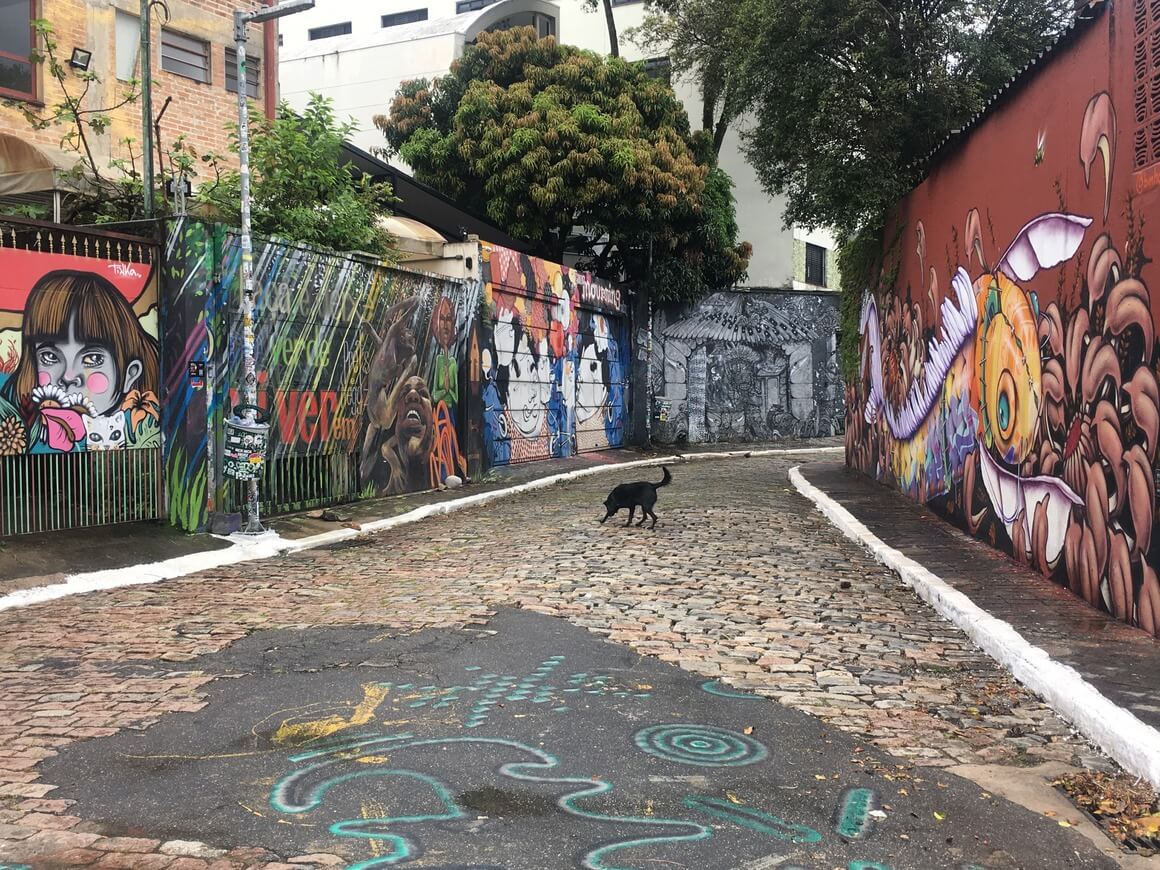
The Broke Backpacker is supported by you . Clicking through our links may earn us a small affiliate commission, and that's what allows us to keep producing free content 🙂 Learn more .
São Paulo is the same way, especially so during the day. For the most part, you’ll feel safe. Many of the locals are quite well-off (it is the business and financial hub of Brazil), and you’ll be surrounded by other travelers almost constantly.
The thing with São Paulo, though, is that it’s a gigantic city, and similar to New York, there are many different districts. The poorer ones tend to be moderate to severely unsafe, whereas the wealthier, more well-traveled areas are usually fine.
Of course, this article deals with how safe São Paul is as a whole. But here are the two most important general tips we can recommend after years of traveling around this city:
- Always be aware of which neighborhoods are the sketchy ones, and make sure you stay out of them.
- When in doubt, ask for advice from trusted locals (especially those working at your hostel or guesthouse). They can tell you more than any Google search.
Overall though, you needn’t be too concerned about visiting São Paulo .
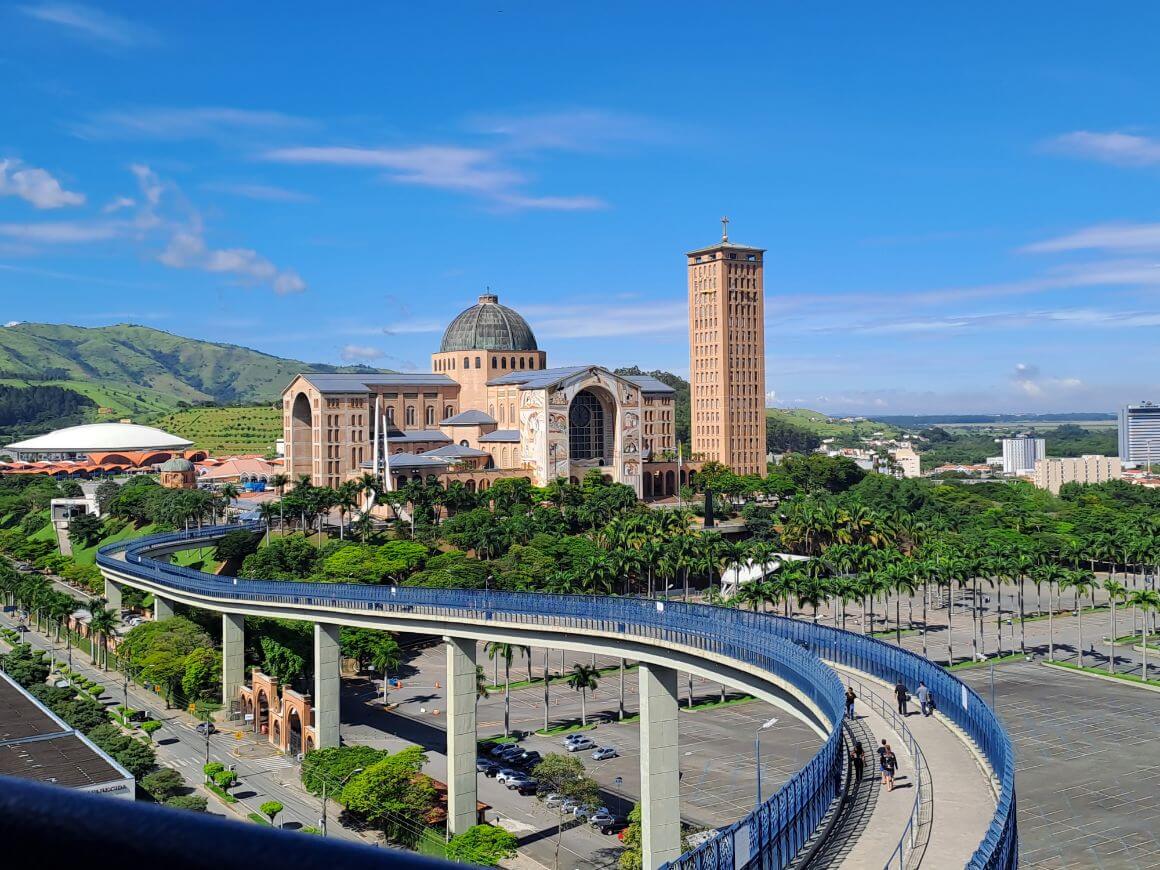
The first thing most people check when examining crime statistics is the homicide rate. What’s interesting (and encouraging!) about São Paulo is that, twenty years ago, the homicide rate was incredibly high, at around 33 per 100,000 .
Now, however, things have dramatically improved. The homicide rate has dropped to around 6 per 100,000 , which is about the same as in the United States. Additionally, Brazil as a whole is listed 130th in 2022’s Global Peace Index , just one place below the United States.
Again, however, location is everything when trying to determine whether São Paulo is safe to visit. In terms of violent crime, a good rule to remember is that one-third of the city’s districts are very safe, one-third are moderately safe, and one-third are significantly unsafe. We’ll get more into which specific neighborhoods to avoid in a later section, but always do your own research before you arrive.
The Brazilian Ministry of Tourism reports a steady yearly increase in international visitors. In 2022, the country welcomed 3.1 million tourists , a nearly 7% increase from the previous two years. If Brazil were so terribly unsafe, we probably wouldn’t be seeing so many visitors.
Yes, it is safe to visit São Paulo right now. It’s no more dangerous to visit São Paulo now than it was months or years ago. In fact, given the statistics listed above, it’s never been safer!
São Paulo’s safety is hard to judge from the safety of Brazil as a whole. This is a giant city: of course, it will still see some safety issues.
Recently, the former president of Brazil, Jair Bolsonaro, lost his re-election. An ideology known as “Bolsonarismo” has arisen since then, in support of their deposed leader. In early 2023, some of the protests turned into violent riots.
Of course, nobody wants to hear about these types of things before traveling, but if you’re staying in São Paulo you should be fine. The worst of the protests were centered around Brasília, Brazil’s capital, and even those have largely died out in the months since.
ALWAYS sort out your backpacker insurance before your trip. There’s plenty to choose from in that department, but a good place to start is Safety Wing .
They offer month-to-month payments, no lock-in contracts, and require absolutely no itineraries: that’s the exact kind of insurance long-term travellers and digital nomads need.

SafetyWing is cheap, easy, and admin-free: just sign up lickety-split so you can get back to it!
Click the button below to learn more about SafetyWing’s setup or read our insider review for the full tasty scoop.
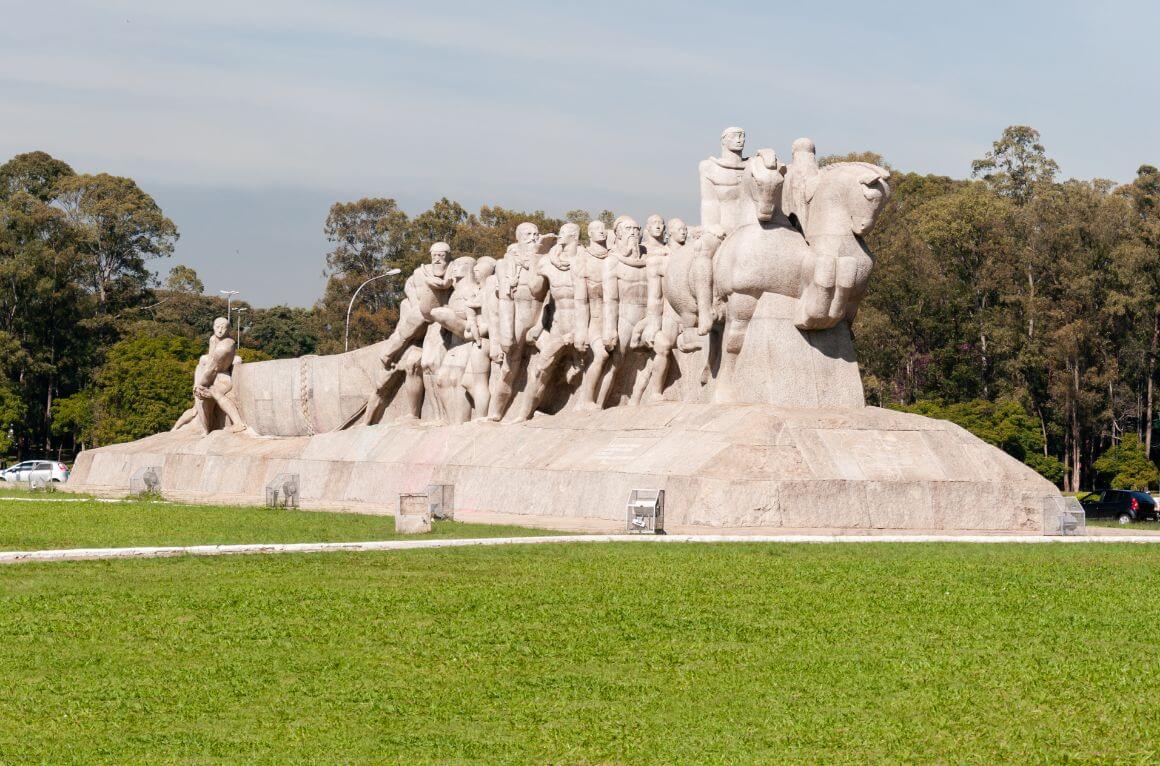
- Know the different neighborhoods – this is one of the most important tips. Avoid places like Capão Redondo, Lapa, Pari, and Campo Limpo. But do your own research before you arrive!
- Avoid the poor districts – the poorer the district, the more unsafe it is. Stay in well-traveled areas.
- Don’t walk alone at night – walking is sometimes the best way to see a city. But in São Paulo you’ll want to walk only during the day, or at least with a big group of people you can trust.
- Don’t accept free rides – if someone offers you a ride, it truly could be a kidnapping attempt. Also, never hitchhike.
- Keep your backpack in front of you – thieves have a much easier time stealing from your backpack when it’s on your back, out of your sight. You might feel like an idiot with your backpack on your stomach, but at least you’ll be a safe idiot.
- Keep your valuables out of sight – don’t carelessly let your phone or your wallet dangle out of your hands. Keep your important stuff out of sight.
- …But don’t keep them in your pockets – if you have deep front pockets, you should be fine. But if you wear shorts or put stuff in your back pockets, you’re inviting disaster.
- Only carry a small amount of cash – the best way to avoid large robberies is to carry very little worth robbing!
- Memorize the number 190 – this is the emergency police number. If something bad does happen, you’ll be relieved you can dial it quickly.
- Always lock up your backpack – it’s easy to get lazy when it’s been weeks and nothing bad has happened. Carry small padlocks for your backpack’s zippers, and when in hostels, always put your bag in a secure locker before you head out for the day.
- Be assertive when you need to be – scammers and thieves are drawn to uncertainty. If someone is exploiting the language barrier and trying to intimidate you into doing something you don’t want to do, stand up for yourself with authority.
- Brush up on your Portuguese – locals who might want to take advantage of tourists won’t consider you a tourist if you can address them in their own language.
- Don’t mess around with drugs – just don’t. Even marijuana is still penalized in Brazil, and you definitely don’t want to disappear into a São Paulo prison.
- Don’t get too drunk at night – this should be obvious, though we know it might curb some of your fun.
- Just don’t do anything stupid – The vast, vast majority of crimes in the world’s cities can be prevented by just having common sense and being aware of your surroundings.
Anywhere you go in the world, you’re going to have to worry about petty crimes like theft. And if you’re a confused-looking backpacker, discombobulated by your arrival into a brand new country, you are, as they say, “meat on the hoof.” To be honest, the problem isn’t too bad in São Paulo—at least, not any worse than what you’d expect in similar cities around the world.
As mentioned earlier though, in São Paulo it always helps to be conscious of where you are. In particular, the central Sé district is chock full of pickpockets. But no matter which district you’re in, just stay especially alert when you’re in large crowds or on public transportation, as these are the times when pickpockets usually have the most success.
ATMs are prevalent in São Paulo, so it’s worth mentioning that you shouldn’t do things like withdraw a bunch of money from a vacant street corner at 2 am—though that one should be obvious. You’ll be fine as long as you use common sense. If you’re really dedicated to keeping your money safe in São Paulo, consider buying a money belt.
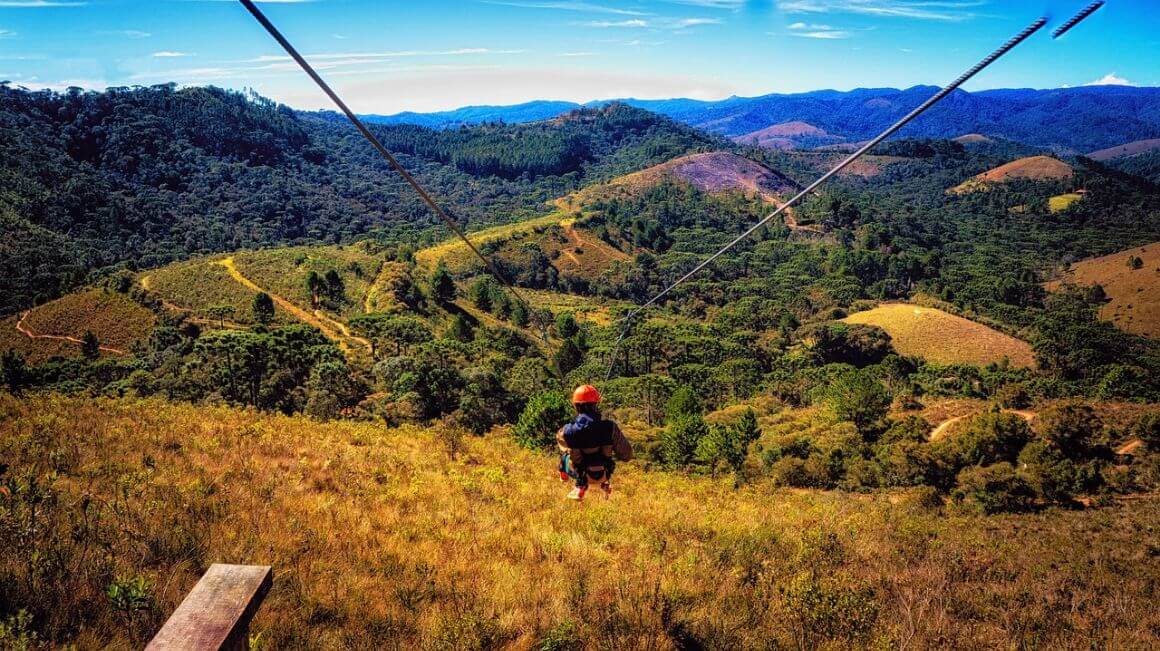
Here’s the thing about traveling alone: you’re never really alone.
Sorry, that sounds creepy. Here’s what we’re trying to say:
Unless you never leave your room and you spend your whole trip binge-watching movies, it’s impossible not to make friends on the road. Just stay at a Sao Paulo hostel or two for a few nights, and you’re bound to leave with lifelong friends from numerous continents. To be honest, it’s the best thing in the world, and one of the most fulfilling things about backpacking. So the question, “Is São Paulo safe to travel to alone?” is almost a trick question.
However, there will be times when you’re totally alone (heck, sometimes you’ll want to be!) and in these situations, it might be a good idea to tell your hostel or guesthouse where you’re going and when they should expect you to return—but that may not always be necessary. The bottom line is that being a solo traveler in São Paulo isn’t anything to worry too much about. BUT…
It’s just a fact that you’re always safer when you’re with friends . And so, in São Paulo, when you’re walking at night, drinking, or just exploring somewhere that’s a little more off the beaten path, it’s definitely a good idea to be part of a group. It’s just so much harder to take advantage of somebody if they’re surrounded by like-minded people who are looking out for their interests.
At the end of the day, you can get into sketchy situations anywhere. Just use the three pounds of neural tissue inside your cranium, and you’ll be dandy.

Stash your cash safely with this money belt. It will keep your valuables safely concealed, no matter where you go.
It looks exactly like a normal belt except for a SECRET interior pocket perfectly designed to hide a wad of cash, a passport photocopy or anything else you may wish to hide. Never get caught with your pants down again! (Unless you want to…)
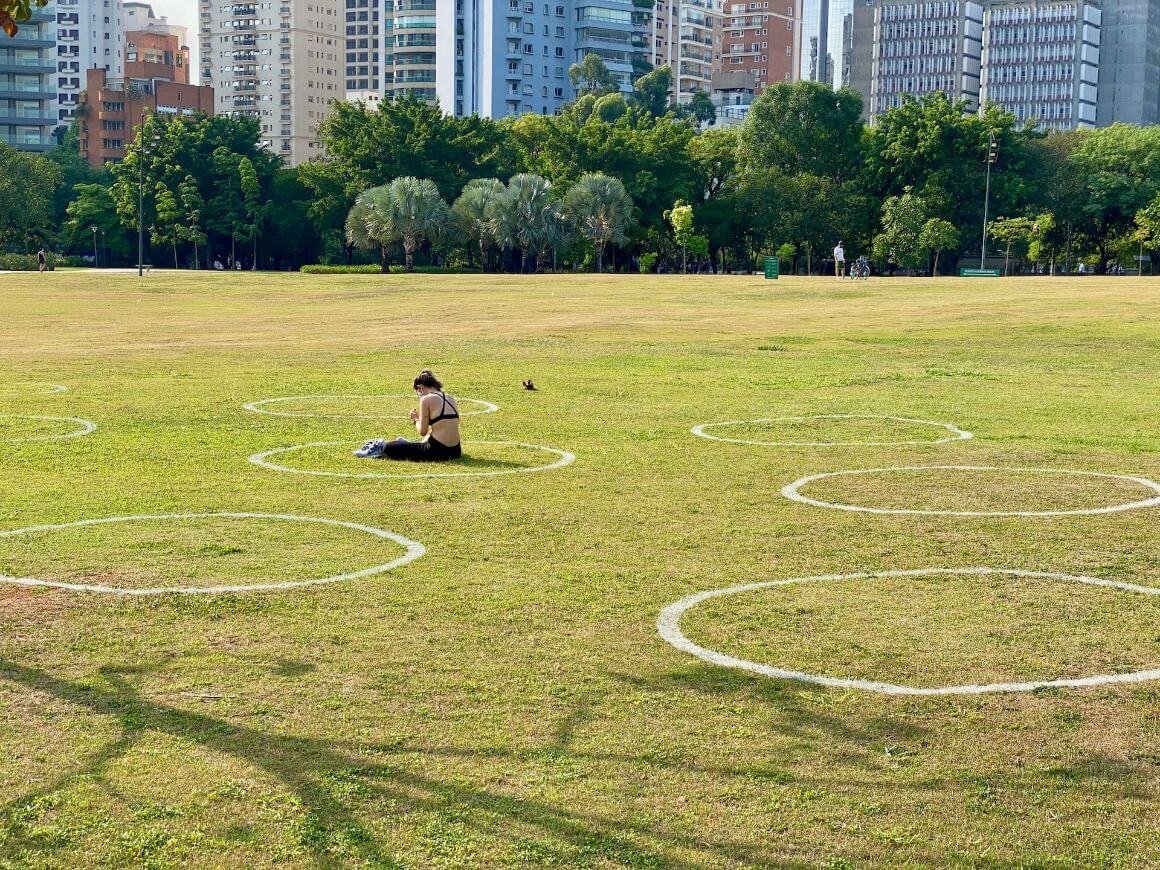
Many countries in the world have the unfortunate quality of being relatively safe and comfortable for men, but much more dangerous and threatening for women.
Thankfully, São Paulo is not one of them.
Socially speaking, Brazil is a modern country, and women possess the exact same rights as men. You won’t be thrown in prison for accidentally baring an ankle, and you won’t be constantly catcalled as you walk down the street. However, it’s always important to err on the side of caution. It’s indisputable that by and large, women are (unfortunately) more vulnerable to crimes like assault and robbery than men.
So if you’re a woman planning a solo visit São Paulo, follow the same guidelines listed in the previous section and you shouldn’t experience any real problems. You’ll need to stay alert, but you shouldn’t have to take any outlandish precautions simply because you’re a woman.
As we already said (and will say many more times throughout this article) just use common sense.

Things go wrong on the road ALL THE TIME. Be prepared for what life throws at you.
Buy an AMK Travel Medical Kit before you head out on your next adventure – don’t be daft!
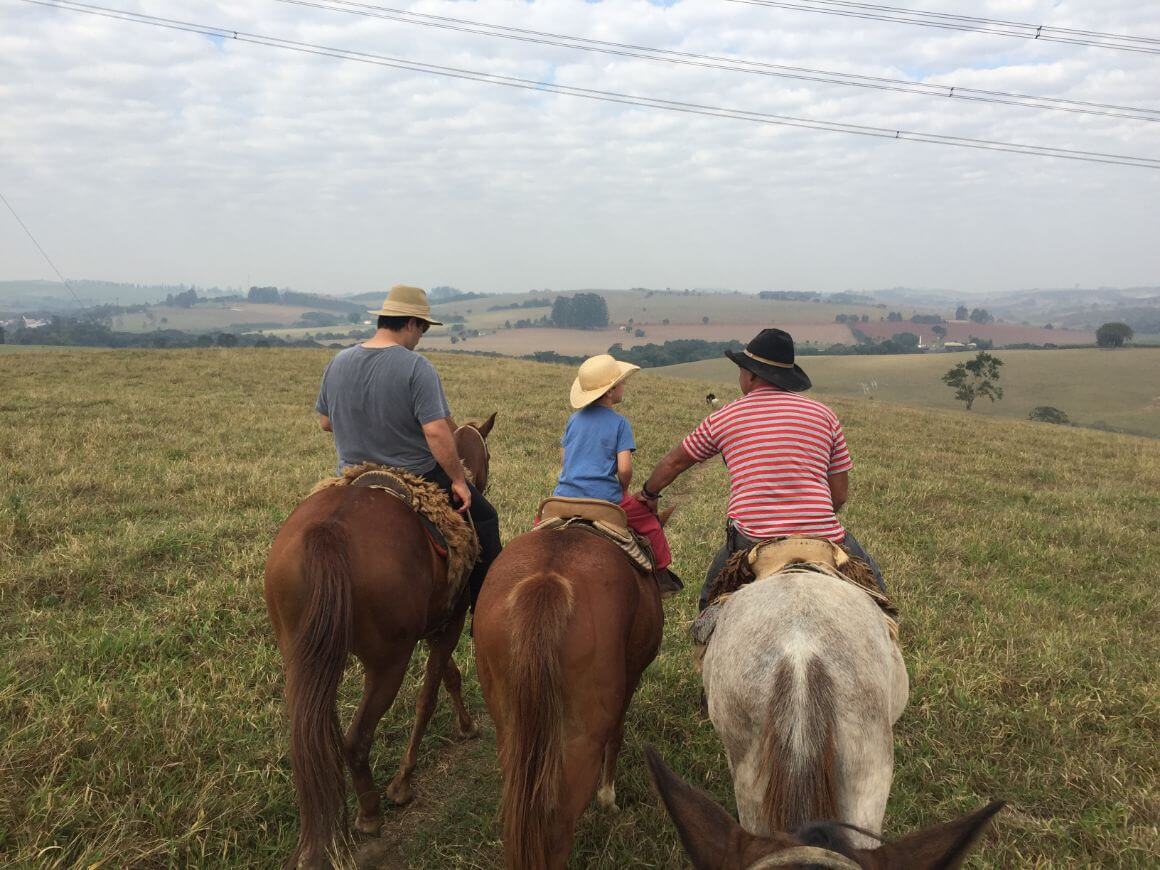
In the same way that São Paulo poses no special threats toward women, it poses no special threats toward families either.
One thing to keep in mind is that, in many aspects, tourist life in São Paulo is tailored toward backpackers. There’s a vibrant nightlife scene, plenty of bars and clubs, and so many travelers visit to experience this side of life. So if, for example, you’re worried about your kids wandering off and getting lost in rambunctious crowds, you might be hesitant. The good news is that, since São Paulo is such a huge city, there are some notable neighborhoods that are both safe and enjoyable for families.
In particular, Chácara Flora, Morumbi, and Alphaville are clean, secure, and a bit less chaotic than the city center. For both safety and personal convenience, we recommend spending time in these types of neighborhoods if you’re visiting São Paulo as a family.
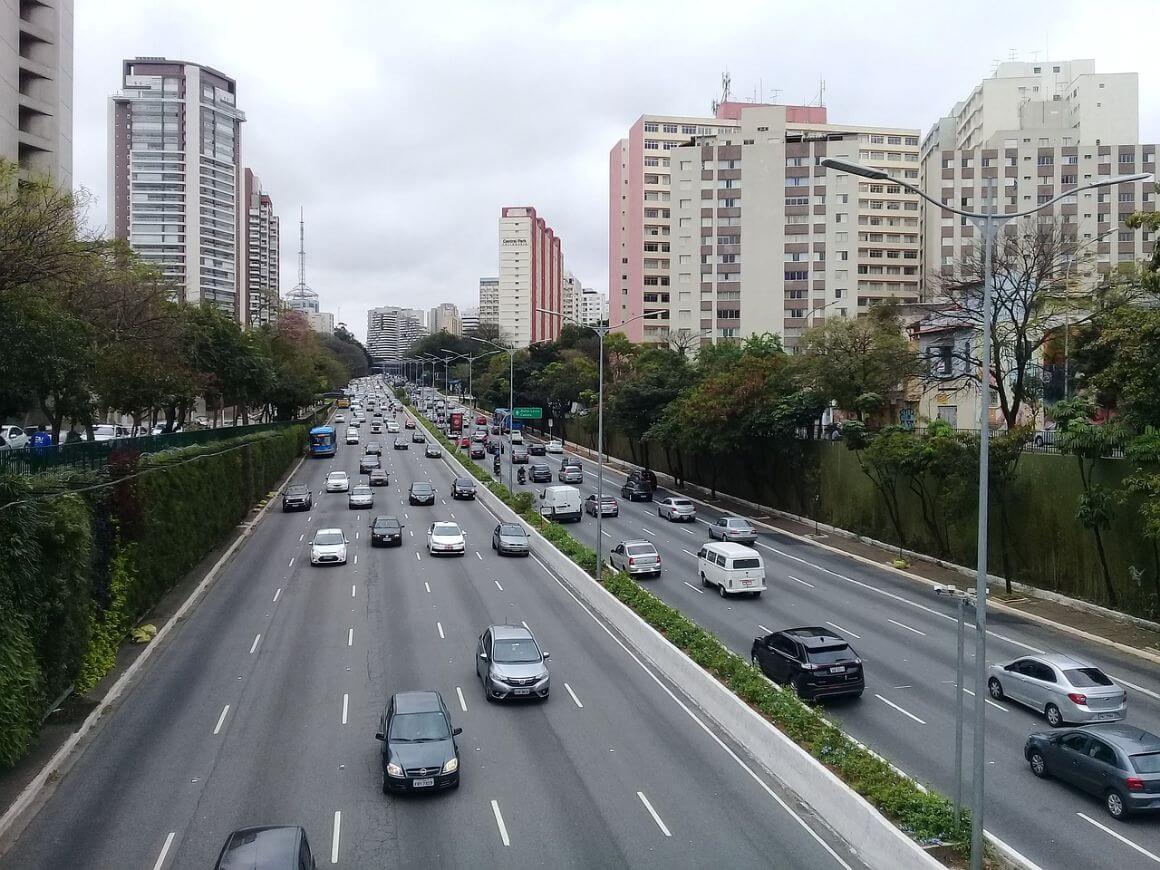
Not to be a buzzkill, but you’ll probably want to stay off the road in São Paulo. Here are the two reasons why:
- The roads are crazy. It depends on the time of day, but whether you’re in a car or on a motorbike, you can expect a cacophony of horns, reckless drivers, and some unfamiliar road rules. You’ll need an International Drivers Permit if you want to drive legally, and this is for good reason: the roads are wild. You’ll also be at risk for roadside robberies if you’re in standstill traffic cranking music with the windows down (and is there anything else to do during a traffic jam?)
- Secondly, it’s just not all that convenient. If you have the misfortune of getting caught in rush hour traffic, your “night out with the girls” plan might get pushed back by a solid three hours. In general, driving in São Paulo is stressful and inefficient.
At the end of the day, the choice is yours. The traffic fatality rate is around 10-20 per 100,000 people, which isn’t much worse than the rate in the United States. So if you’re a very experienced driver and you want to give it a shot, go for it.
Is it Safe to Cycle in São Paulo?
Riding a bicycle can be an excellent method of getting around in São Paulo. And if you do it the right way, it’s pretty safe too.
Here’s what not to do: don’t cycle on the main roads. Drivers in São Paulo can be crazy and reckless, and they’re not always likely to give you, a lowly cycler, the time of day. But São Paulo has around 250 miles of bicycle paths. Stay on these and you’ll be safe for the most part, as you’ll be most closely surrounded by other cyclists and pedestrians.
Here are some other bonuses: these bike paths can allow you to circumvent the worst of São Paulo’s traffic jams, and even some metros allow you to bring your bicycle on board if you need to get somewhere far away.
For recreational cyclists, some of São Paulo’s best routes are below:
- Maua Maluco
- Volta do Frango
- Estrada Velha Campinas
- Pelotão do Jóquei
…and many, many more. These routes are scenic, diverse, and most importantly—SAFE!
Is Uber Safe in São Paulo?
For the most part, São Paulo is a normal, modern city. As such, Uber can be a nice way to get around, as long as you’re aware of the inconveniences of rush hour traffic.
Uber in São Paulo is generally safe. As long as you hold to the normal precautions, like checking the license plate number and making sure your driver is verified and has completed past trips, you should have nothing to worry about.
Of course, there are a few bad apples everywhere. If at any point your driver makes you uncomfortable or nervous, don’t hesitate to tell them to pull over, and just exit the vehicle. It’s always better to be safe than sorry, even if it makes you feel like a paranoid loser.
And definitely don’t expect your driver to speak English—we recommend you brush up on either your Portuguese or your pantomime game.
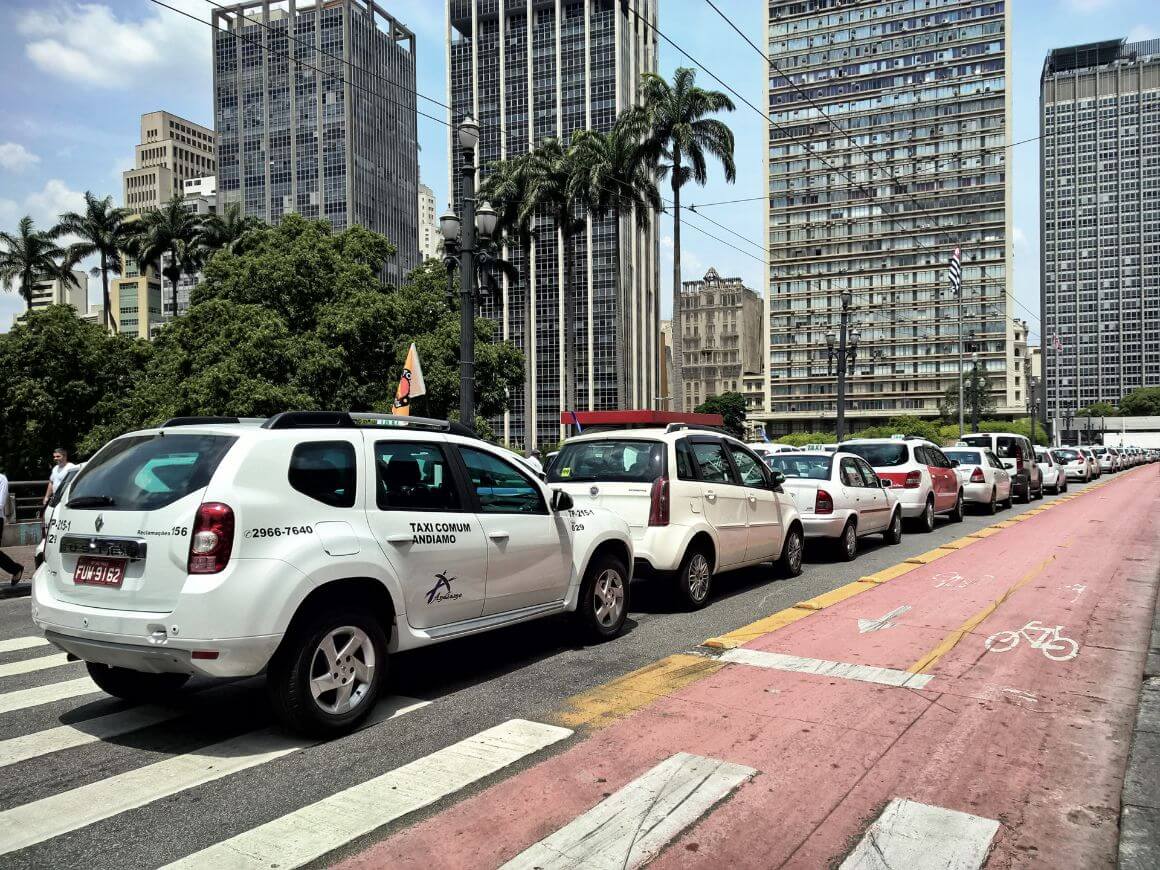
As it is with Ubers, so it is with taxis. They’re no more dangerous in São Paulo than they are anywhere else.
Here are some standard precautions you can take to avoid the occasional scammers:
- Insist they use the meter. If they refuse, take another cab.
- Make sure the meter is working properly; if your fee is increasing way too quickly, something might be afoot.
- When leaving the airport, go with the most official-looking taxi company.
And as always, if your driver makes you nervous for whatever reason, ask them to stop, and just get out. There’s no shortage of taxis in São Paulo, and if one driver charges too much or seems a little creepy, there are always countless other honest drivers at the ready who would be delighted to take you.
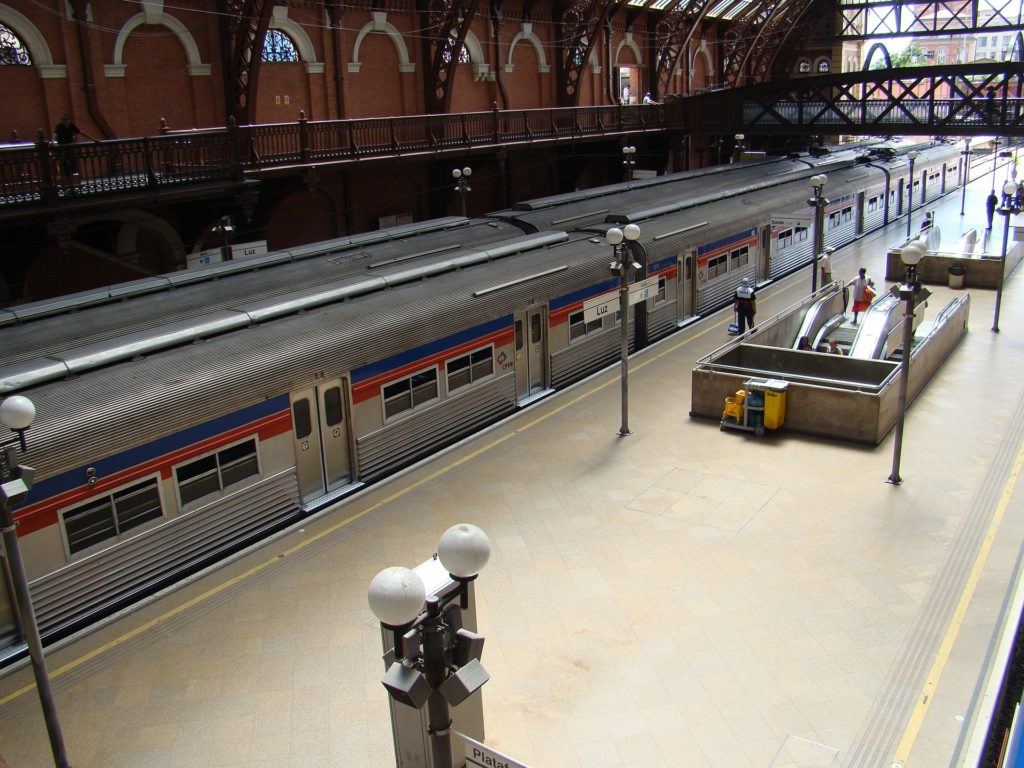
Both ex-pats and locals alike use public transportation as their preferred method of travel. The metro is by far the most efficient, as it’s not beholden to any road traffic. Both the metro and bus systems are relatively safe, but there are a few things you definitely need to keep in mind as you travel.
- In the above section, we talked about how pickpockets prefer crowds. Well, it just so happens that the metros and buses are often the most crowded places in the entire city. Pickpockets will bump into you “accidentally,” steal your wallet or phone, hop off the bus or metro, and you’ll be left rocketing off to your next stop totally oblivious.
- If you’re traveling late at night, stay extra alert at quiet bus stops and metro stations. Kidnappers and thieves alike know to hover around these places, as buses will often dump one or two passengers out into the night and drive away, unwittingly depositing a ripe target in a cloud of black exhaust fumes. Either don’t travel at night or always stay with a group.
- If you really want to feel safe, you’ll probably want to stick with Uber or taxis. Of course, those come with their own risks, but in general, there are fewer variables in terms of things that could go wrong.
Key takeaways: keep your personal belongings close and travel only during the day or with a big group, and you needn’t be too concerned about public transportation in São Paulo. A good rule is to watch the locals and see how they behave. Are they walking quickly? Are they looking around nervously? See what they do, and do likewise.
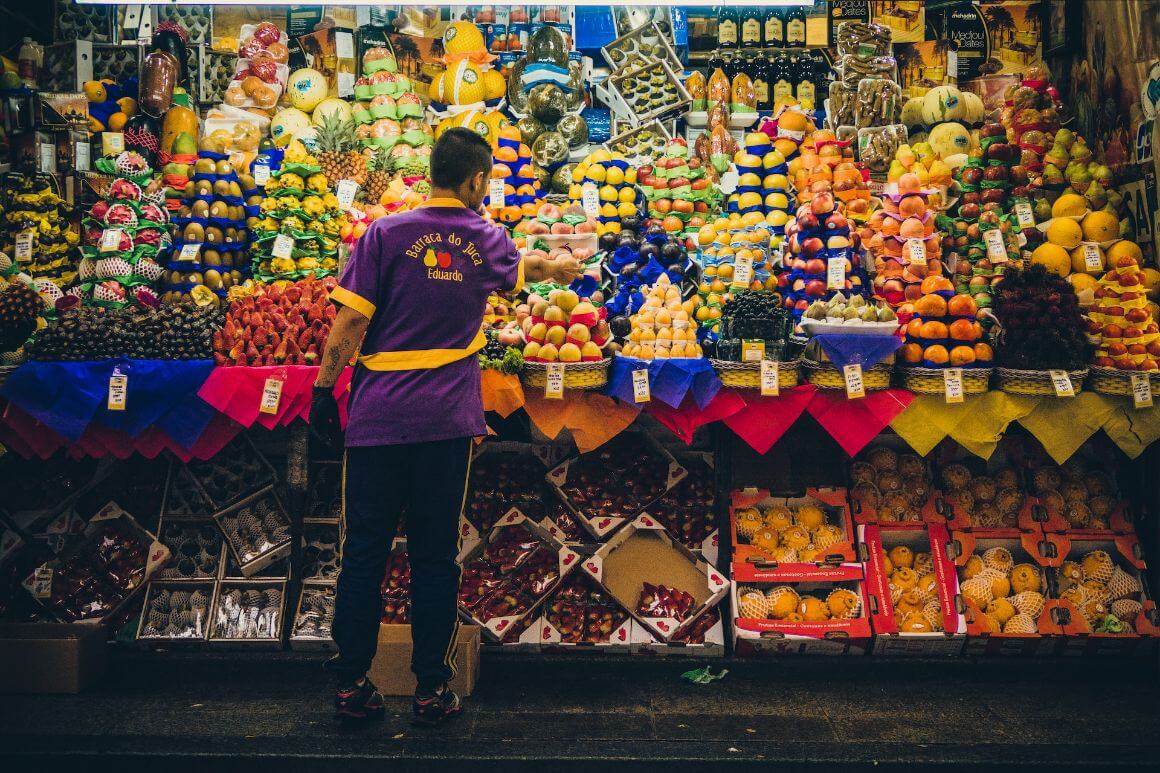
Asking, “Is the food in São Paulo safe?” is like asking, “Do the pyramids in Egypt smell good?” In other words, it’s to miss the point entirely. Not only is the food safe—it’s utterly delicious!
The cuisine is one of the most amazing things about visiting São Paulo. Besides the local Brazilian fare, it’s safe to say you’ll find the best Asian, European, and African food here as well. There’s a huge amount of fine dining restaurants, and no shortage of dirt-cheap street food stalls as well. Fried, grilled, seared, vegan—you name it, São Paulo has it.
Now, of course, there is a mandatory safety warning. And it’s kind of important. Two things you’ll want to consider are:
- No matter where you go, there is a risk of food poisoning. It’s not likely, but when possible, avoid meat that looks undercooked and spit-out food that tastes spoiled. If you do get food poisoning, there’s really no other option at first but to let it run its course. But if you continue to worsen, check yourself into a hospital.
- Health standards vary tremendously throughout the city, and the unfortunate truth is that healthy food is usually more expensive than unhealthy food. A diet of pure street food will undoubtedly take a toll on your body. Make a point to avoid constant deep-fried and sugary foods, and you’ll be in a good spot.
But yeah—in terms of your own enjoyment, you really can’t go wrong with the food here. Don’t be paranoid, just be smart, and your taste buds will thank you.
It depends on what kind of water you’re talking about.
Bottled water? Heck yeah! Tap water? Hell no.
In many cities around the world, locals are adjusted to the tap water after years of drinking it, and only foreigners have a problem with it. In São Paulo though, even many locals have filters installed in their taps to make the water more palatable. So yeah, if you were wondering about tap water, the answer is a resounding no.
What you should do is drink bottled water only, or get yourself one of these bad boys:

Drink water from ANYWHERE. The Grayl Geopress is the worlds leading filtered water bottle protecting you from all manner of waterborne nasties.
Single-use plastic bottles are a MASSIVE threat to marine life. Be a part of the solution and travel with a filter water bottle. Save money and the environment!
We’ve tested the Geopress rigorously from the icy heights of Pakistan to the tropical jungles of Bali, and can confirm: it’s the best water bottle you’ll ever buy!
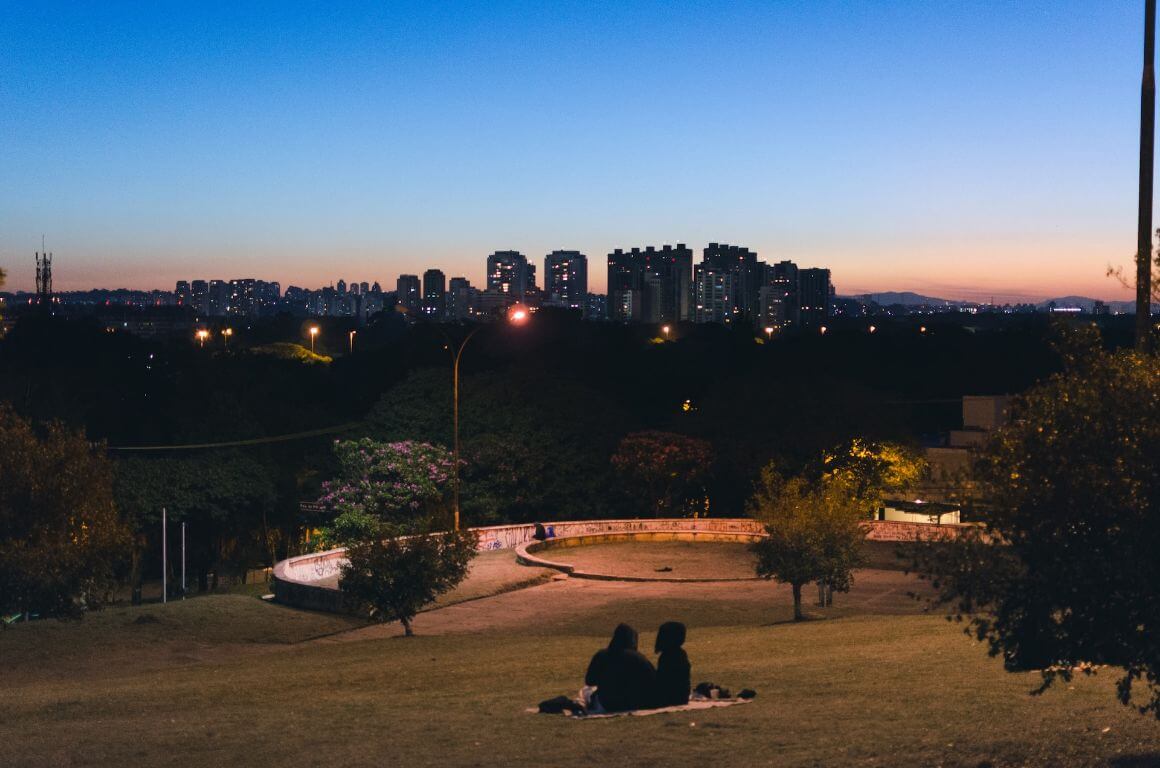
São Paulo is an excellent place to live, especially if you’re a digital nomad . Internet cafés abound, and since the city is the center of business in Brazil, you’ll be surrounded by like-minded people.
As long as you follow the tips laid out in this article, living in São Paulo isn’t any more sketchy than traveling through it. You’ll definitely want to find an apartment in a good neighborhood like Morumbi, Chácara Flora, Santa Cecília, or Brooklyn Novo. Avoid neighborhoods like Capão Redondo, Lapa, Pari, and Campo Limpo.
The visa process can be a little confusing, but once you’re settled, life in the right São Paulo neighborhood can be cheap and quite charming!

A new country, a new contract, a new piece of plastic – booooring. Instead, buy an eSIM !
Jetpac eSIMs work just like an app: you download it, pick your plan, and BOOM! You’re connected the minute you land. It’s that easy.
Read about how e-Sims work or click below to see one of the top eSIM providers on the market and ditch the plastic .
Healthcare in São Paulo is really bad. It’s also really good! How is that possible?
Brazil is one of the many countries that offer totally free healthcare for residents. But as you probably know, when something sounds too good to be true, it usually is. What’s the trade-off here?
The public healthcare system is a little… backward. The technology in the hospitals is usually outdated, there’s a severe language barrier, and the overall quality of care is lacking. Most ex-pats who live here decide to pay for health insurance and use private care.
That being said, if you need a few stitches or if you have a minor case of food poisoning, a public hospital should do the job just fine. Anything more major, however, and you’ll probably want to be a bit safer and pay the extra premiums at a high-quality private facility.
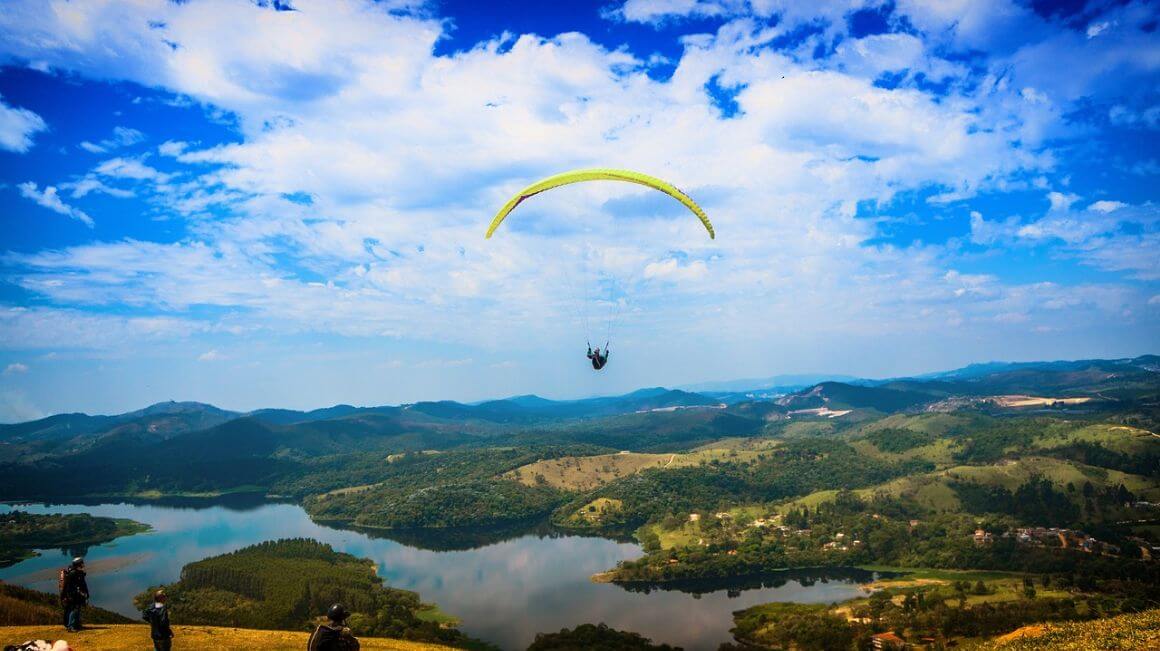
São Paulo is a charmingly chaotic city with so much going for it. Though it has earned itself a bad reputation for safety in the past, the statistics undeniably show significant improvements throughout the last few decades.
By and large, you have nothing crazy to worry about. As we mentioned in the beginning, the most important things you can do are be aware of which neighborhoods are safe (and which aren’t!) and when in doubt, ask trusted locals for advice.
With a little bit of common sense, you’ll have a heck of a trip.
Buy Us a Coffee !
A couple of you lovely readers suggested we set up a tip jar for direct support as an alternative to booking through our links. So we created one!
You can now buy The Broke Backpacker a coffee . If you like and use our content to plan your trips, it’s a much appreciated way to show appreciation 🙂

Claire Sturzaker
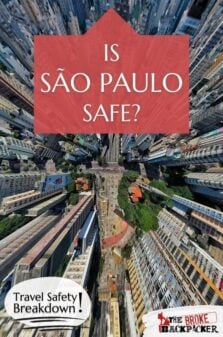
Share or save this post

The cuisine is one of the most amazing things about visiting São Paulo. Besides the local Brazilian fare, it’s safe to say you’ll find the best Asian, European, and African food here as well
Leave a Reply Cancel reply
Your email address will not be published. Required fields are marked *
Save my name, email, and website in this browser for the next time I comment.
Notify me of followup comments via e-mail.

21 Jul 21 Dos and Don’ts to Travel Safe in Brazil

When I mention that I traveled to Brazil (majority of the time alone) one of the first questions I always get is, “Is Brazil safe to travel to?” Or more specifically, did I feel safe as a solo female traveler in Brazil. Both are fair questions, and my answer is…it’s complicated.
In short, yes, Brazil is safe enough to travel to – but read my more in-depth response here . My personal experience is that I had no negative incidents involving safety or theft while in Brazil and I loved the country so much I stayed for 3 months and would go back in a heartbeat. However , I simultaneously know many tourists who were victims of theft in Rio de Janeiro especially.
You could call me lucky that nothing happened to me, which is fair because sometimes things just happen. But I was also extremely cautious and extremely aware. Specifically, I followed the tips mentioned in this blog post and I think that made a huge difference.
So if you’re traveling to Brazil, here are 21 dos and don’ts to stay safe:
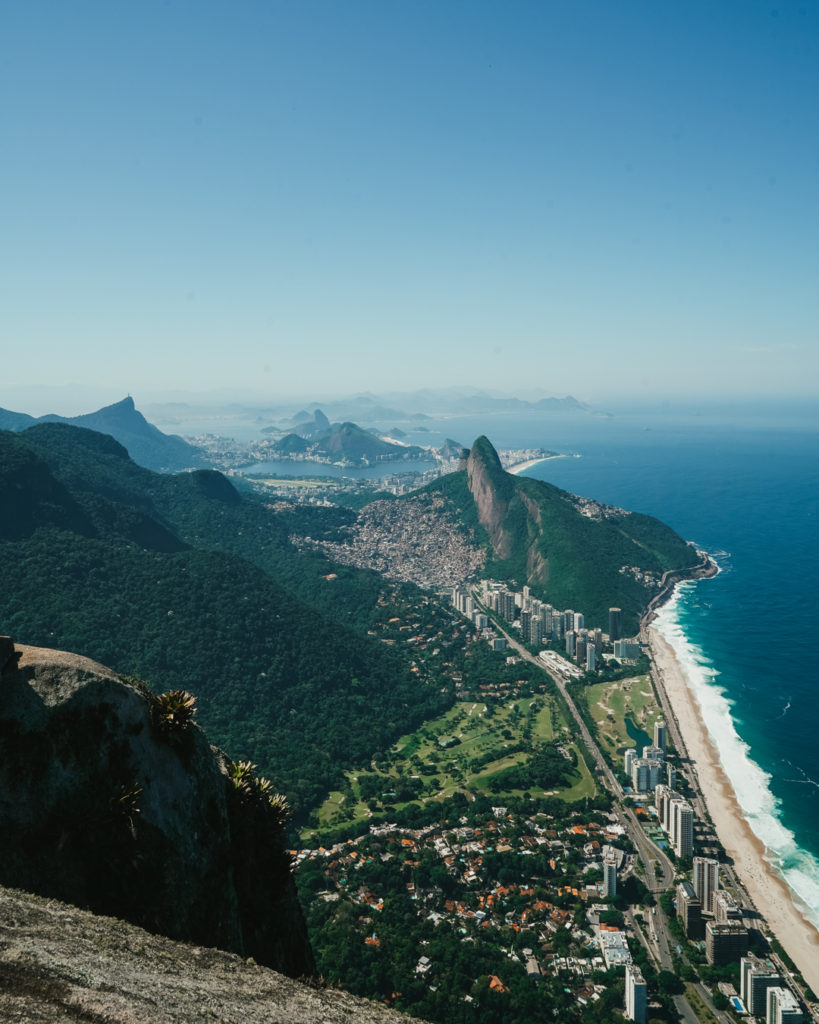
*This post includes affiliate links and I may receive a small commission at no additional cost to you. By using my links you’re merely supporting what I love to do: write this blog! I only recommend products/companies that I use myself.
1. pull your phone out on the street
Walking around with your phone out is really the worst possible thing you could do – especially in Rio. No matter how hard you grip that phone, there’s a decent chance someone will swipe it even in broad daylight. If you must look at your phone (for example directions or ordering an Uber), I recommend stepping into a shop. If that’s not possible, step away from walking traffic and look around before pulling it out quickly. If you’d like to take a photo, consider if it’s a smart move and be conscious of people walking by.
This is by far the most important tip on this list. I think we’re so accustomed to pulling out our phones constantly to scroll through social media or just walking with our phone in hand. But in Brazil I strongly discourage you from doing this.
2. Don't walk alone at night
Walking alone at night makes you an easy target, especially in places like Copacabana in Rio, so try to avoid it at all costs.
During the day, it’s obviously okay to walk alone, but it’s good practice to be mindful of your surroundings and the area you’re in. I wouldn’t recommend walking near a favela alone and suggest staying in more populated areas.
3. don't Put valuables in your pockets
If you’re in the habit of putting valuables in your pockets – break it! This is an easy way to be pick-pocketed. Instead I highly recommend having a cross- body sling. A standard sling like this one works, but for safety I most recommend the PacSafe sling which is an excellent investment if you travel often or live in a city.
4. don't wear showy items like gold jewelry
Flashy items make you a target in Brazil. Personally I love gold jewelry, but even though all of mine is fake, wearing it would make me a target. Studs and small hoop earrings should be fine, but necklaces and bracelets I would refrain from wearing – as recommended to me by local Brazilians.
5. don't leave your valuables unattended to
Never leave your valuables unattended to in Brazil. This includes at coffee shops where you may have your laptop or iPad out while going to the bathroom. It’s not to say that the people around you are bad or won’t watch your things when you ask, because they will. But usually when we ask someone, “Hey can you watch my stuff?” we don’t actually believe someone is going to come and swipe our stuff while you’re gone and the person watching your things will actually need to run after them… However, in some places of Brazil this can totally happen. Especially if you’re sitting near a window near the street. I knew of a girl who lost her iPad this way..so just don’t do it.
6. don't use the metro at night
The metro in Sao Paulo and Rio de Janeiro are great. I took the metro in Rio many times and it was cheap, safe, and clean. However, I wouldn’t recommend it in two scenarios: at night and with a laptop or camera. Otherwise I actually recommend it during the day especially if you’re on a tight budget.
Now that you know what not to do to stay safe in Brazil while traveling, let’s jump into what you should do.

Also read: The Ultimate List of things to do in Rio de Janeiro
7. pack a theft-safe cross body bag.
A lot of pick-pocketing happens when someone’s wallet or phone is in their pocket or open bag. Do yourself a favor, and get yourself a sling, cross body bag so that your valuables are always zipped away and close to your chest.
My favorite cross-body slings are from Pac-Safe . They’re RFID blocking, have theft-proof zippers, and cut-proof straps. They check all my boxes for a safe cross-body travel sling including having inside zipper compartments and a clip in the front vs. in the back.
But if you’re looking for a cheaper option, I suggest this highly-rated one on Amazon .

8. Be cautious of your valuables while sunbathing on the beach in Rio
The beaches in Rio are stunning, but while sunbathing be wary of your belongings. I recommend keeping everything in your bag (i.e don’t leave your phone or kindle out on the towel) and have your bag secured somewhere. Personally, when I would close my eyes I put the strap around my arm so my bag could not be grabbed in passing.
If you go to the beach alone (which I did often) also don’t leave your valuables unattended when you swim. I use a waterproof fanny pack or you can ask someone to watch your things if you feel comfortable doing so.

9. leave one bank card in your suitcase
When you go out, it’s best not to bring all your bank cards in case, god forbid, your wallet is stolen. I always leave my debit and credit cards locked at my place and take only one travel credit card. The Chase Sapphire Preferred is my go-to.
Read more about why I recommend the Chase Sapphire Preferred card here.
Note: this tip is good practice always when you travel, not just in Brazil.

10. Use Uber if possible
Uber is a really convenient way to get around, and for safety reasons I love it because you have more control as the passenger: you have a set price, the information of the driver, and you can share your trip for added security. Uber is available in the major cities of Brazil, so if it makes you feel safer, use it.
11. Leave your passport in a safe place, and bring copies to the country
Whenever you go somewhere (unless it’s required or needed) it’s best to not walk around with your passport in your day bag, just in case you lose it. But in the worst case scenario that you do, it’s also good to travel with printed copies in your suitcase if you needed to go to your embassy for a lost passport.
12. Bring minimal stuff when you go out to party
Now that I’ve mentioned to leave your passport and any unnecessary cards locked at your place, make sure you DEFINITELY do this when you go out to party in Brazil. This is when many people are pickpocketed because they’re drunk or high and less mindful. I know some people who even use burner or their old phones when partying in “high-risk” destinations like Rio or Salvador during Carnaval. Not a terrible idea if you have an extra or old phone.
13. Try not to stand out as a tourist too much
Being a tourist is not a bad thing and to be honest, even if you try not to stand out, you probably still will. And that’s okay! It’s more about not standing out too much and making yourself a massive target for pick pocketing. So don’t wear flashy items, be protective of your phone and camera, and maybe switch your “I Love Rio” shirt for a Flamengo jersey (Flamengo is a local and very popular team in Rio de Janeiro).
14. Practice extra caution in heavily touristic areas
Touristic areas of every destination always have a downside…they seem to attract the most sketchy characters. This is the same for Brazil. For example, in Rio you should practice extra caution in Copacabana, Lapa and other touristic places.
15. Be mindful of your things at an outdoor restaurant
When seated at an outdoor restaurant (which will happen often because Brazil loves al fresco dining), again be mindful of your things. Don’t plop your phone on the table and swing your purse over the back of your chair which faces the street. This behavior may be a habit to you, but like all the other tips in this list – think about your valuables and make sure they’re secured and can’t be swiped.
16. Avoid deserted areas
In general, it’s best to stay away from deserted areas. When you’re alone there’s no one to help so it’s always best to stay where others are too.
17. Double check the area of your accommodation before booking
Before booking your stay, it’s always good practice to do a little research on the area and read reviews from other travelers with location safety in mind.
18. Party safely
Partying in Brazil is not only a must, but a difficult thing to avoid. And as someone who was there for two Carnavals, I full heartedly support this! Just make sure you party safely by:
- Going out with people you trust
- Leaving any unnecessary valuables locked at your stay
- Keeping everything in a zipped sling
- Being mindful of how much you drink
- Having a plan how to get home
- Don’t do random drugs off the street
- Don’t ever leave your drink unattended and then drink it
- Don’t accept a drink you didn’t see poured
You’re an adult, you know the drill.
19. Use lockers and padlocks for your belongings
If you’re staying in a hostel this is always a must for your valuables. I recommend using this padlock which works for both lockers and your luggage and is TSA approved.
If you’re staying in an Airbnb or hotel, for some peace of mind you should also lock your things in the safe if available.
None of this is specific to Brazil, it’s just standard practice. Theft from your accommodation isn’t common for tourists in Brazil, although there are wild stories around Carnaval time when the country is full of tourists, so best to be cautious.

20. Be careful when you withdraw money
Like many destinations, in Brazil you should always be careful when withdrawing cash. I recommend only doing so during daylight hours, going with a friend if you can, and trying to find an ATM located indoors. As a standard practice (since seeing those ATM scamming videos) I also always tug on the card reader first and only go to an ATM when I see someone else go before me. That way if it’s going to eat a card, it won’t be mine!
After withdrawing money, make sure you have plans to return to your place immediately so you’re not walking around with loads of cash on you.
21. Make sure you're covered with Travel insurance
Travel insurance is a must for every trip, but especially for a destination like Brazil where you may be engaging in adventurous activities, have a lot of reservations, and you’re at risk for theft as mentioned in this post.
So do yourself a favor and make sure you’re covered! No one wants to think about unfortunate scenarios like robbery, delays, cancellations, injury or sickness happening while traveling, but they do and almost every traveler can attest to a time when travel insurance really saved them.
Check out World Nomads travel insurance here which is made for backpackers.
*Disclosure: World Nomads provides travel insurance for travelers in over 100 countries. As an affiliate, I receive a fee when you get a quote from World Nomads using this link. I do not represent World Nomads. This is information only and not a recommendation to buy travel insurance.
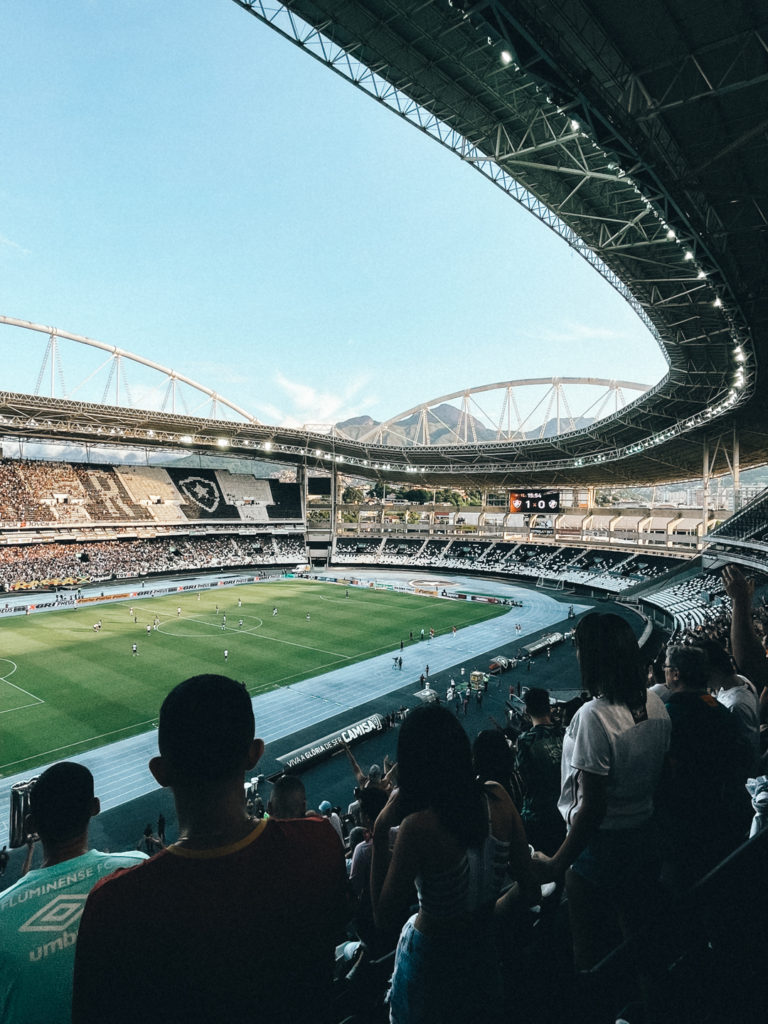
I’ve mentioned a lot in this blog post, but all of it will prove useful to staying safe in Brazil. Overall, I hope I didn’t scare any readers; I think Brazil is a wildly amazing place and one of my all-time favorite travel destinations. Just stay aware, stay safe and you’ll have a smooth and wonderful trip.
Also read: The Ultimate List of Things to Do in Rio
More resources for your trip to brazil:.
Planning your own trip? Here’s everything I used to book and coordinate my itinerary through Brazil.
If you’re a budget traveler or looking for an easy way to meet others, Hostelworld is the best place to search.
Booking.com has so many options in Brazil from affordable to more luxurious stays.
Flights to Brazil and within Brazil can be pricey if not booked ahead of time. To get the best prices I recommend using Skyscanner . The cheapest airport to fly into will most likely be São Paulo, but if visiting Rio de Janeiro it’s worth it to fly directly there.
No matter the destination, I always check Rome2Rio to see options on how to travel. However I found using Brazilian bus companies to book could be a pain because you need a CPF often. The most useful sites to me were BusBud & FlixBus .
Travel insurance is a must for every trip, and I highly recommend it for Brazil. My go to is always WorldNomads which is made for backpackers. You can search for coverage here .
Tours & Experiences
There’s a lot of free thing to do in Rio but joining a tour does have its advantages, and if you’re a solo traveler looking to meet people then tours are a great option. In Rio you can find awesome experiences on GetYourGuide , Viator , & Airbnb Experiences (hit or miss but mostly good).
Liked this post? Pin it!
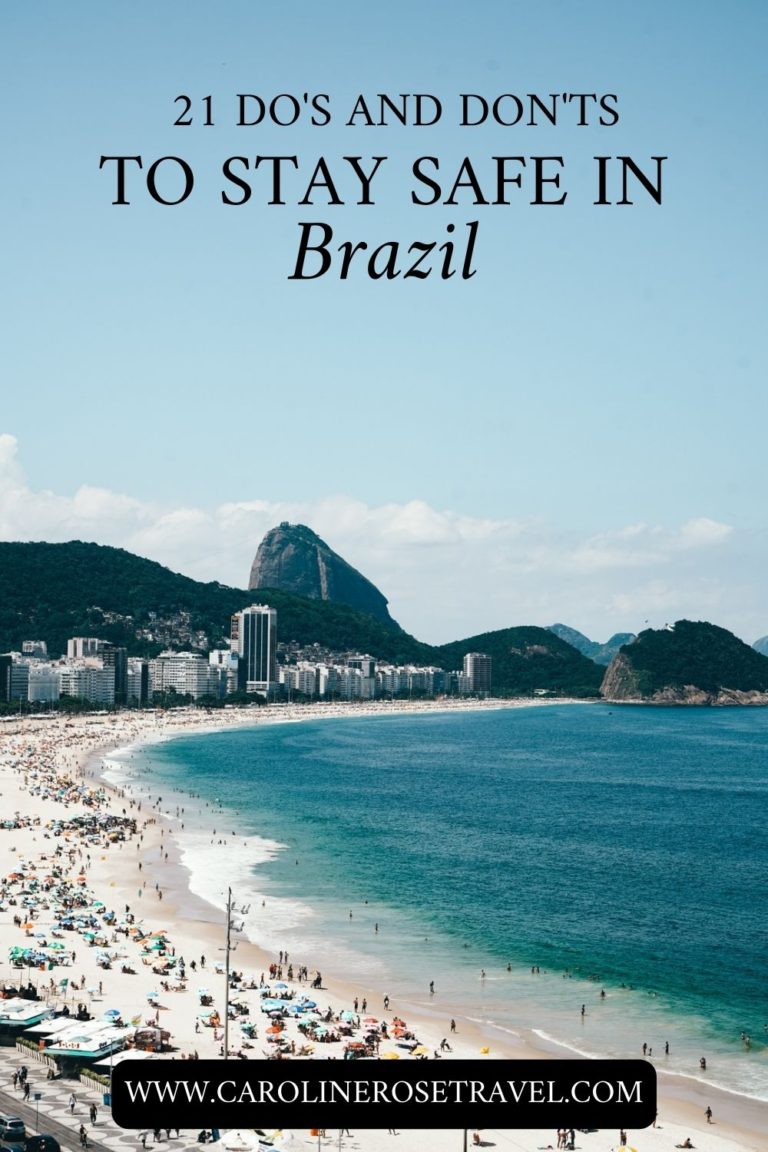
Related posts

Carnival Rio de Janeiro 2024: Your Guide to the World’s Largest Party
Carnaval in Rio de Janeiro is one of the world’s biggest parties! Brazilians in costumes dance in th...

21 Dos and Don’ts to Travel Safe in Brazil
When I mention that I traveled to Brazil (majority of the time alone) one of the first questions I a...
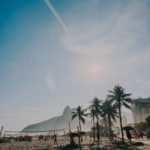
The Ultimate List of Things to Do in Rio de Janeiro
Rio de Janeiro is one of the most amazing cities to visit in the world. It’s one of the few......
Bea Adventurous
I’ve heard a rio can be bad with theft so these tips are really helpful so thank you! I definitely think it shouldn’t deter anyone from visiting but to take these precautions for sure! Thanks Caroline!
Caroline Rose
You’re welcome!! So glad you found these helpful. Have the best time in Brazil!
Mary Candler
Thanks for your information about Brazil. I am hoping to go to Rio to volunteer as a English teacher for 3 weeks then head to Minas Gerais to see a friend. Any specific comments for a 70 Yr old who doesn’t take too many risks and has done a fair amount of solo travelling. I’ll be staying in medium hotels when not in the volunteer programme.
Hi Mary! I don’t have any specific safety recommendations other than what I’ve listed here. As for things to do, there are some really great tours I think you’d enjoy like to Christ the Redeemer and Sugar loaf mountain. Also check out the botanical garden, it’s beautiful! I have a full list of things to do in this blog post!
David Young
So how do you take photos? I love taking photos with my phone when I’m traveling. It sounds like that would be risky at most outdoor locations in Brazil. Also how was intercity travel? Did you take buses or fly? I know not to take the bus at nighttime, but I wonder if there are other precautions advised. Thank you.
Save my name, email, and website in this browser for the next time I comment.
Subscribe me to Caroline Rose Travel
This site uses Akismet to reduce spam. Learn how your comment data is processed .

- Search Please fill out this field.
- Newsletters
- Destinations
- Central & South America
Your Trip to Sao Paulo: The Complete Guide
- Best Time to Visit
- Weather & Climate
- Guarulhos International Airport Guide
- Public Transportation
- Best Hotels
- Top Things to Do
- Coolest Attractions
- Best Museums
- Where to Shop
- Sao Paulo's Architecture
- Food to Try
- Best Restaurants
- Nightlife Guide
On the Brazilian landscape, one city stands above the rest in gastronomy, shopping, nightlife, street art, and museum offerings: Sao Paulo. Here foodies come to try all the flavors of the regions of Brazil, dishes of its diasporas, and experimental projects by Michelin-starred chefs. Over 50 shopping malls, the most famous high fashion street in South America, and 60 specialized shopping streets for everything from electronics to wedding dresses draw enthusiastic buyers to its stores every day. Paulistinos (the city’s residents) party literally until dawn in its baladas (dance bars) and along the Baixo Augusta. During the day, world-famous museums like the Museu de Arte de Sao Paulo opens its doors, while cultural centers like the SESC Pompéia offer free activities for residents and tourists alike. Stroll through the graffiti art of Beco do Batman or see Niemeyer’s massive Modernist building Edifício Copan. Everything can be found here, except a beach, but even those aren't too far away.
Planning Your Trip
- Best Time to Visit : Come to Sao Paulo in the spring (September to November). During this shoulder season, days are long, nights are cool, and the city hosts weeks-long events focused on food, art, and entertainment.
- Language: Portuguese
- Currency: Brazilian real
- Getting Around : The Metro, Sao Paulo’s public transit system, will be the easiest and one of the cheapest ways to travel throughout the city; download the Moovit app for simple navigation in English. Avoid renting a car as traffic can be horrendous—especially for those not familiar with the roads. Instead, take an Uber or taxi, both of which are plentiful.
- Travel Tip: Most businesses accept credit and debit cards. Except for buying tickets to ride the Metro and in certain markets, you won’t need cash unless you prefer using it over your card.
TripSavvy / Jamie Ditaranto
Things to Do
Sao Paulo has bangin’ nightlife, world-class shopping and museums, and live music throughout its streets. See art and learn the history of Brazil, soccer, and the Portuguese language in the city's museums, or cozy up with a good read in one of its many bookstores. Behold the structures of Modernist architects like the massive Edifício Copan and drum-factory-turned-cultural center SESC Pompéia, or walk down Paulista Avenue on a Sunday afternoon when it becomes a giant pedestrian thoroughfare. Sao Paulo has the largest city helicopter fleet in the world, so hire a chopper for an aerial view.
- Wander Mercado Municipal sampling mangosteen, persimmon, dragon fruit, and other exotic produce from its 300 stalls. (Samples are free with no obligation to buy.) Afterwards, climb the stairs to the restaurant portion of the market and order a mortadella sandwich.
- Spend the day at Ibirapuera Park museum hopping between the Afro Brasil Museum , Museum of Modern Art , and Museum of Contemporary Art . Walk along the park paths, rent a bike, or sunbathe with Paulistinos in its extensive green fields. See buildings designed by Oscar Niemeyer, like the Oca, and visit the spaceship-shaped planetarium.
- Visit the Museu de Arte de Sao Paulo (MASP) to see the genius of architect Lina Bo Bardi and art work spanning continents and centuries. Works by Picasso and Candido Portinari hang in glass frames in an open floor plan, removing any barriers from the viewers and the art. Check out what’s happening in the pavilion beneath the museum, which acts as a meeting point for impromptu concerts, fairs, and protests.
Explore more attractions with our full-length articles on the top things to do in Sao Paulo , important places to visit in Sao Paulo , and Sao Paulo's best museums .
Where to Eat and Drink
Sao Paulo has one of the most famous (and delicious) gastronomy scenes in the world, known for both its fine dining and street food. Regional dishes from all over Brazil, from the moqueca (seafood stew) of the north to the meaty farofa-topped barreado of the south, can be found here. Bite into a warm, crunchy coxinha full of shredded chicken; pop a cheesy, chewy pão de queijo; or try a flakey pastel. Order a mini-feast of feijoada from any neighborhood restaurant on a weekend, and after you’ve slept it off, refresh your pallet with an ice-cold açai bowl. In addition to offering food from all over the world due to its strong immigrant population, the city is also home to A Casa do Porco , an experimental pork restaurant with onsite butcher shop, and D.O.M ., which highlights regional ingredients from throughout Brazil using French, Italian, and Indigenous cooking methods.
Paulistinos love a cold, creamy chopp (draft beer), especially on weekend afternoons at botecas (neighborhood bars), which are plentiful in the Vila Madelena neighborhood. For something harder, the national liquor is cachaça, a sweet spirit made from sugarcane juice and the base ingredient in another famous Brazilian beverage: the caipirinha. Most bars will have these drinks, but to check out the microbrewery scene, head to a craft beer bar like Emporio Alto dos Pinheiros , one of the pioneers of the craft beer movement in Brazil.
According to Sao Paulo Turismo S/A, the official tourism and events company of the city of Sao Paulo, the tap water is drinkable . However, it’s recommended to have filtered water instead. You can easily find mineral water at supermarkets, restaurants, coffee shops, and bars.
Explore our articles on the best restaurants in Sao Paulo , the top foods to try in Sao Paulo , and nightlife in Sao Paulo .
Where to Stay
The art-filled Vila Madelena neighborhood offers well-priced Airbnbs and hostels, colorful streets of graffiti murals, third wave coffee shops, local bars, and friendly bohemian artists. Staying along Avenida Paulista in neighborhoods like Bela Vista will give you easy access to the MASP and the city’s best nightlife strip on Baixo Augusta. Centro might be a little rough, but bursts with personality and contains historic sites like Edifício Copan, Mercado Municipal, and Cathedral Sé. Stylish and LGBTQ-friendly Higienópolis is food heaven with swanky hotels and one of the city’s best malls, all only a mile or two from Avenida Paulista. Further out, Brooklin Novo offers luxury hotels and shopping, good for business travelers wanting to relax. Pinheiros has cultural centers with fascinating free activities, art galleries, funky boutiques, and a park great for midday lounging.
Check out our recommendations of the best hotels in Sao Paulo .
Getting There
Sao Paulo’s main airport is Guarulhos International Airport (GRU) , where most international flights will land. Two other airports service the city: Viracopos Airport (VCP) in Campinas for flights in Latin America and Congonhas Airport (CGH) for domestic flights. The Tietê Bus Terminal links Sao Paulo with all major cities in Brazil via clean, comfortable, and cheap long-distance buses.
Culture and Customs
Pickpocketing is a problem in Sao Paulo, especially in crowded, touristy areas. Be aware of your belongings, especially if going to large markets or festivals. While some areas are fine to walk at night, others are not. Check with your accommodation about the safety of where you are staying, and when in doubt, this issue is easily remedied by calling an Uber. Walking during the day throughout most of the city is safe.
This is not the laid-back beach side Brazil you would find in Rio or Florianopolis. Sao Paulo is the financial center of Brazil and one of the largest cities in the world. Expect a much faster pace of life, and people letting loose at night and on the weekends after long work days. When dining out, service will generally be fast, and the tip is already included.
Money Saving Tips
- If you want quick, cheap food with lots of variety, go to a comida por quilo restaurant. Fill your plate from the buffet, then take it to the cashier to weigh it before you eat. You pay by weight rather than a set price, and it usually ends up costing the equivalent of a few dollars.
- Go to the top of Edifício Copan for free by lining up outside gate F any day at 1:30 p.m. You’ll be let in at 2 p.m. to head to the roof where you can see panoramic views of Sao Paulo.
- Take the Metro or a bus to the airport instead of an Uber or taxi. Give yourself a time cushion in case the transfers take a while.
- The 99 Taxi app is usually a little cheaper than Uber and just as reliable.
- Many of the museums like MASP and Pinoteca have free admission days. Others, like MIS and the Museu Afro Brasil, are fee all the time.
- For free, quality entertainment, go to a centro culturai (cultural center). Sao Paulo contains about 40 cultural centers showcasing exhibitions, theater, art, concerts, debates, and more.
- Check out Mamba Negra free music parties in abandoned buildings throughout the city.
- Visit outside of high season (December to March) for cheaper accommodation.
São Paulo Turismo S/A. "FAQ: What is the language that the people of São Paulo (Paulistanos) speak?"
São Paulo Turismo S/A. "Practical Guide: Currency and Exchange."
São Paulo Turismo S/A. "FAQ: Is Tap Water Drinkable?"
Related Articles
More related articles.
Get Daily Travel Tips & Deals!
By proceeding, you agree to our Privacy Policy and Terms of Use .
Tips on Sao Paulo Warnings or Dangers – Stay Safe!
Virtual Tourist
Travel Smarter! Sign up for our free newsletter.
Sao Paulo Warnings and Dangers
Sao Paulo is home to over 12 million people, and is the financial heartbeat of Brazil. Tourists are welcome, but they must be prepared to navigate the dangers of city before they arrive.
As in any city with millions of residents, crime is inevitable. When looking for a hotel, consult a travel agent and ask if the area is safe. Most neighborhoods are fine, but a few are hotbeds of drugs, prostitution, and violence, and should be avoided. While in the city, lock your passport and valuable belongings in a hotel safe or your luggage. Always keep an eye on your purse and wallet, and never leave anything unattended in a public place. The local police are a constant presence and they’ll protect you while you’re downtown, especially on the main streets. Don’t venture off into unknown neighborhoods. While violence against tourists is rare, it’s still possible if you stray too far from the city center.
Sao Paulo is a lively city. Traffic is always busy, so bring your patience. If you’re brave enough to rent a car, drive with caution. The locals are aggressive and they won’t wait for you to become familiar with the city. Public transportation is fairly easy to navigate, or you can take a cab, if you can afford the fares.
Travelers to Sao Paulo are often drawn by the nearby caves. While beautiful and a fun excursion for those who want an adventure, they can also be treacherous. More than a few tourists have fallen to their deaths in the caves. The best way to explore them is with a guide. Even the most experienced, well-equipped spelunkers find the caves challenging, so don’t take any chances.
Editor’s Note: The information contained on this page was compiled using real traveler reviews about warnings and dangers in Sao Paulo.
We hand-pick everything we recommend and select items through testing and reviews. Some products are sent to us free of charge with no incentive to offer a favorable review. We offer our unbiased opinions and do not accept compensation to review products. All items are in stock and prices are accurate at the time of publication. If you buy something through our links, we may earn a commission.
Top Fares From

Don't see a fare you like? View all flight deals from your city.
Today's top travel deals.
Brought to you by ShermansTravel
Amalfi Coast: 7-Nt, Active Family Tour...
Exodus Adventure Travels

10-Night Mediterranean Cruise From Barcelona to...
Norwegian Cruise Line

Ohio: Daily Car Rentals from Cincinnati

Trending on SmarterTravel
- Things To Do
- Entertainment
- Food Travel
- Travel Tips
- Travel News
Insider Tips: Is São Paulo Safe For Travel?
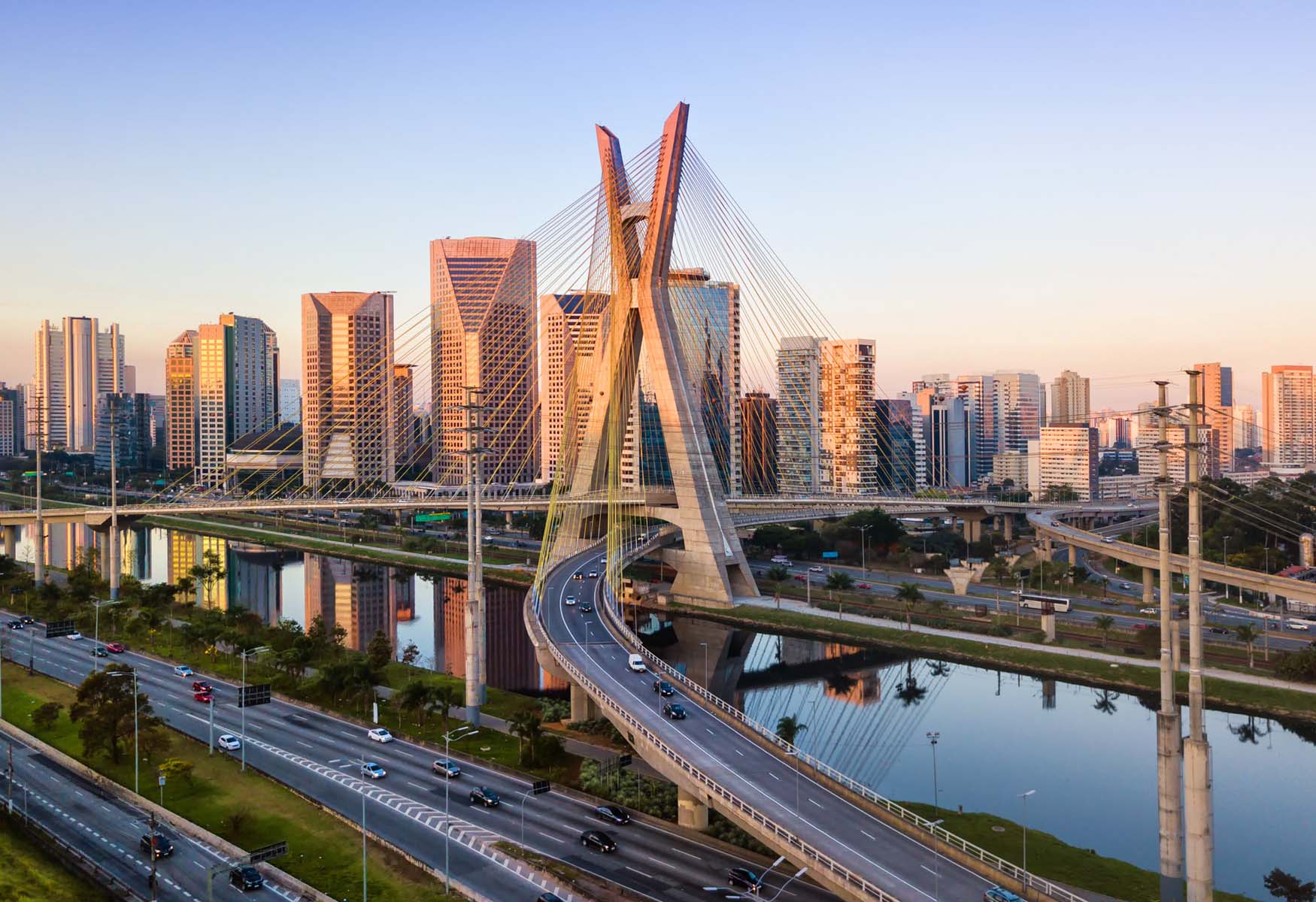
Introduction
Welcome to São Paulo, the bustling metropolis of Brazil known for its vibrant culture, delicious food, and rich history. As you plan your trip to this dynamic city, it’s essential to consider safety as a top priority. São Paulo, like any other major city, has its own set of safety concerns that travelers should be aware of. However, with the right knowledge and precautions, you can have an enjoyable and safe experience exploring all that São Paulo has to offer.
In this article, we will delve into the safety aspects of São Paulo, providing you with valuable insights and insider tips to navigate the city with confidence. From crime rates and neighborhoods to avoid, to safe areas and transportation options, we will cover it all. Additionally, we will discuss personal safety tips, health and medical precautions, and emergency contacts to ensure you are well-prepared for any situation that may arise during your visit.
Remember that while it’s important to be informed about safety, it’s equally important to approach São Paulo with an open mind and embrace the rich culture and experiences that await you. With the right mindset and preparedness, you can make the most of your time in this exciting city.
Safety Overview
When it comes to safety, São Paulo, like any other major city, has its share of concerns. It’s essential to be aware of the potential risks and take necessary precautions to ensure a safe and enjoyable visit. That being said, it’s important to note that millions of tourists visit São Paulo each year without encountering any major issues.
The city has made significant progress in recent years to improve safety measures and reduce crime rates. The local authorities have implemented various initiatives and increased police presence in popular tourist areas to enhance security. However, it’s always wise to stay vigilant and be mindful of your surroundings.
São Paulo is known for its economic disparities, which can contribute to certain safety challenges. The city’s stark contrast between affluent neighborhoods and impoverished areas means that tourists should exercise caution and avoid venturing into unfamiliar or high-crime neighborhoods.
Fortunately, with proper planning and knowledge, you can mitigate potential risks and enjoy a safe experience in São Paulo. This article will provide you with valuable information on crime rates, neighborhoods to avoid, safe areas, transportation safety, personal safety tips, health and medical precautions, and emergency contacts.
Crime Rates in São Paulo
When visiting any city, it’s crucial to have an understanding of the local crime rates to assess the safety situation. São Paulo, being a large urban center, does have a reputation for high crime rates, but it’s important to put things into perspective.
Over the years, the city has implemented various measures to combat crime, resulting in a decline in overall rates. While crimes such as theft, pickpocketing, and petty crimes can occur in tourist areas, they are generally opportunistic and can be avoided with basic precautions.
It’s also worth noting that violent crimes, such as armed robberies and assaults, are relatively rare for tourists. Most incidents of this nature happen within specific neighborhoods, often in areas with higher rates of poverty and social issues.
Like in any major city, it’s advisable to take certain precautions to minimize the risk of being a target for criminal activity. Keep valuable items such as passports, cash, and expensive electronics secured in a hotel safe and avoid displaying flashy jewelry or belongings that could attract unwanted attention.
Additionally, be cautious when withdrawing money from ATMs and try to use machines located in well-lit and crowded areas. It’s also wise to avoid walking alone late at night, especially in unfamiliar or dimly lit areas.
By staying alert, using common sense, and being aware of your surroundings, you can greatly reduce the likelihood of falling victim to petty crimes in São Paulo. It’s important to remember that the majority of visitors to the city have a safe and enjoyable experience, so with the right precautions, you can have peace of mind during your trip.
Neighborhoods to Avoid
While São Paulo has many safe and vibrant neighborhoods, there are a few areas that tourists should exercise caution and avoid. These neighborhoods have higher crime rates and are known for being more dangerous for visitors:
- Centro: The downtown area of São Paulo, known as Centro, can be crowded and chaotic, especially during rush hours. While it’s a bustling commercial district during the day, it’s advisable to be cautious in the evenings as certain parts can become less safe. Avoid dark and isolated areas, and keep a close eye on your belongings.
- Luz: Located in the central part of the city, Luz is home to the Luz Station and Luz Park. While the area has undergone revitalization in recent years, it still has a higher crime rate compared to other parts of the city. Exercise caution when visiting this neighborhood, especially after dark.
- Brás: Brás is a commercial district known for its textile industry, with many shops and markets selling clothing and fabrics. The area can be crowded, making it a potential target for pickpocketing and theft. Stay alert and be mindful of your belongings when visiting Brás.
- Pari: Pari is another neighborhood known for its textile industry and wholesale markets. While it attracts many shoppers, it’s important to remain vigilant in this area, especially during busy times. Avoid displaying valuables and keep your personal belongings secure.
- Glicério: Located near Centro, Glicério is a neighborhood with a higher crime rate. It’s advisable to avoid walking alone in this area, particularly at night. Taking a taxi or rideshare service is a safer option when navigating Glicério.
Remember, this list is not exhaustive, and it’s always a good idea to seek local advice and stay updated on safety recommendations during your visit. While it’s important to be cautious in these neighborhoods, there are many other areas in São Paulo that are safe and perfect for exploring.
Safe Neighborhoods in São Paulo
While there are neighborhoods to avoid in São Paulo, the city is also home to several safe and welcoming areas that provide a great experience for tourists. These neighborhoods are known for their lower crime rates and offer a range of attractions and amenities. Here are some of the safe neighborhoods you can consider during your visit:
- Jardins: One of the most upscale and affluent neighborhoods in São Paulo, Jardins is known for its tree-lined streets, luxury boutiques, trendy restaurants, and art galleries. It boasts a vibrant atmosphere and is considered safe for tourists. It’s a great place for shopping, dining, and experiencing São Paulo’s chic side.
- Vila Madalena: Located in the western part of the city, Vila Madalena is a trendy and bohemian neighborhood known for its vibrant street art, lively bars, and eclectic shops. It’s a popular spot for art enthusiasts, and its vibrant and welcoming atmosphere makes it safe for tourists to explore during the day and at night.
- Itaim Bibi: Situated in the southern region of São Paulo, Itaim Bibi is a thriving business and residential district. It offers upscale dining options, shopping centers, and a lively nightlife scene. With its well-maintained streets and a lower crime rate, Itaim Bibi is considered safe for tourists.
- Brooklin: As one of the wealthiest neighborhoods in São Paulo, Brooklin is known for its modern buildings, wide streets, and high-quality infrastructure. It is home to many corporate offices and luxurious condominiums. The neighborhood has a lower crime rate and offers a safe environment for visitors.
- Morumbi: Located in the southern part of the city, Morumbi is a residential neighborhood known for its upscale houses and condominiums. It is also home to the Morumbi Stadium, where you can catch a football match. With its serene atmosphere and lower crime rates, Morumbi is a safe and peaceful neighborhood for tourists.
These are just a few examples of the safe neighborhoods you can explore while in São Paulo. It’s always a good idea to research specific areas you plan to visit, talk to locals or hotel staff for recommendations, and remain aware of your surroundings to ensure a safe and enjoyable stay in the city.
Transportation Safety
When it comes to getting around São Paulo, it’s important to consider transportation safety. The city offers various options for moving around, each with its own considerations:
Public Transportation: São Paulo has an extensive public transportation system, including buses and a metro network. The metro is generally considered safe and reliable, especially during peak hours. However, it’s advisable to be cautious and keep an eye on your belongings when using public transportation, as crowded buses and stations can be attractive to pickpockets.
Taxis and Rideshares: Taxis and rideshare services like Uber and 99 are popular transportation options in São Paulo. They are generally safe and convenient, especially for traveling late at night or to unfamiliar areas. Always ensure you are using a licensed taxi or a reputable rideshare service, and confirm the driver’s identification and credentials.
Walking: While walking can be a great way to explore certain neighborhoods, it’s important to exercise caution, especially in busy and crowded areas. Stick to well-lit streets, avoid isolated alleyways, and be aware of your surroundings. It’s advisable to use pedestrian crossings when crossing the road and to stay alert for traffic.
Keep Important Contact Information: It’s a good idea to have important contact numbers saved on your phone, such as the local police (190), tourist police (147), and the contact information for your hotel or accommodation. In case of any emergencies or concerns, having these numbers readily available can be helpful.
By being aware of transportation safety measures, utilizing reliable and licensed services, and remaining vigilant during your travels, you can navigate São Paulo’s transportation system with confidence and enjoy hassle-free journeys throughout the city.
Personal Safety Tips
While São Paulo is generally a safe city for tourists, it’s always important to take personal safety precautions. Here are some tips to help ensure your safety during your visit:
- Stay Alert and Be Aware: Pay attention to your surroundings, especially in crowded areas or tourist attractions. Stay alert for any suspicious activity or individuals and trust your instincts. If something doesn’t feel right, it’s better to err on the side of caution.
- Avoid Flashing Valuables: Avoid displaying expensive jewelry, cameras, or electronic devices that could attract unnecessary attention. Keep your valuables stored securely, either in a hotel safe or hidden discreetly on your person.
- Use Reliable Transportation: Stick to licensed taxis, reputable rideshare services, or public transportation options for getting around the city. Avoid using unauthorized or unmarked taxis. If you need to call a taxi, ask your hotel or a trusted establishment to arrange it for you.
- Avoid Walking Alone at Night: It’s generally best to avoid walking alone late at night, particularly in dimly lit or unfamiliar areas. If you need to go somewhere after dark, consider taking a taxi or using rideshare services for your safety and peace of mind.
- Blend In: While exploring the city, try to blend in with the locals to avoid standing out as a tourist. Dress in casual attire and avoid displaying flashy items that could draw unnecessary attention.
- Be Cautious with Your Belongings: Keep a close eye on your belongings at all times, especially in crowded places, public transportation, or tourist attractions. Use a cross-body bag or backpack that is difficult for thieves to grab or cut open.
- Know Emergency Numbers: Save important contact numbers, such as the local police (190), tourist police (147), and the contact information of your embassy or consulate, in case of any emergencies.
By following these personal safety tips and exercising caution, you can minimize the risks and have a safe and enjoyable experience exploring São Paulo.
Health and Medical Safety
Ensuring your health and well-being is essential when traveling to São Paulo. Here are some health and medical safety tips to keep in mind during your visit:
Medical Insurance: Before traveling to São Paulo, make sure you have comprehensive medical insurance coverage. This will give you peace of mind in case of any unforeseen medical emergencies or incidents.
Stay Hydrated: São Paulo can have hot and humid weather, so it’s important to stay hydrated throughout the day. Carry a water bottle with you and drink plenty of fluids to avoid dehydration.
Food and Water Safety: While São Paulo has a thriving culinary scene, it’s important to be cautious about the food and water you consume. Stick to reputable restaurants and establishments that follow proper hygiene standards. Avoid drinking tap water and opt for bottled water instead.
Protect Against Mosquitoes: São Paulo is located in a tropical region, and mosquitoes can be present, especially during certain seasons. Protect yourself by using mosquito repellent and wearing long sleeves and pants, particularly during the evening hours.
Sun Protection: If you plan on spending time outdoors, especially during the peak sun hours, remember to wear sunscreen, sunglasses, and a hat to protect yourself from harmful UV rays.
Prescription Medications: If you require prescription medications, make sure to bring an ample supply for the duration of your trip. It’s also a good idea to carry a copy of your prescription with you in case you need to refill your medication while in São Paulo.
Seek Medical Advice: If you have any specific health concerns or need medical advice, consult with your healthcare provider before traveling to São Paulo. They can provide guidance based on your individual needs.
In the event of a medical emergency, São Paulo has a well-developed healthcare system. You can go to a hospital emergency room or contact your hotel for assistance in finding a nearby medical facility.
By following these health and medical safety tips, you can prioritize your well-being and enjoy a healthy trip to São Paulo.
Emergency Contacts and Services
Knowing the appropriate emergency contacts and services in São Paulo can help you stay prepared and address any urgent situations that may arise during your visit. Here are some important contacts to keep in mind:
Emergency Services:
- Police: Dial 190 to reach the local police in case of emergencies or to report any criminal activities.
- Tourist Police: For assistance specifically aimed at tourists, you can contact the Tourist Police by dialing 147.
- Ambulance: In case of a medical emergency, dial 192 to request an ambulance for immediate assistance.
Embassies and Consulates:
If you are a foreign visitor and require assistance from your embassy or consulate, make a note of the contact information, including the address and phone number. Here are the contacts for a few popular embassies in São Paulo:
- United States Embassy: Phone: +55 11 3250-5000
- United Kingdom Embassy: Phone: +55 11 3094-2700
- Canadian Embassy: Phone: +55 11 5509-4343
- Australian Embassy: Phone: +55 21 3234-5700
- Embassy of New Zealand: Phone: +55 61 3248-9900
Travel Insurance Provider:
If you have travel insurance, keep the contact details of your insurance provider easily accessible. This will allow you to reach out to them in case of any medical emergencies, trip disruptions, or other insurance-related incidents.
It’s also a good idea to inform a trusted person, such as a family member or friend, about your travel plans and provide them with your contact information. This way, they can be contacted in case of any emergencies.
By being aware of these emergency contacts and services, you can have peace of mind knowing that help is just a phone call away if you ever find yourself in need of assistance during your time in São Paulo.
As you plan your journey to São Paulo, it’s important to be aware of safety guidelines and take necessary precautions to ensure a secure and enjoyable trip. São Paulo, like any bustling city, has its own safety considerations that visitors should keep in mind. However, with proper planning, common-sense precautions, and an awareness of your surroundings, you can navigate the city confidently and make the most of your experience.
By understanding the local crime rates, knowing which neighborhoods to avoid, and opting for safe areas to explore, you can minimize potential risks. Utilizing reliable means of transportation, such as licensed taxis or rideshare services, and adhering to personal safety tips can further enhance your safety. It’s essential to prioritize your health and well-being by following food and water safety measures, protecting against mosquitoes, and addressing any medical concerns you may have. Familiarize yourself with emergency contacts and services, enabling you to promptly seek assistance if needed.
São Paulo offers a wealth of cultural experiences, vibrant neighborhoods, and a rich tapestry of history. With the right precautions and a positive mindset, you can fully immerse yourself in the city’s diverse offerings and create lasting memories. Remember, while safety is paramount, embracing São Paulo’s unique charm and friendly atmosphere is equally important.
So, go ahead and embark on your São Paulo adventure with confidence, armed with the knowledge and tips provided in this article. Stay alert, be prepared, and enjoy all that this vibrant metropolis has to offer!
LEAVE A REPLY Cancel reply
Save my name, email, and website in this browser for the next time I comment.
- Privacy Policy
- Advertising
- Affiliate Disclosure

São Paulo Travel Guide
Last Updated: August 27, 2024
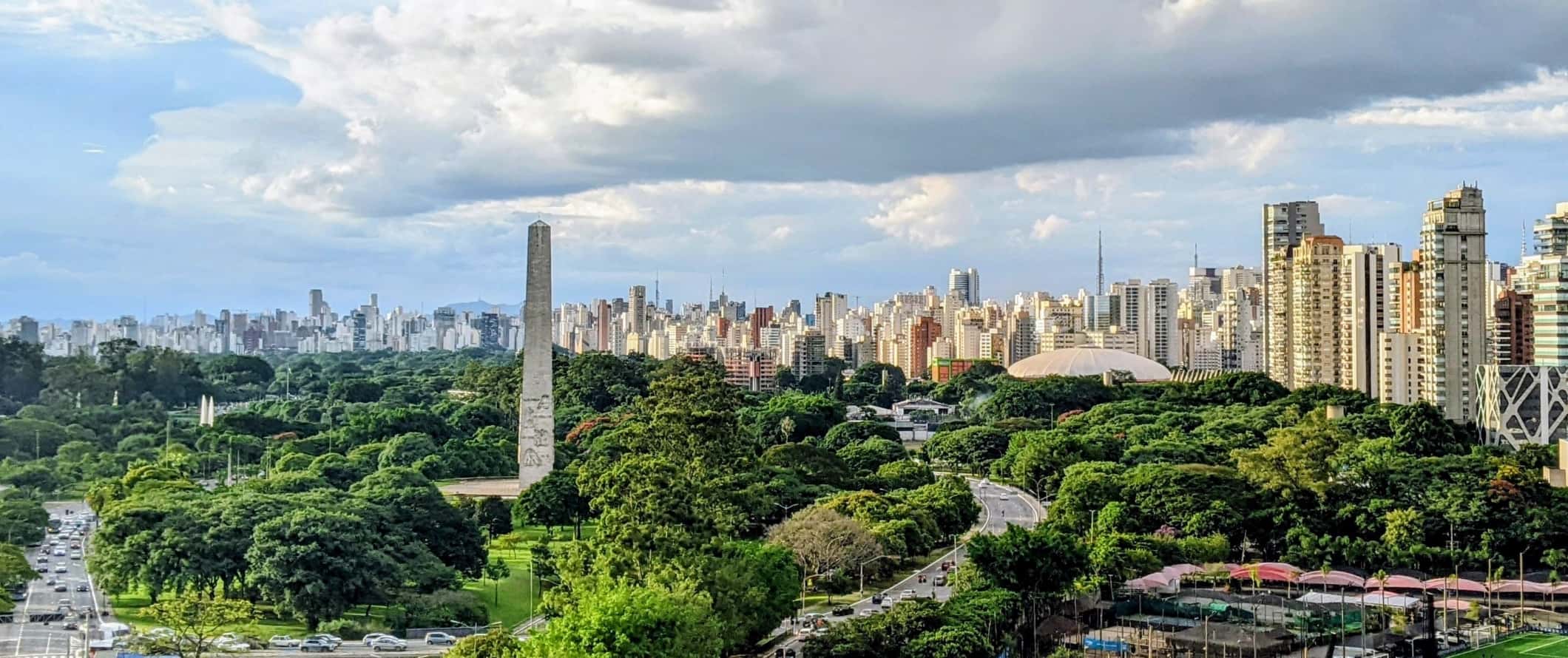
A lot of travelers skip São Paulo when visiting Brazil , choosing to go to Rio de Janeiro and other parts of the country instead.
This sprawling metropolis shouldn’t be skipped.
Originally inhabited by the indigenous Tupi people, Portuguese Jesuit priests colonized the area in 1554. The settlement remained small until the 18th-century gold rush in the northern region of Minas Gerais, during which explorers passed through São Paulo on their way to seek their fortunes. After the gold ran out, sugar and coffee, grown on plantations fueled by the forced labor of enslaved Africans, became central to São Paulo’s development as an economic center.
Today, São Paulo is a major cosmopolitan city and cultural hub that is home to over 22 million people, including the largest Italian, Japanese, and Portuguese diasporas in the world. Each neighborhood is like its own micro-city, from Liberdade (São Paulo’s Japantown) to bohemian Vila Madalena.
This travel guide to São Paulo can help you save money and stay safe, as well as ensure that you have a wonderful visit to this Latin American megalopolis.
Table of Contents
- Things to See and Do
- How to Stay Safe
- Where to Stay
- Typical Costs
- Suggested Budget
- Money-Saving Tips
- How to Get Around
- Best Places to Book Your Trip
- Related Blogs on São Paulo
Click Here for City Guides
Top 5 things to see and do in são paulo.
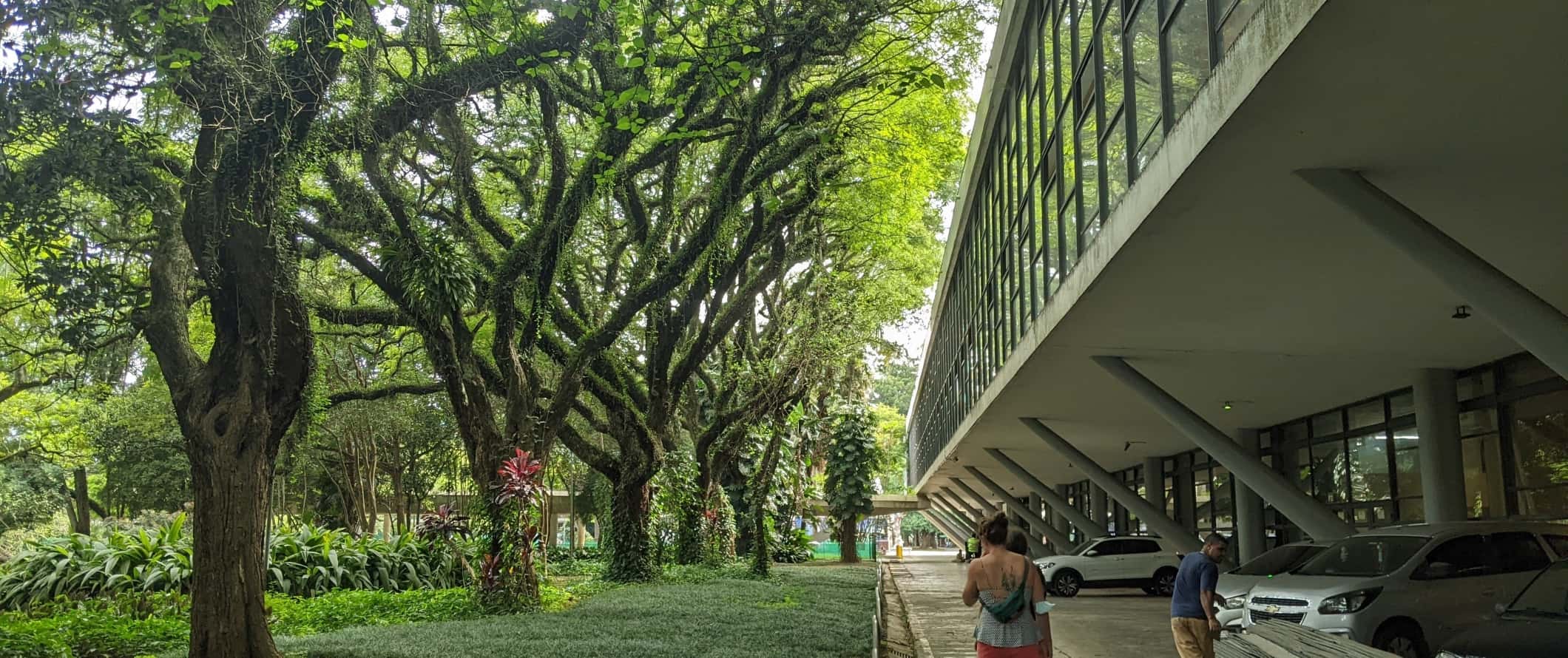
1. Take a free walking tour
Free walking tours help you get the lay of the land on your first few days in a destination. Since São Paulo is so big, taking a tour with a local guide can help orient you. São Paulo Free Walking Tour is an excellent option, with tours that explore four different areas: Old Downtown, Vila Madalena, Ibirapuera Park, and Paulista Ave. Check the website before turning up as sometimes certain routes are closed due to the many festivals that occur in the city. (And remember to always tip your guide at the end!)
2. Stroll through Ibirapuera Park
At 158 hectares (390 acres), Ibirapuera is the largest urban park in South America. It’s the perfect place for a stroll or bike ride, lounging around, or watching the locals playing footvolley (a uniquely Brazilian sport that’s a mix of soccer and volleyball). Stop in at the Museu Afro Brasil (Afro Brazilian Museum, located within the park) or the MAC (Museum of Contemporary Art, just outside the park).
3. Watch, listen, and dance to samba
Samba is an institution in Brazil. Each city and region has its own variation on this Afro-Brazilian style of dance and music, and São Paulo is no different. To see some local samba, head to Bar do Baixo, Bar Samba, Vila do Samba, or Casa Barbosa. And if you’re in town in January and February leading up to Carnival, you can watch samba schools practice their performances. During Carnival, these schools all compete at the Sambódromo to try to win the award for best samba school of the year.
4. Eat, Eat, Eat
São Paulo is a city in which to eat and eat well. There’s fantastic street food, restaurants dedicated to all regions of Brazil (including many Amazonian eateries, in case you won’t be making it there on your trip); delicious Japanese, Italian, and Lebanese food (owing to the large diasporas here); and a surprisingly vast vegan food scene for the plant-based and plant-curious. And if you’re into something more upscale, there’s no shortage of fine-dining establishments, including the number one restaurant in South America, Casa do Porco. If you’re a foodie, São Paulo is a must!
5. Admire the street art
Allegedly named after some Batman graffiti that was painted here in the 1980s, Batman Alley is one of São Paulo’s street art hot spots. Head here to meander through the winding, cobblestone-lined alley and take in the colorful murals. Artists consult with each other before painting a new mural over an old one, so there is a constantly changing gallery here, as well as street vendors selling clothing, jewelry, and other souvenirs that are all just as vibrant as the murals lining the street.
Batman Alley is far from the only place to see street art in São Paulo. Take one of several street art tours (including this street art bike tour , where you can cover more ground on two wheels) to get a sense of the street art culture in the city.
Other Things to See and Do in São Paulo
1. visit the ipiranga museum.
Originally created as a monument to the country’s independence, São Paulo’s Brazilian history museum was inaugurated in 1895. Recently reopened after almost 10 years of renovations, come here for a collection of artwork, photographs, objects, furniture, and maps especially focused on the imperial period and Brazilian independence. The building and gardens themselves are impressive as well, designed to emulate the Palace of Versailles in France. Admission is free.
2. Walk the open streets
São Paulo is a fast-paced place, and the traffic here can get overwhelming, so much so that the city has started several car-free, open-street initiatives to give residents a bit of a respite. Vendors of all types often set up along these thoroughfares, and taking a relaxed stroll on what are normally some of the city’s busiest streets is a low-key way to spend a morning or afternoon.
Paulista Avenue, often considered São Paulo’s version of New York’s Fifth Avenue, is a must-visit in general, but especially when it’s closed to traffic every Sunday. Another popular open street is the Minhocão, an elevated highway that’s closed to traffic for the entire weekend. Since it’s elevated, you can get unobstructed views of the many murals that decorate the buildings lining the road.
3. Enjoy Brazilian art
São Paulo is a museum city. The MASP (Museum of Art of São Paulo) is the most popular. The permanent collection resides all in one expansive open room, with the artwork displayed on large glass pillars, with descriptions on the back so that you see the piece first, before learning its background (or vice versa). It’s organized from contemporary art backward, though the idea of the layout is to encourage visitors to meander through the pieces at their own pace and route, choosing whatever interests them. (After you’re done at the MASP, pop into Parque Trianon across the street. It’s one of the last remaining pieces of the Atlantic Forest that used to cover the city.)
Other major art museums include the Pinacoteca (the oldest art museum in São Paulo, with a huge collection of Brazilian works) and the MAC (Museu de Arte Contemporaria, focused on 20th-century Western art). For more off-the-beaten-path artistic expression, check out the many experimental theaters and art-house cinemas (including CineSala, an independent street theater founded in 1959).
4. Learn at the Museu Afro Brasil
Located in Ibirapuera Park, this expansive museum is dedicated to celebrating and teaching Afro-Brazilian history (with several rooms on the slave trade, one housing the remains of a slave ship), religion, art, and culture. The 6,000-piece collection is massive, including sculptures, documents, engravings, ceramics, paintings, contemporary artwork, jewelry, objects, reliefs, photographs, and textiles. The building itself was designed by renowned Brazilian architect Oscar Niemeyer, so spend some time appreciating it from the outside too. Unfortunately, most of the descriptions aren’t in English (there is free Wi-Fi, so you can use Google Translate to translate the text). Admission is 15 BRL.
5. Peruse the neighborhood markets
Opened in 1933, the Municipal Market of São Paulo is the main one, with all kinds of stalls selling tropical fruits, veggies, and artisanal products (just be careful of the sellers trying to get you to try the different fruits — they’re notorious for giving out “free samples” and then charging high prices). There is also a food court within the market where you can get lunch, a snack, or a drink. While you’re here, make sure to look up to take note of the 72 colorful stained-glass windows that depict food and food production in the region. It’s open Monday to Saturday, 6am-6pm, and Sunday from 6am-4pm.
6. Go on a food tour
While eating your way around town is fun on your own, you can get more cultural and historical context by taking a food tour. Concrete Jungles Walking Tours offers a few, including a breakfast tour, a gourmet tour of the hip Pinheiros neighborhood, and a street food tour in Liberdade . The cost ranges from 160 to 315 BRL, which includes all the food.
7. Visit Liberdade (Japantown)
São Paulo is home to the largest Japanese community outside of Japan, dating back to the end of feudalism in Japan which kick-started emigration to Brazil (where there was a labor shortage at the time). Liberdade is the São Paulo’s Japantown. Come here to have some tasty ramen, curry, and sushi, and to shop at the many Japanese stores and street vendors. If you can, come during the week, as the weekends get incredibly crowded here. And to learn more about the Japanese community in Brazil, the History Museum of Japanese Immigration in Brazil is located here as well (16 BRL, free on Wednesdays).
8. Take in views of the megalopolis
To truly get a feel for just how expansive this city is, head to one of the many rooftop terraces to take in panoramic skyline views. Some of the most popular are the rooftops at MAC USP, Farol Santander, and Hotel Unique, all of which have rooftop bars for grabbing a drink while overlooking the cityscape. Hotel Unique is especially famous for its red rooftop pool and overall building design, which resembles a ship.
9. Watch a soccer match
Like in most of Latin America, soccer (called futebol here) is huge in Brazil. Even if you’re not a big sports fan, it can be fun to attend a game and get caught up in the excitement. Palmeiras and Corinthianos are the two main football teams in São Paulo, and you can watch home games at their respective arenas, Allianz Parque and Arena Corinthians. If there’s no game going on while you’re in town, or if you’re an especially big soccer fan, you can also visit the Museu do Futebol, an interactive museum that documents Brazil’s soccer history and culture (though be aware that all the displays are in Portuguese). Admission is 20 BRL.
10. Enjoy the nightlife
If there’s one stereotype that’s true, it’s that Brazilians know how to party. Whether you’re into clubbing, samba, or just having a few drinks at a neighborhood watering hole, there’s something for everyone here. For a fun night out, head to Vila Madalena and Pinheiros, the hipster neighborhoods with tons of bars and restaurants lining the streets.
11. Celebrate Carnival
While Rio’s Carnival gets all the attention, each city and region of the country has its own Carnival traditions and flair, so if you’re here in February, you’ll get to celebrate the world’s biggest party — and at a much lower cost than in Rio. Tickets to the famous samba parades at São Paulo’s Sambódromo (a samba stadium) cost 45-190 BRL for bleacher general admission, compared to 725-1,085 BRL for the same in Rio (plus, tickets sell out much further in advance in Rio). It’s also impossible to miss the blocos (street parties) that take over the streets during the week of Carnival. These free events are the people’s way to celebrate Carnival, so throw on some glitter and join in to make new friends!
For more information on specific cities in Brazil, check out these guides:
- Fernando de Noronha Travel Guide
- Florianópolis Travel Guide
- Rio de Janeiro Travel Guide
How to Stay Safe in São Paulo
Though it’s safer than Rio (the favelas, or shantytowns, are not close to the city center as in Rio), travelers should be careful and on their guard in São Paulo. Pickpocketing and other petty crimes are common here. Don’t flash expensive belongings, and always keep your phone and wallet secure and out of reach. Don’t carry your passport with you when you’re out for the day. If you have multiple credit cards, don’t carry them all with you at once.
Avoid going out alone in the evenings after dark, especially in downtown, where there are large encampments of unhoused persons and more likelihood of petty theft. If you do need to go out at night, have your hostel/hotel call a taxi for you, or use Uber (which is incredibly common).
Solo female travelers should exercise caution here. Avoid walking around alone when possible, particularly at night. Always keep an eye on your drink (even when it’s being poured), and never accept drinks from strangers. Always trust your gut instinct.
Use ATMs inside a bank or have a friend with you to keep an eye out while you withdraw cash.
To learn which scams to be on the lookout for, read this post about common travel scams.
Make copies of your personal documents, including your passport and ID. Forward your itinerary along to loved ones so they’ll know where you are.
If you experience an emergency, dial 190 for assistance.
For more in-depth coverage of how to stay safe in Brazil, check out this post that answers some frequently asked questions and concerns. Overall though, Brazilians are very friendly and helpful. Don’t let fearful perceptions of the city and country put you off from visiting this vibrant place.
And always buy travel insurance. It will protect you against illness, injury, theft, and cancelations. It’s comprehensive protection in case anything goes wrong.
Where to Stay in São Paulo
São Paulo is sprawling. When you’re researching your hostel, make sure you find a neighborhood that fits your needs. Otherwise, you’ll be spending a lot of money on taxis or Ubers and sitting in terrible traffic. There are plenty of hostels and budget-friendly hotels here. Here are some suggested places to stay:
- Hotel Amália
- O de Casa Hostel Bar
- Madá Hostel
- Hostel Brasil Boutique
- Comfort Nova Paulista
- Hotel Calstar
São Paulo Travel Costs
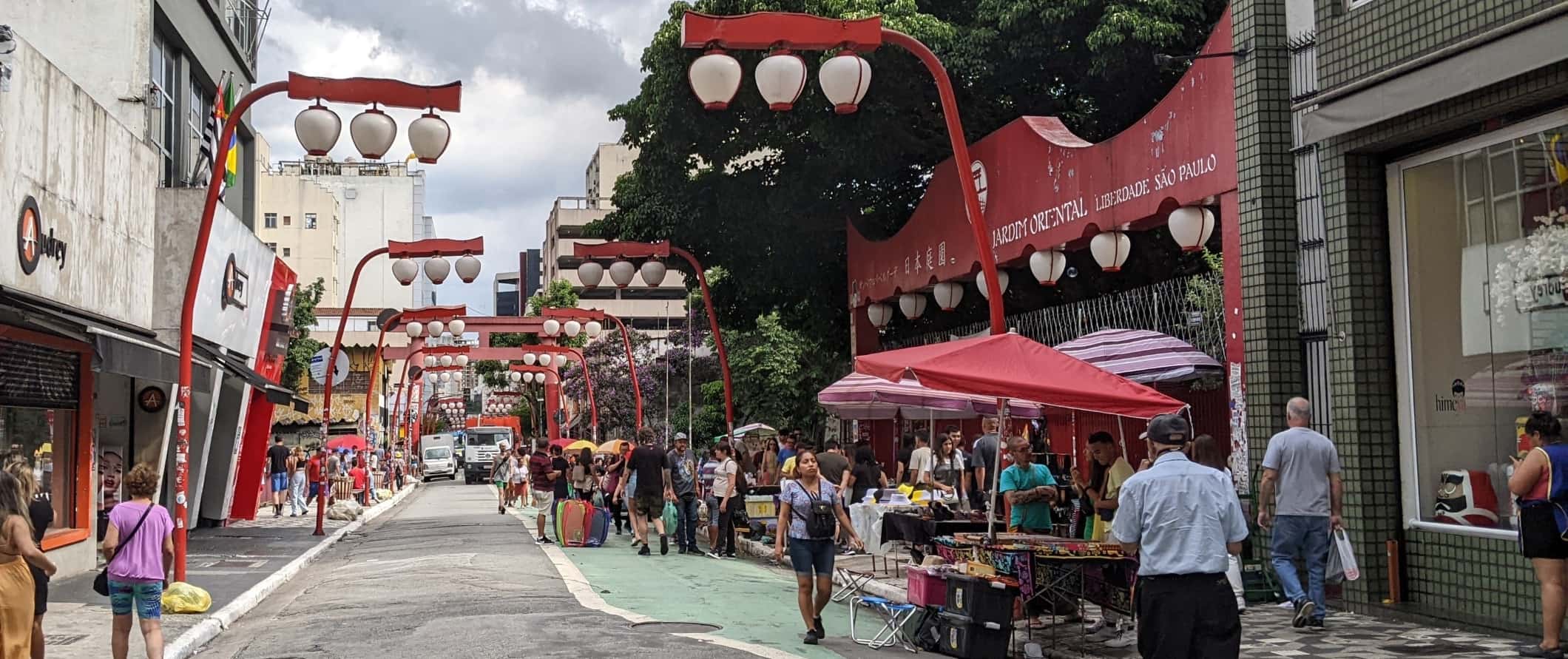
Accommodation
- Hostel dorms – 50-90 BRL per night
- Hostel private rooms – 150-300 BRL per night
- Budget hotels – 150-200 BRL per night
- Airbnb private rooms – 67 BRL per night
- Airbnb apartments – 115 BRL per night
- Street food – 5-10 BRL
- Buffets – 40-65 BRL per kilo
- Sit-down restaurants – 25-35 BRL
- Fine dining – 150-200 BRL
- Casual take-out places – 35 BRL
- Fast food (think McDonald’s) – 35 BRL
- Beer – 8-11 BRL
- Cocktails – 20-40 BRL
- Cappuccino/latte- 10-15 BRL
- Groceries for a week – 200-250 BRL
Some specific restaurant recommendations: Casa Tucupi for Amazonian food, Padaria Bella Paulista (a 24-hour diner/bakery/café), and Tabuleiro do Acarajé, which specializes in acaraje , a typical street snack from the region of Bahia.
For fantastic cocktails, head to Santana Bar or Bar dos Arcos, an ultra-cool underground cocktail bar under the gorgeous Municipal Theatre.
São Paulo Suggested Budgets
Backpacker – 155 brl per day.
If you are backpacking São Paulo, this budget covers staying in a hostel dorm, eating street food, cooking some of your meals, and using public transportation to get around. You’ll need to limit your drinking and do mostly free activities like walking tours.
Midrange – 375 BRL Per Day
On a midrange budget, you can stay in a private hostel or Airbnb room, eat out for all your meals at cheap restaurants, take the occasional taxi to get around, take buses between destinations, enjoy a few drinks, and do more paid activities, such as a bike tour and museum visits.
Upscale – 675 BRL Per Day
On an upscale budget, you can stay in a hotel, eat out for all your meals, enjoy more drinks, take taxis everywhere, and enjoy all the tours and activities you want. This is just the ground floor for luxury though!
São Paulo Travel Guide: Money-Saving Tips
São Paulo is one of the more expensive cities in Brazil, but prices depend on where you are and what kind of activities you’re doing. It’s still cheaper than Rio, and there are a lot more free and cheap activities here. Here are some other money-saving tips to help you get started:
Take a free walking tour – São Paulo Free Walking Tour offers many different tours, and they’re the best way to see the main sights on a budget. Just be sure to tip your guide at the end!
Stay with a local – Couchsurfing connects you with locals who can give you a free place to stay and share their insider tips and advice. It’s the best way to meet locals and save money if you’re on a tight budget.
Visit off-season – December to March is a popular time to visit as people from the Northern Hemisphere escape the winter. Try to avoid these months if you want to keep your expenses low.
Skip Carnival – Carnival might be fun, but it can also get expensive. If you’re on a budget, avoid visiting during Carnival.
Pack a water bottle – The tap water here isn’t safe to drink so bring a water bottle with a filter to save money and reduce your single-use plastic usage. My preferred bottle is LifeStraw as it has a built-in filter to ensure your water is always clean and safe.
Snack on street food – There’s a thriving street food culture in Brazil, meaning lots of cheap and delicious food to fill up on.
Eat at the buffets – Buffet-style restaurants are extremely common and popular here. You take a plate, fill it up with anything your heart desires from the hot and cold buffets, and then pay by weight. It’s an inexpensive way to eat as the locals do.
Go to free museum days – Many of the museums here are free, and the ones that aren’t usually have a free day each week. Check their websites for details.
Visit the market – If you’re staying at a hostel with kitchen facilities, stock up on food at the market and eat like the locals. It won’t be fancy, but it will be affordable.
Get an Airpass – Brazil is a huge country, and if you want to see multiple destinations yet don’t have tons of time, you’ll need to fly. While there are budget airlines in Brazil, if you plan to visit faraway places (like the Amazon), flights can get expensive. If you book your domestic flights in advance, an Airpass can save you money on flights. It’s the cheapest way to fly around the country.
How to Get Around in São Paulo
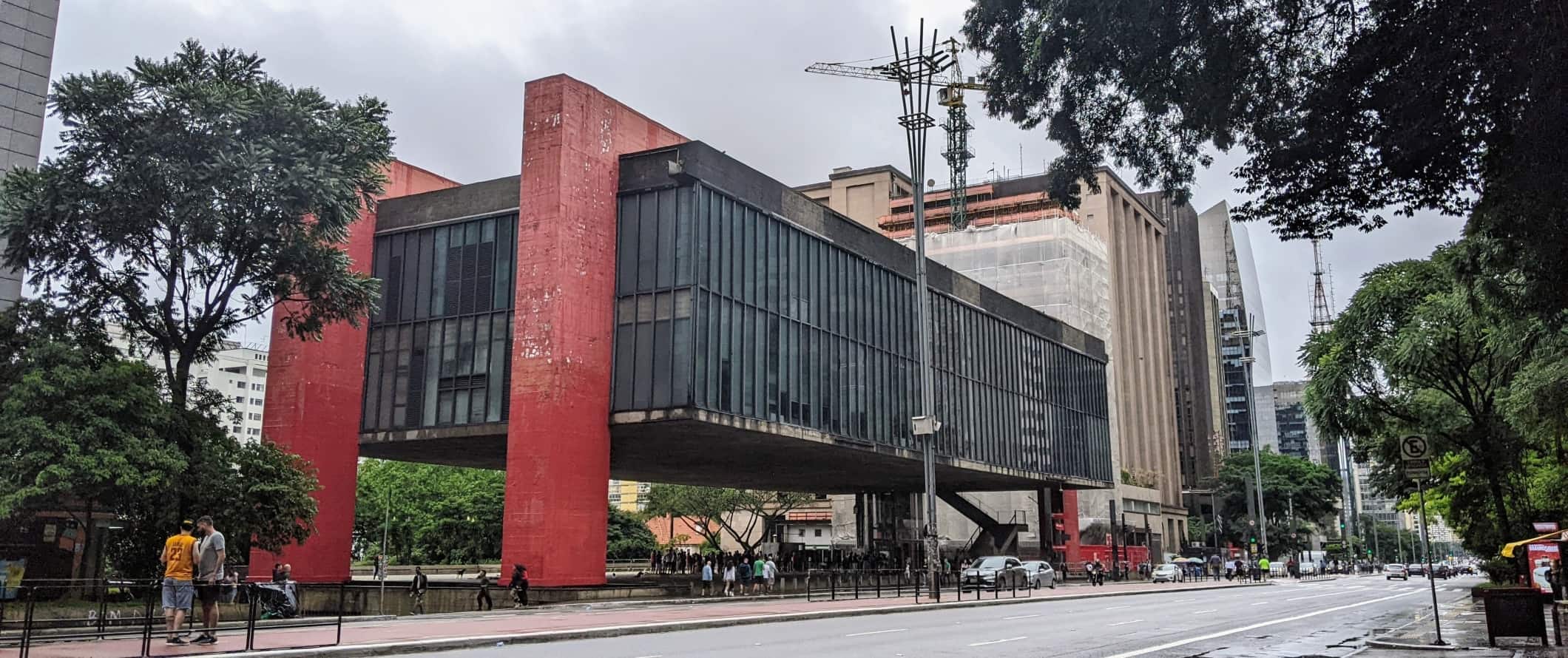
Walking – São Paulo is walkable within neighborhoods, but since the city is so large, it would take forever to get from one neighborhood to another.
Public transportation – São Paulo’s metro system is the largest in South America. It’s known for being fast, reliable, clean, and efficient. It costs 4.40 BRL for one ride, which must be paid for in cash. There’s no transit pass for foreigners (Brazilian citizens and residents can get one with a valid ID). Lines operate from 4:40am-12am Sunday-Friday and holidays. On Saturdays, lines run from 4:40am to 1am.
The BRT (bus rapid transit) system is also a very popular, and often a faster, more direct way to get somewhere as compared to the metro, thanks to dedicated bus lanes. You pay your fare (also 4.40 BRL, in cash) as soon as you board to the ticket collector (a worker that sits in a chair to collect money; they’re separate from the bus driver).
Taxis – Taxi fares start at 5.50 BRL, plus an additional 4 BRL per kilometer. There are two fare sets: “1” is for the daytime, and “2” is for evenings/overnights (8pm-6am) and Sundays. The second fare set is up to 30% more than the base rate. You can see which fare set is being used on the meter, which always must be turned on (if it’s not, get out and hail another cab).
You can also use the 99 app (formerly known as 99Taxis) to get a safe, metered taxi. Avoid taking taxis at peak hours, as the traffic here is notoriously bad. During rush hour, taking the metro or buses (which have special dedicated lanes) is usually much faster.
Bicycle – São Paulo is a very hilly city, so keep that in mind if you plan to bike here! You can find the bike-share system here, called bike Itaú, all over the city (the bikes and docks are a recognizable orange). For one ride, it’s 4.39 BRL for 15 minutes, and then 0.40 BRL each minute after that. Electric bikes are 0.40 BRL per minute right from the start. You can also rent bikes in parks, such as Ibirapuera Park, for 7 BRL per hour.
Ridesharing – Uber is available and very common in São Paulo. It usually costs less than a taxi ride too. A typical ride costs around 20-35 BRL.
Car rental – Renting a car generally costs 80-120 BRL per day, though you really don’t need to do so here. It’s unnecessary, the traffic is terrible, drivers are aggressive, and overall, it’s just a hassle.
If you do need a car, use Discover Cars to find the best deals.
When to Go to São Paulo
São Paulo is a rainy city. That being said, it usually doesn’t rain the whole day, even in the summer wet season, which is from December to March (with January being the rainiest month). During this time, temperatures are in the low 20s Celsius (mid-70s Fahrenheit).
In winter (June–August), you’ll have much less rain, though temperatures are lower, ranging between 12 and 22°C (54–72°F).
There’s really no bad time to visit, though, as the weather is quite mild year-round. However, the shoulder seasons (March–May or September–November), when it’s warmer but less rainy, are ideal.
Accommodation does book up and is more expensive during Carnival (in February), though it’s not nearly as pronounced as in Rio, which is where most foreigners go for Carnival.
São Paulo Travel Guide: The Best Booking Resources
These are my favorite companies to use when I travel. They consistently have the best deals, offer world-class customer service and great value, and overall, are better than their competitors. They are the companies I use the most and are always the starting point in my search for travel deals.
- Skyscanner – Skyscanner is my favorite flight search engine. They search small websites and budget airlines that larger search sites tend to miss. They are hands down the number one place to start.
- Hostelworld – This is the best hostel accommodation site out there with the largest inventory, best search interface, and widest availability.
- Booking.com – The best all around booking site that constantly provides the cheapest and lowest rates. They have the widest selection of budget accommodation. In all my tests, they’ve always had the cheapest rates out of all the booking websites.
- Get Your Guide – Get Your Guide is a huge online marketplace for tours and excursions. They have tons of tour options available in cities all around the world, including everything from cooking classes, walking tours, street art lessons, and more!
- SafetyWing – Safety Wing offers convenient and affordable plans tailored to digital nomads and long-term travelers. They have cheap monthly plans, great customer service, and an easy-to-use claims process that makes it perfect for those on the road.
- LifeStraw – My go-to company for reusable water bottles with built-in filters so you can ensure your drinking water is always clean and safe.
- Unbound Merino – They make lightweight, durable, easy-to-clean travel clothing.
- Top Travel Credit Cards – Points are the best way to cut down travel expenses. Here’s my favorite point earning credit cards so you can get free travel!
São Paulo Travel Guide: Related Articles
Want more tips for your trip? Check out all the articles I’ve written on Brazil and continue planning your trip:

Is Brazil Safe to Visit?
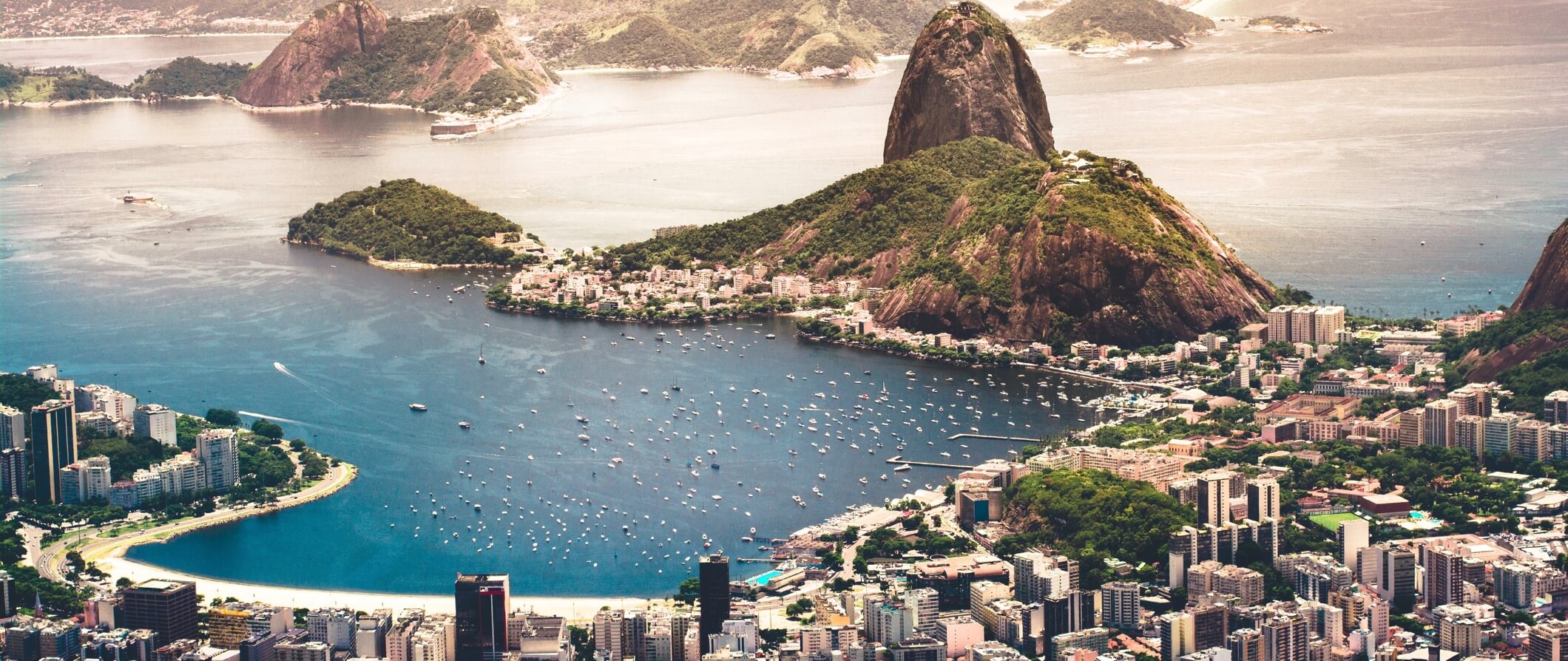
Brazil Travel Guide
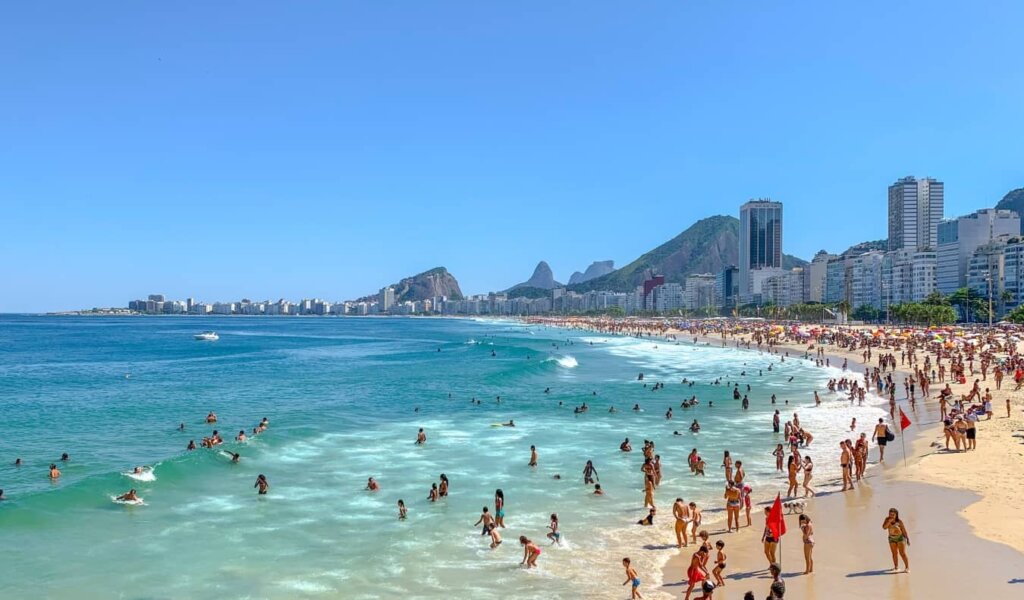
The 6 Best Hostels in Rio de Janeiro
Get your free travel starter kit.
Enter your email and get planning cheatsheets including a step by step checklist, packing list, tips cheat sheet, and more so you can plan like a pro!

- Where To Stay
- Transportation
- Booking Resources
- Related Blogs
- United Arab Emirates
- Switzerland
- The Netherlands
- Puerto Rico
- United States
- New Zealand
- ➨ Choose from World Map
- Budget Travel
- Family Travel
- Getting Around
- Visas & Passports
- Work with Us
Browsing Category
- Czech Republic
- Saint Martin
- Uncategorized

- Latin America & The Caribbean
Sao Paulo Travel Guide: Everything to Know [2023]
· your guide to a sao paulo trip in 2021, including how to get around, what to do, and more ·.
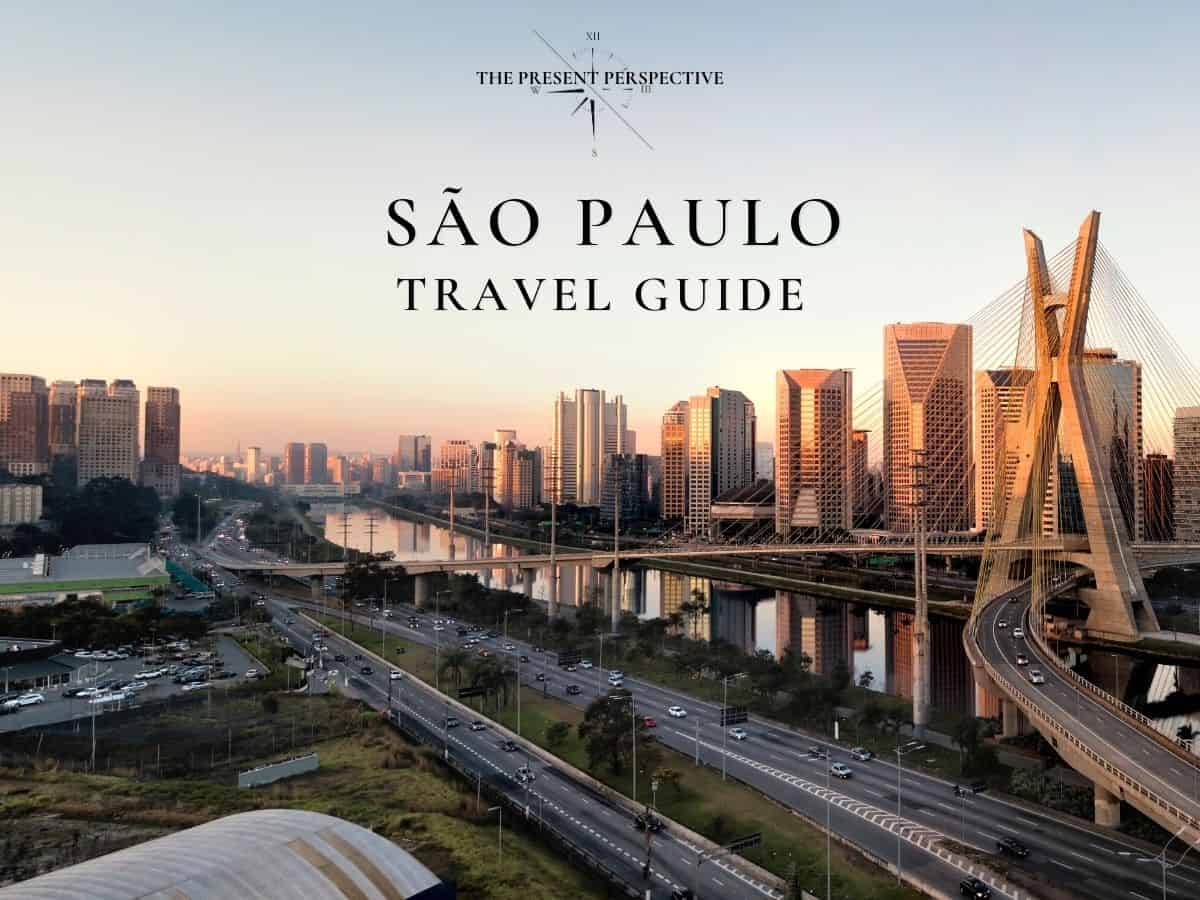
As the largest city in South America and the entire Southern Hemisphere, you’ve probably heard of Sao Paulo. About twice the size of New York City, Sao Paulo’s metropolitan area sprawls further than the eye can see. We didn’t know much about this city before arriving, but it shattered every expectation that we had.
The culinary scene is bustling and extremely international, the city’s infrastructure is incredible, and the people are some of the friendliest that we’ve ever encountered. Did I mention that Sao Paulo has the biggest Japanese community in the world outside of Japan?
If you like Japanese food, love quality art museums, enjoy watching soccer or are interested in visiting one of the largest cities in the world, Sao Paulo is a great place you don’t want to miss!
If you like Japanese food, love quality art museums, enjoy watching soccer, or are interested in visiting one of the largest cities in the world, Sao Paulo is a great place you don’t want to miss!
Our São Paulo Vlog is our most popular YouTube video by far; you’ll be blown away by some of these foods!
The Best Things to Do in Sao Paulo
As the most populous city in Brazil, you’d be right to expect Sao Paulo to have a little bit of everything. The city is massive, historic, high-class, and very international. As a result, Sao Paulo is home to some of the best restaurants, art galleries, streets, and experiences in all of Brazil.
Some people try to say that Sao Paulo is just a giant concrete jungle, but in truth, it is a vibrant metropolis filled with cultural centers, world-class restaurants, stunning public parks, and more. Here are the best things to do in Sao Paulo.
1. Eat Incredible Asian Food in Liberdade
Liberdade is the Asian neighborhood of Sao Paulo. You could kind of think of it as Chinatown, except more Japanese than Chinese and also blended with other Asian cultures, like Korean and Taiwanese. The neighborhood is always worth visiting if you’re a fan of Asian cuisine, but it’s especially great on the weekends.
Many of the local residents and restaurants open up stands on a blocked-off street and sell all kinds of Asian food, including Chinese, Japanese, and sometimes Korean. They serve dumplings, stir-fry, desserts, tempura, bubble tea, and more!
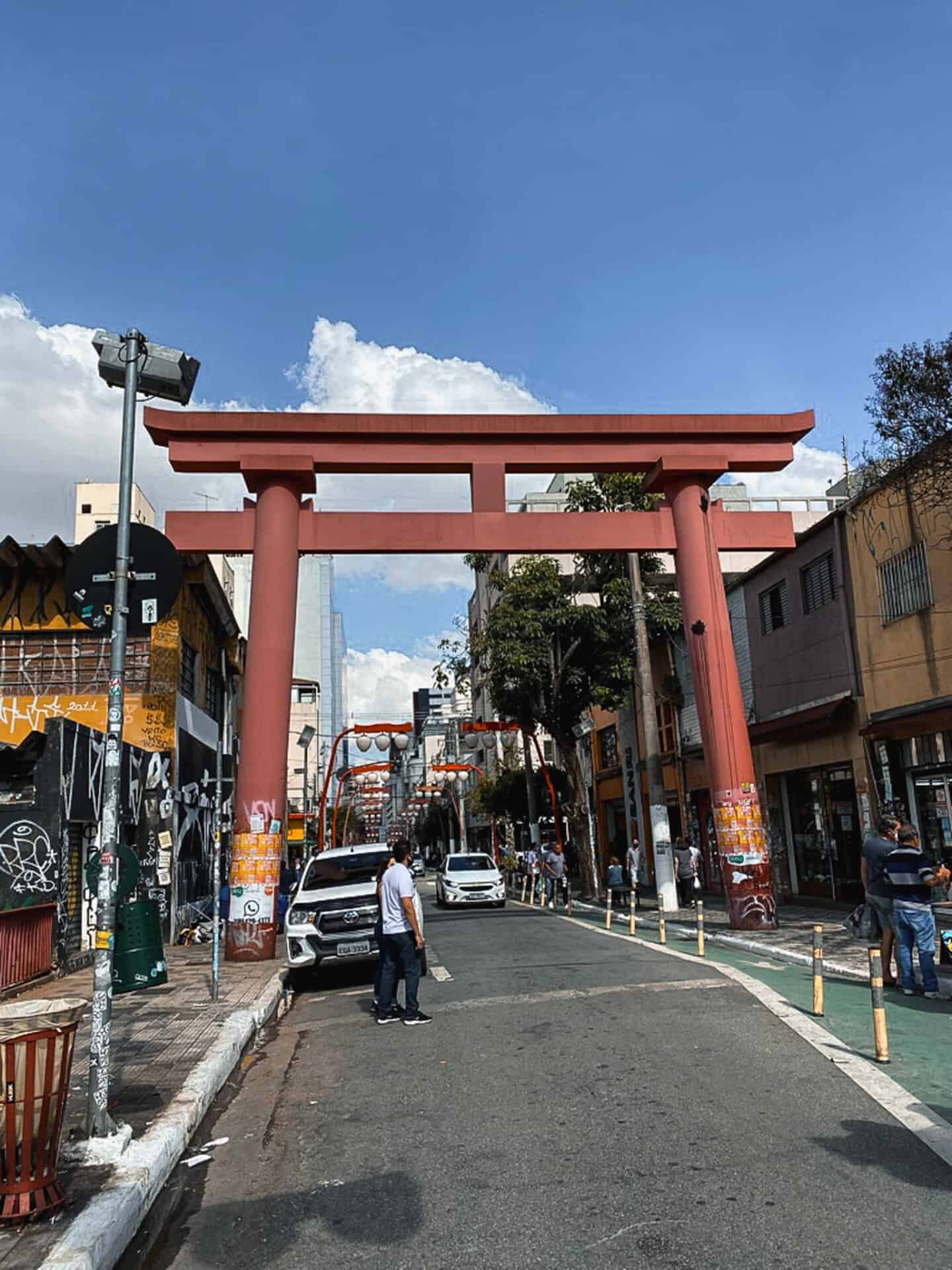
Visiting Liberdade was easily one of the best experiences we had in all of Sao Paulo and we highly recommend making it a priority if you enjoy any kind of Asian food. While you’re there, check out Bubble Kill for some great bubble tea!
Visiting Liberdade was easily one of the best experiences we had in all of São Paulo.
2. Go for a Picnic in Ibirapuera Park
Ibirapuera Park, or Parque Ibirapuera in Portuguese, is massive – like Sao Paulo’s version of Central Park in New York City. There are lakes, trails, museums, picnic tables, running tracks, restaurants, and more! The park is free to enter and is open from 5am to midnight every day of the week.
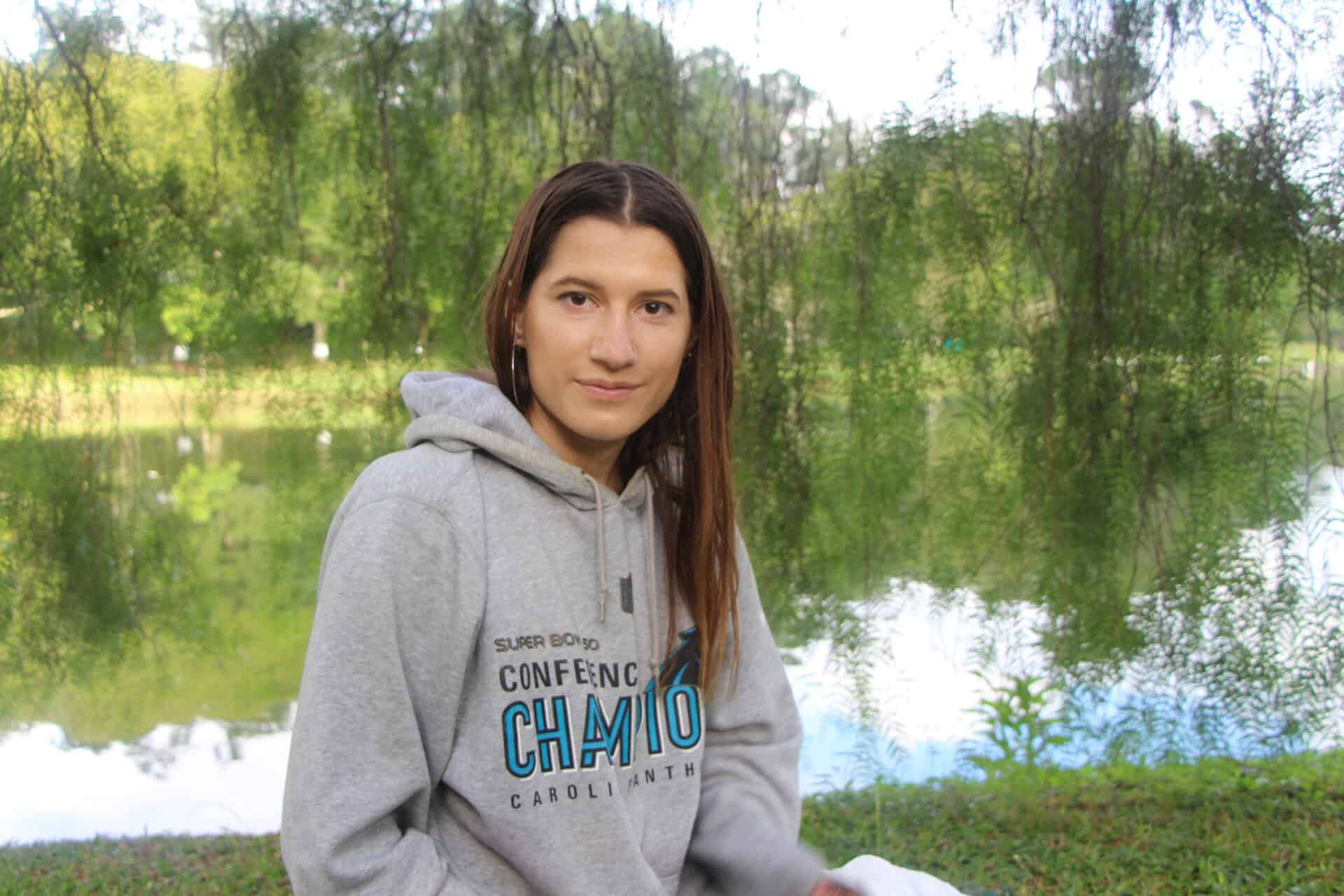
Some of the best museums in Sao Paulo are in or around the park. The food options range from snack foods and acai to full meals! There are also one- and two-seated bikes that you can rent to go for a bike ride around the park. We chose to take a bottle of wine and some sandwiches and have a picnic by the gorgeous lake while watching the swans swim around.
The park is located in a very safe area, and we could’ve spent days here between the museums, food, and natural relaxation that the park offers. Using professional photography equipment is technically illegal here, but they don’t really enforce this rule. If an officer comes up to you and tells you that you need to put your camera away, you can head over to the park authority’s office to get written consent to use your camera.
3. Admire the Graffiti at Beco do Batman
Beco do Batman, or Batman’s Alley in English, is a really cool corner of Sao Paulo worth checking out. It is essentially a street art park with several streets of elaborate graffiti that are filled with cool restaurants and cafes. The artwork is very impressive, and we went back a second time just to take it all in.
The sheer amount and quality of graffiti is incredibly unique, and we have never been anywhere like it in the world!

View this post on Instagram A post shared by Angel, Greg, & Nicola | Travel Family (@the.present.perspective)
If you come in the morning, you’ll experience a relaxed, hipster kind of vibe, while the peak hours in the evening and night tend to get a little bit rowdier! If you’re in the Beco do Batman area and looking for a bite to eat, check out AVO . They have really great farm-to-table options and serve fantastic food.
While hipster vibes may not be for everyone, this area in São Paulo is a place that we absolutely recommend visiting. The sheer amount and quality of graffiti is incredibly unique, and we have never been anywhere like it in the world!
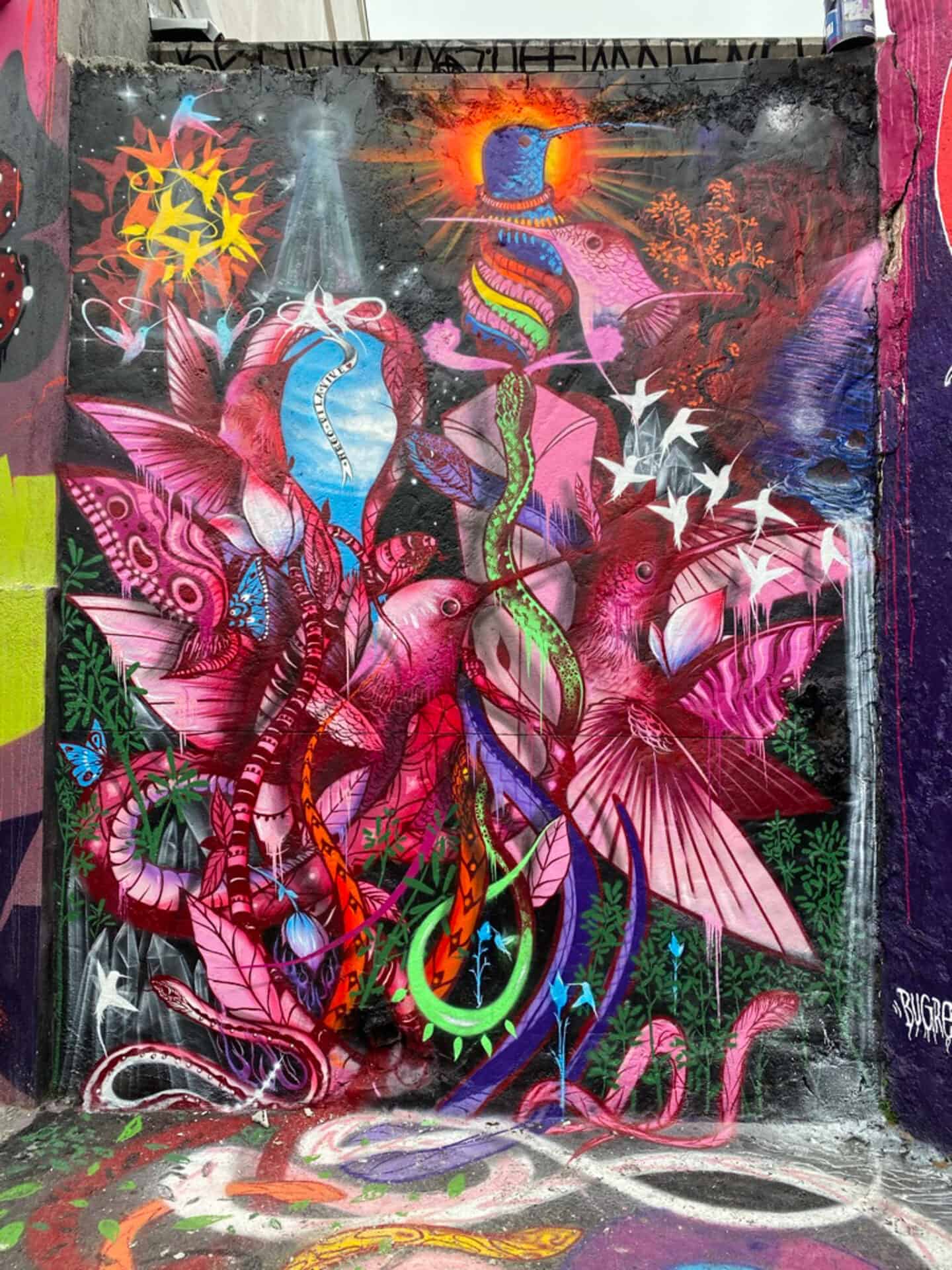
4. Get Lost in World-Class Museums and Art Galleries
If you’re a museum goer, Sao Paulo should absolutely be on your bucket list. If you enjoy art museums, you need to check out the Art Museum of Sao Paulo (MASP) , the Pinacoteca , and the Museum of Modern Art (MAM) . All of them house some fantastic works of art, but MASP is the most globally famous.
The Best Art Museums
Art Museum of São Paulo (MASP)
Museum of Modern Art (MAM)
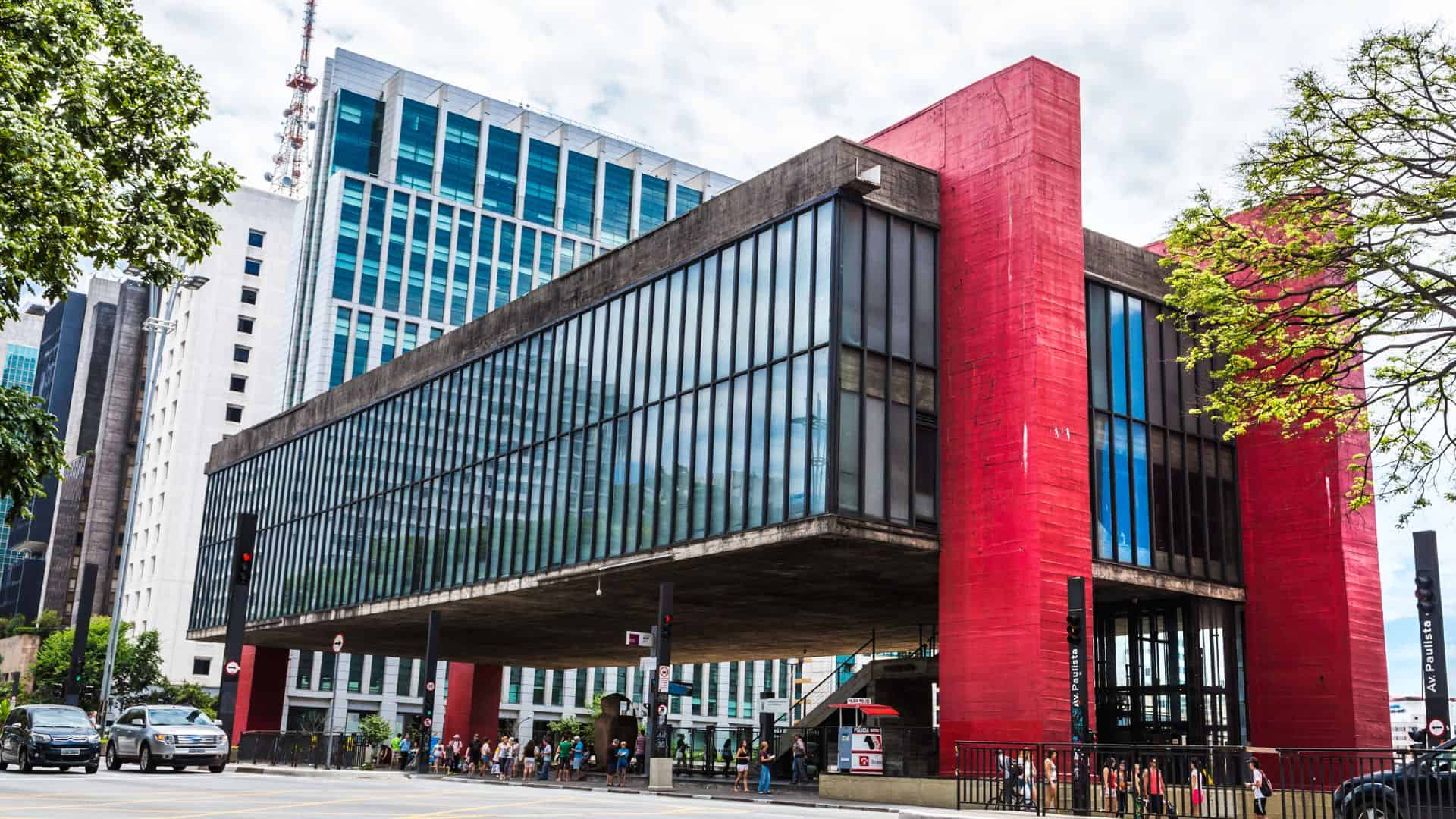
Depending on when you visit, the MASP may house works by Van Gogh, Picasso, and other highly renowned artists. If you’re more into Brazilian culture or history, I’d recommend the following three museums:
Museu do Futebol
This is an awesome soccer museum that also tells a lot of the story of Brazilian history.
Museu do Ipiranga
This museum is all about Brazilian history.
Museu Afro Brasil
This museum goes into detail about the history and present of Africans and African culture in Brazil.
5. Walk Down the Avenida Paulista
The Avenida Paulista, or Paulista Avenue in English, is considered to be the main strip of Sao Paulo. It is lined with skyscrapers, great restaurants, shopping, and parks.
While the Praça da Sé may be the geographical center of Sao Paulo, Paulista Avenue is easily the cultural city center of Sao Paulo. It alone is a big part of what makes Sao Paulo one of the most famous Brazilian cities. On top of that, its numerous shops and stores make it one of the best places to see how Sao Paulo gets its reputation as a major cosmopolitan city.
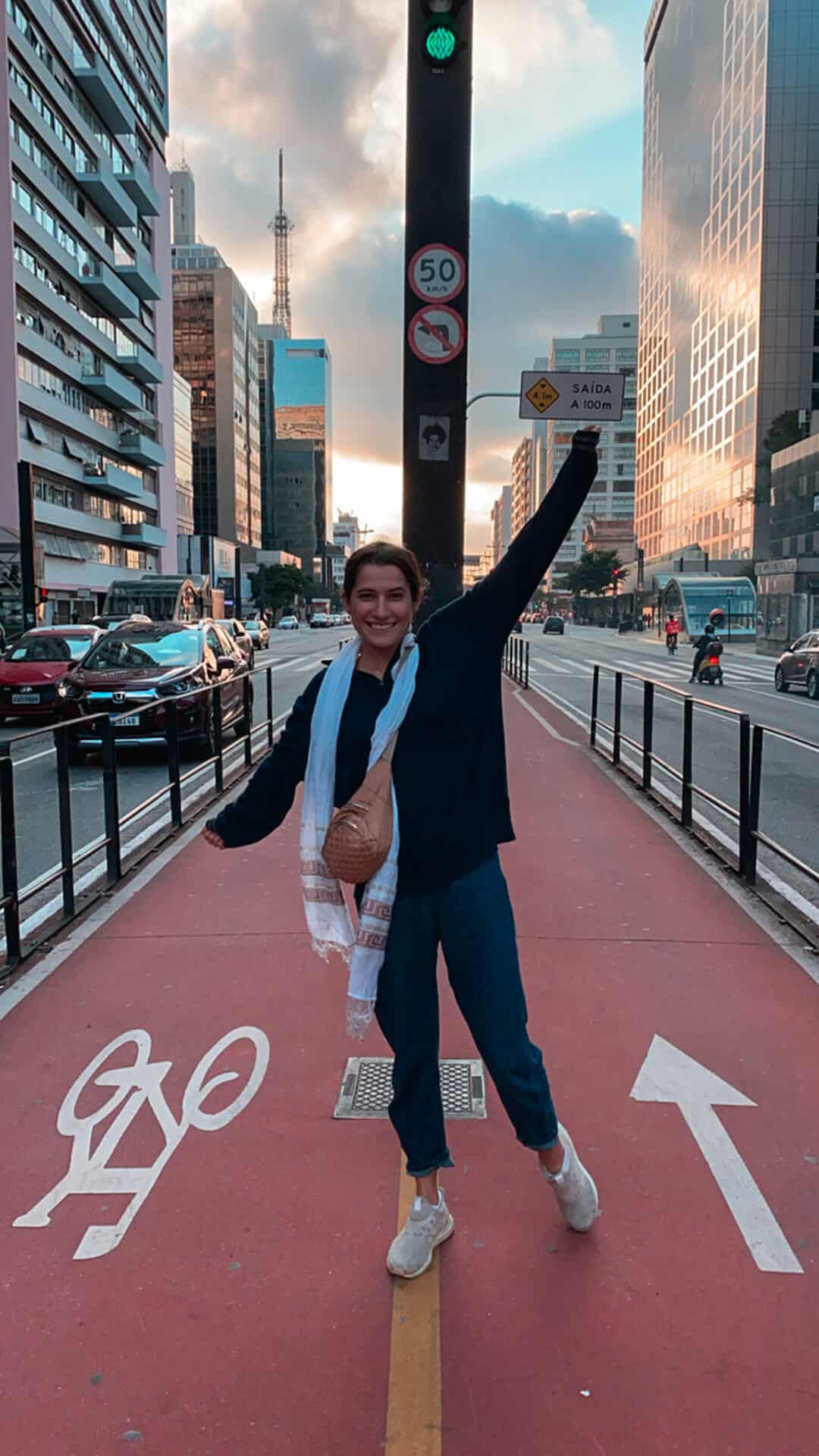
We don’t really have a favorite thing to do here other than wander. There are plenty of great things to come across, and we just recommend walking up and down the almost 2-mile-long strip to find things that interest you. With so many malls, movie theaters, buildings, parks, and vendors, you’re bound to find something that piques your interest!
On the weekends, this area is especially fun and there is even more street food. The Avenida Paulista is also a springboard that will lead you to countless other cool neighborhoods in Sao Paulo.
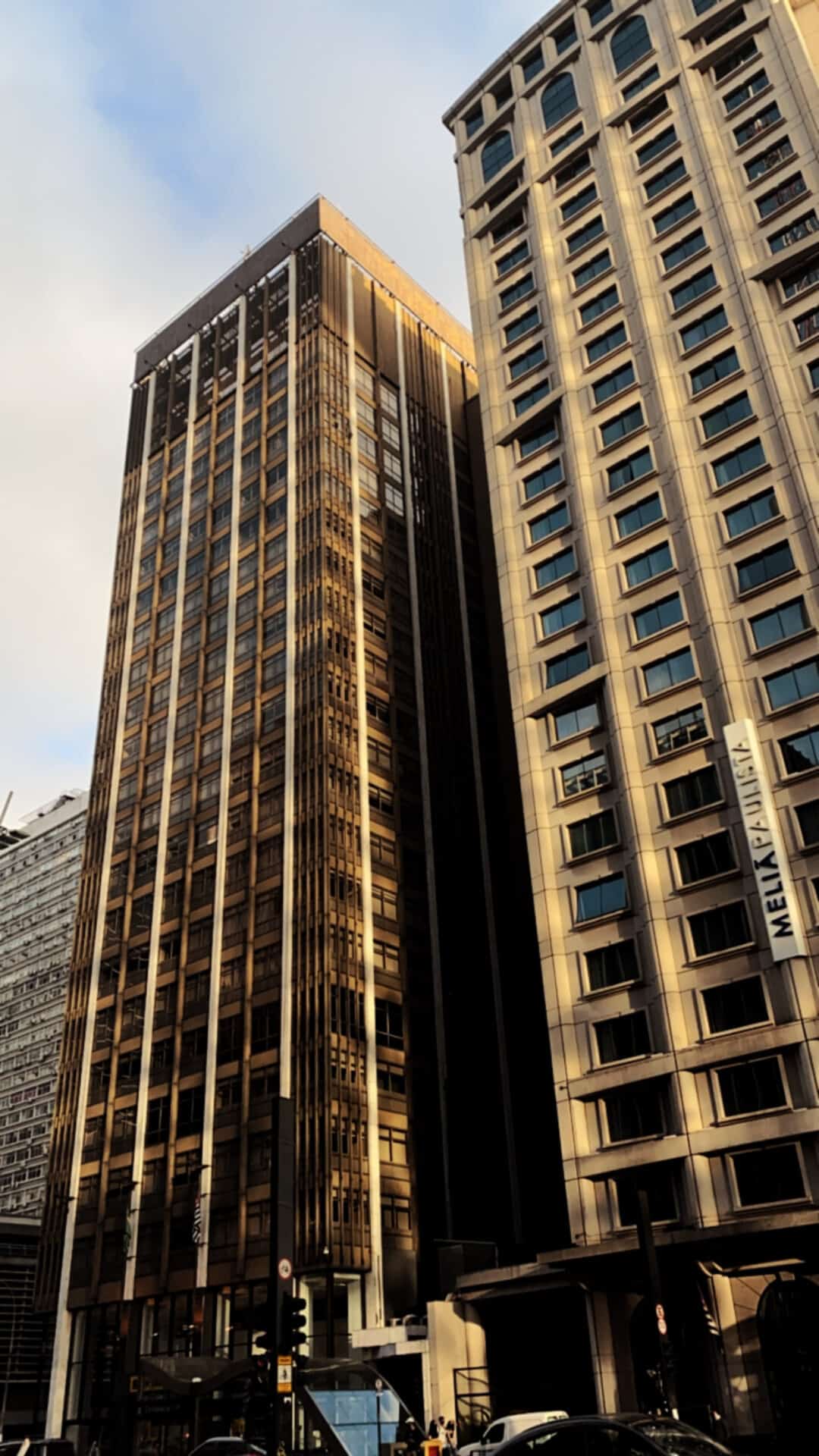
6. Spend an Evening in Vila Madalena or Along the Rua Augusta
Speaking of cool neighborhoods and areas, there are two other neighborhoods that we highly recommend checking out. Our hotel room was just a 10-minute walk from the Vila Madalena neighborhood, and we stupidly waited until our last day to check it out.
This area is really close to the Beco do Batman, and it is filled with awesome restaurants, stores, cafes, bars, and breweries. It’s a pretty hilly neighborhood and might take the wind out of you, but you can totally reward yourself with an ice-cold brew for your efforts.
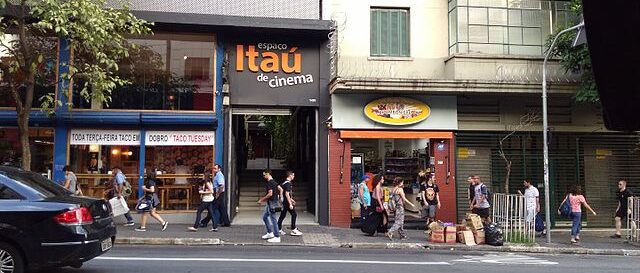
The Rua Augusta is a street that runs perpendicular to the Avenida Paulista and is also lined with awesome food and drink options. You find the best things just by walking up and down the street and seeing what sticks out! This street is loaded with great happy hour specials and the best time to visit is around 3:00 in the afternoon.
We very highly recommend checking out Boardwalk Urbanoide on the Rua Augusta. It’s a gourmet food truck park with Asian, Arab, Brazilian, Mexican, and American foods as well as several drink and dessert options. This is one of the coolest places in Sao Paulo!

7. Fill up on Traditional Brazilian foods
This one goes without saying, as Brazilian food is notoriously delicious. While this is true, we definitely had not heard of some of the most famous Brazilian foods before we arrived.
For example, coxinha (co-sheen-ya) really needs to make your bucket list. It’s basically deep-fried shredded chicken that’s battered in a gnocchi-like covering. It’s hard to describe, but it’s a must-try food.
Also make sure to get to a Padaria (bakery) to try pao de queijo and brigadeiro. Pao de queijo is delicious bread made with cheese in the dough and it’s a Brazilian staple. Brigadeiro is a chocolatey dessert that is worth every single calorie.
Do yourself a favor and try them both.

In addition to these, an experience you absolutely cannot miss out on while in Brazil is visiting a churrascaria. A churrascaria is a traditional Brazilian steakhouse, and they are known for serving all-you-can-eat fine cuts of meat. While Fogo de Chao is the chain that has gotten famous around the world, the local spots in Sao Paulo are usually a better bet.
8. Go to a Soccer Match
Brazil = Soccer. Soccer is one of the most culturally important aspects of Brazil, and there are few better places in the world to watch a match than in Brazil. Brazil has several leagues and Sao Paulo has several different teams, making it the perfect place to catch a match.

We didn’t have the chance to go because the stadiums weren’t allowing fans at the moment because of the pandemic, but I’ve heard that a soccer match in Sao Paulo is an absolute must-do if you enjoy sports of any kind. If you get there early, people have told me that Brazilians know how to throw quite the tailgate!
Brazil was the favorite to win it all in the 2022 World Cup. Despite an earlier than anticipated exit, it was clear how much Brazilian soccer fans love their team, as the stadiums in Qatar were filled with green and yellow jerseys!
9. Grab a Mortadella Sandwich at the São Paulo Municipal Market
The Municipal Market is a large indoor mercantile space in the heart of Sao Paulo. Filled with restaurants and food vendors of all types, this space is a fantastic place to grab a bite to eat. The Mortadella sandwiches here are especially famous, and they are too big to even fit in your mouth!
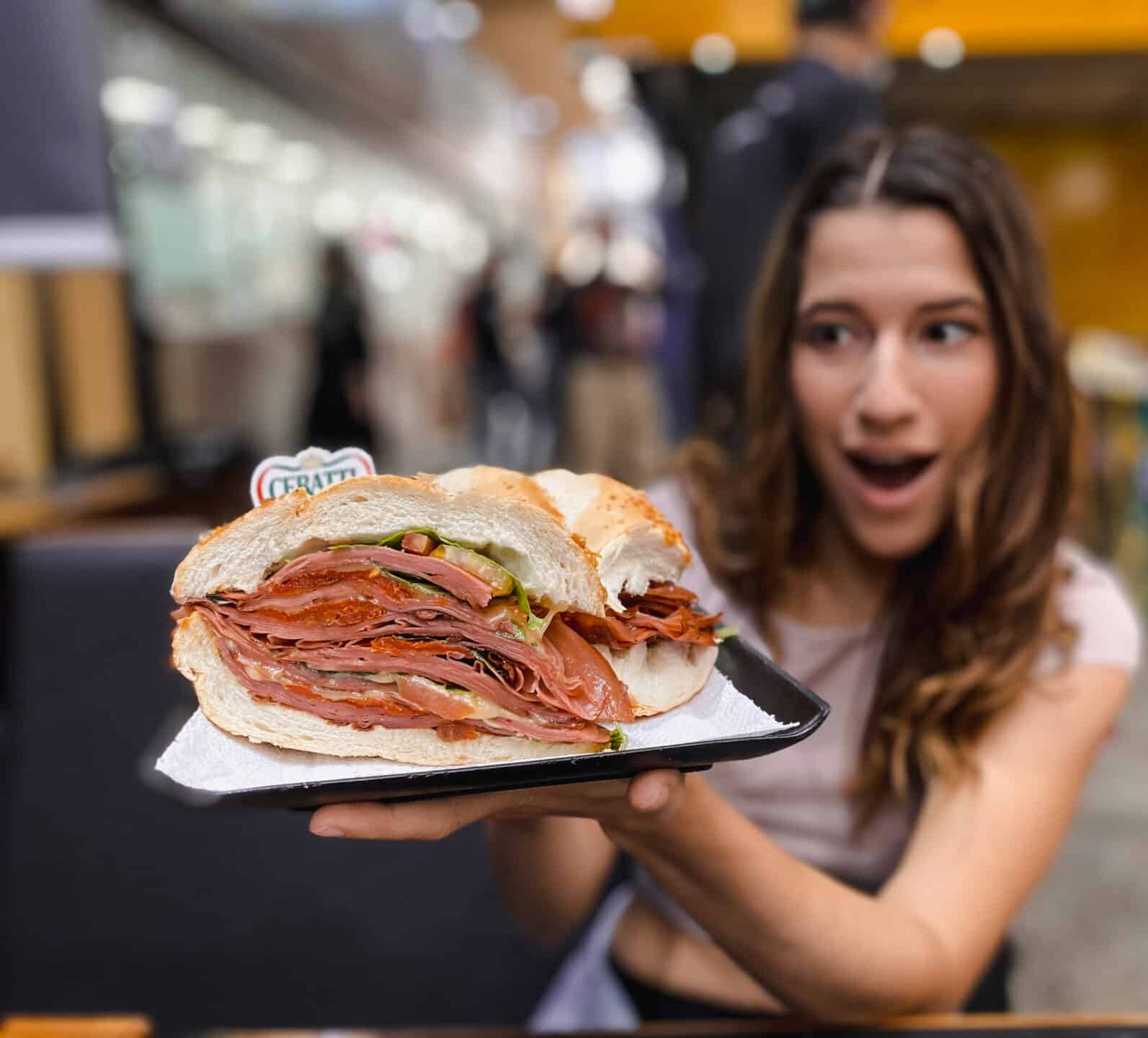
Visiting the Sao Paulo Municipal Market was one of our favorite things we did on our entire trip to Brazil, and eating a Mortadella sandwich along with drinking a local beer is an absolute must.
10. Go for a Guided Tour of São Paulo’s Highlights
As such a big city, planning an itinerary for your trip to Sao Paulo can be overwhelming. With so many things to do, it is naturally a difficult job to plan out all that you will do during your time in the city!
While we normally love to explore places on our own, Sao Paulo is a place where hiring a tour guide may make a lot of sense. There is history and significance scattered all throughout the city, and tour guides are a fantastic resource as you explore this great city. From knowing the spots with the best live music to recommending the best restaurants to indulge in some Brazilian cuisine, working with a tour guide for a single day or more is almost always worth the investment.
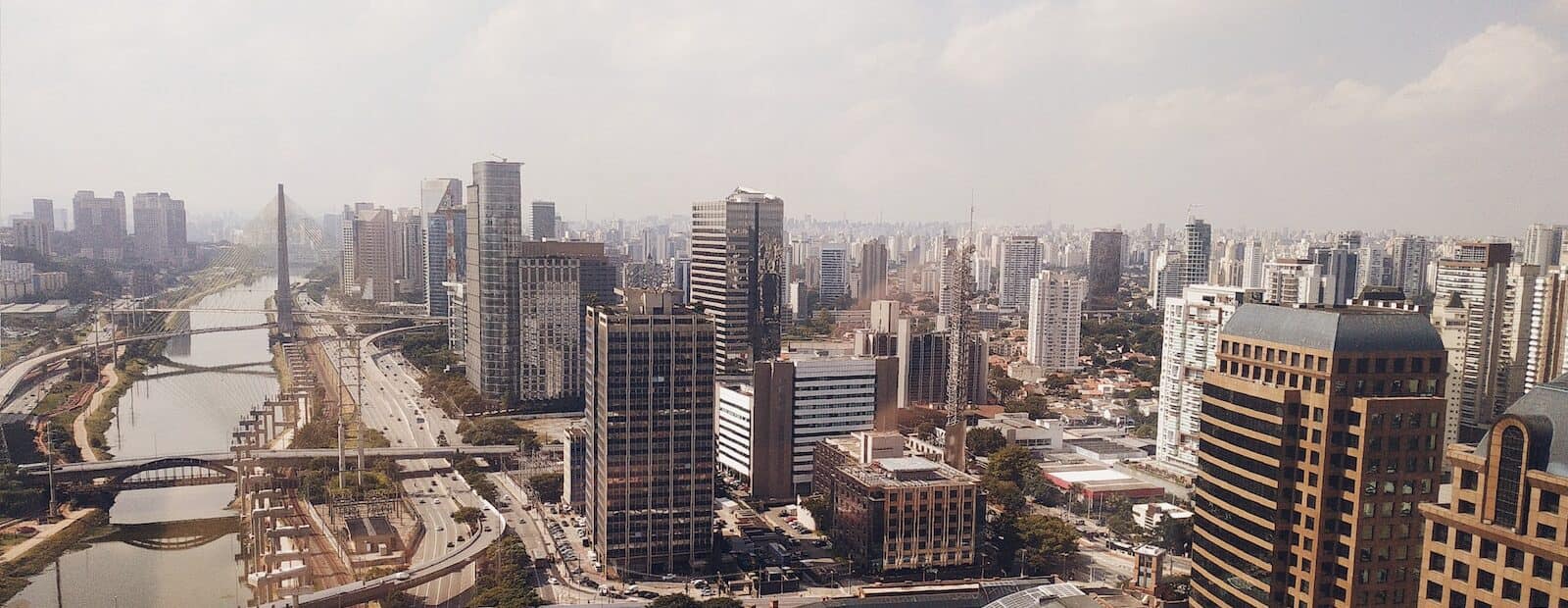
How to Get to São Paulo
If you’re coming from anywhere other than Brazil, you’ll want to fly directly into Sao Paulo. It’s the biggest city in Brazil, and there really isn’t a better city to fly into. Sao Paulo is a day’s drive from the nearest bordering country and a 4-5 hour drive from Rio de Janeiro , which is the only other city that might offer competitive flight prices.
Flights from the United States to Sao Paulo fluctuate greatly depending on where you’re flying from and when you’re flying, but you can expect to pay anywhere from $500 to well above $1,000 for a round-trip ticket. While that might sound steep, it makes a lot of sense, as this flight is very long.
Atlanta to Sao Paulo takes about 10 hours, which is comparable to the flight from New York to Moscow . New York to Sao Paulo is takes 12 hours, which is the same as New York to Abu Dhabi . Scoring a round trip ticket from New York to Moscow for $500 would be a steal.
If you haven’t read my post on tips for finding cheap flights , I’d recommend checking it out before you book your next flight, regardless of the destination. Trust me, it’s worth it – you can save over half the cost of your flight by taking a few easy steps.

READ OUR CHEAT SHEET
Sao Paulo has two airports, but only one of them is internationally focused, and that is Guarulhos International Airport (GRU) . Guarulhos International Airport fairly consistently offers competitive flight options from anywhere in Latin America and North America. If you’re flying from North America, Sao Paulo is probably the cheapest Brazilian city you can fly to.
You may find similar flight prices into Rio de Janeiro, but it’s a long distance from Sao Paulo and doesn’t make much sense unless you also plan on heading to Rio during your trip. If you are considering visiting Rio de Janeiro during your trip to Brazil, we highly recommend doing so.
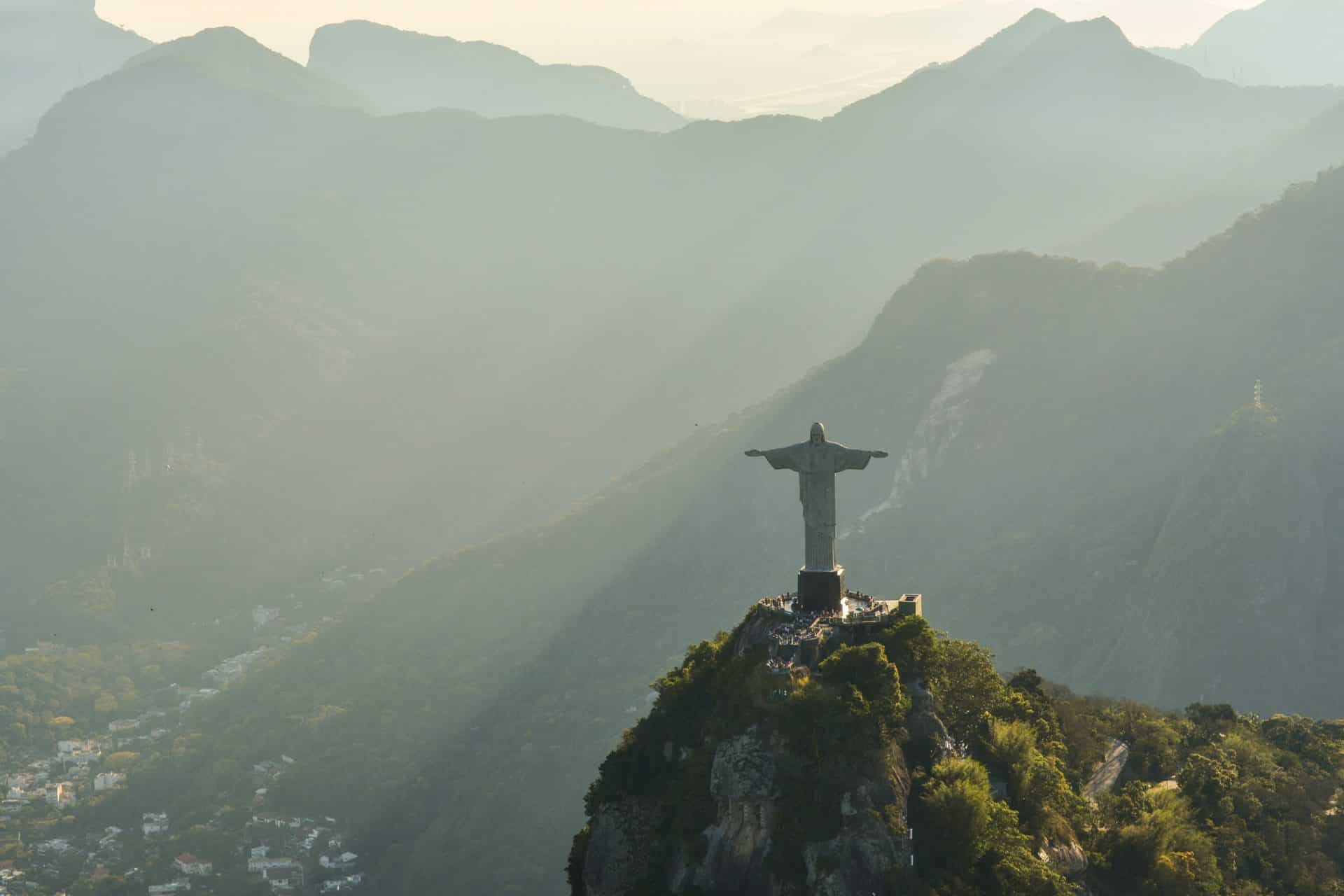
– R E A D –
How to Get Around São Paulo
METRO | UBER
Sao Paulo is easily the most navigable city we’ve visited in Latin America. This is especially noteworthy given the fact that it’s one of the biggest cities in the whole world. Getting around Sao Paulo couldn’t be easier, and there are several different ways to do it.
The best way to get around Sao Paulo is by public transportation. The metro system is immaculate and incredibly accessible. There are 6 lines in the Sao Paulo metro system, and they’ll get you within minutes by foot of wherever you want to go within the megalopolis.
The Metro stops are announced in both Portuguese and English.

The stops are all named in Portuguese, but the metro narrator announces every stop in both Portuguese and English, and using the system is quite easy. It is also pristinely clean and remarkably safe. We used the metro about 90% of the time we wanted to go anywhere in the city, and it never once let us down.
The Sao Paulo metro also runs from very early to very late – about 5:00am to midnight. As a foreigner, your only ticketing option is to buy individual tickets to use as you go, as the refillable card is only available to locals. Each trip costs less than a dollar, and transfers to other lines are free.
The São Paulo metro runs from 5:00 AM to midnight.
The system simply rocks and is one of the two best systems we have ever used. Panama City’s system is comparable in terms of cleanliness, but the only system we’ve encountered in the whole world that is on the same level of reach, quality, and cleanliness as Sao Paulo is in Shanghai, China .
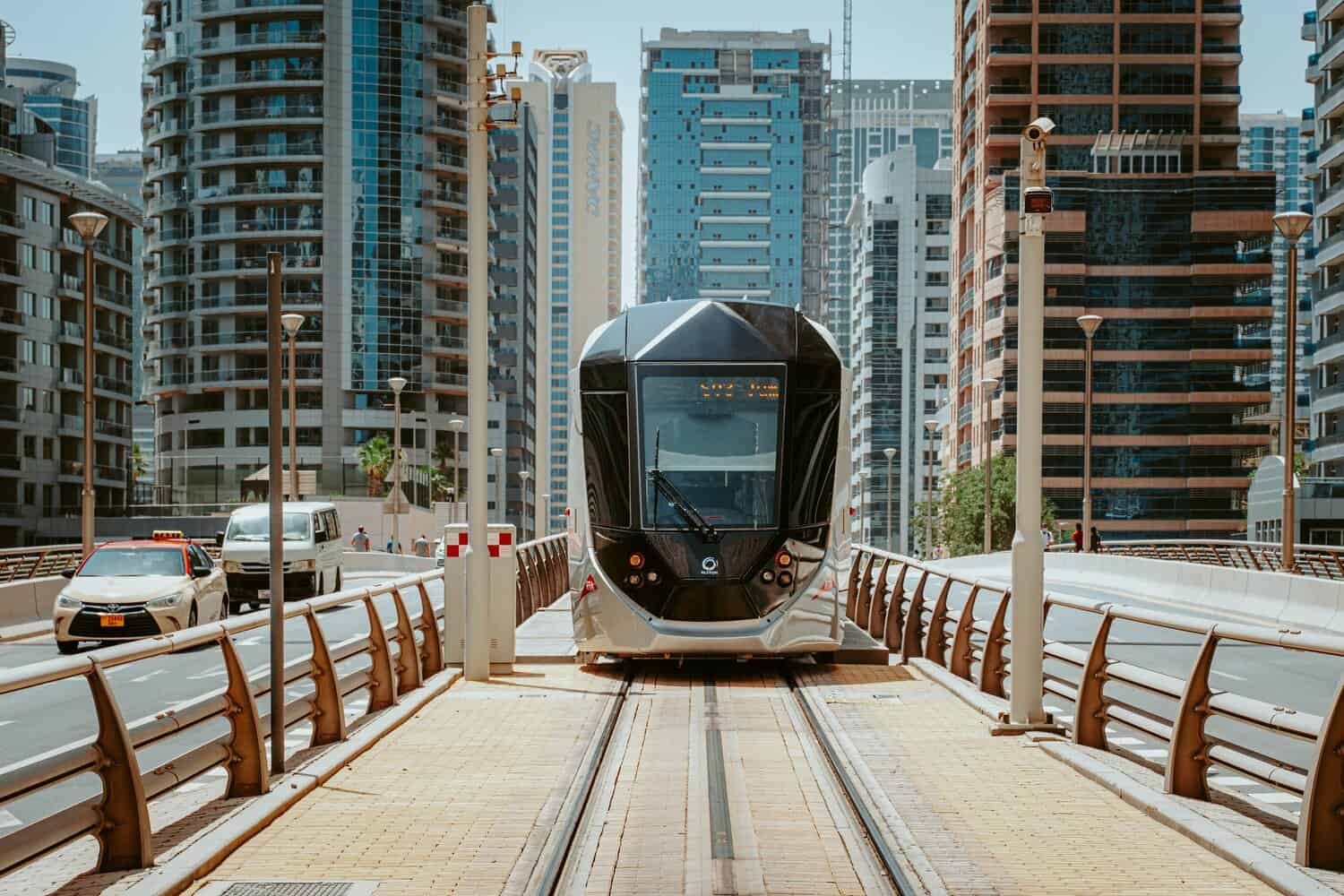
Your next option is Uber, and you also can’t go wrong here. Uber in Sao Paulo is shockingly cheap, and perfectly safe. We went on several 45-minute, 15-mile rides during our trip that cost around $5 each.
There are always Uber drivers around, and Uber is an awesome option if the metro route isn’t convenient or if your trip is relatively close. A 10-minute trip might only cost you about $2, which is only a few cents more than a metro trip but takes significantly less time and effort. You can’t beat that!
To get from Sao Paulo’s main airport, Guarulhos (GRU) to the city, you can use both the metro and Uber. We’d recommend Uber if you have baggage, as wheeling suitcases through the metro system might not be very fun, and an Uber from the airport to the center of Sao Paulo only costs about $15-20 depending on the time of the day.
The metro is also possible, and if you opt for this route your best bet is to either take the Airport-Express train to Luz metro station or take a bus to either Barra Funda, Republica, or Tatuape metro stations, from which you can connect to the rest of the city. We took an Uber to get from the airport to the city, and then the metro to get back from the city to the airport.
Where to Stay in São Paulo
Sao Paulo, along with the rest of Brazil, has a reputation for danger and violent crime. While that is certainly true in some parts of the city, we didn’t feel in danger once during our visit. To us, it felt perfectly safe, and we only took basic precautions to protect ourselves.
With that being said, it doesn’t hurt to stay in a good neighborhood! We explored the entire city, and we definitely recommend either staying in any of the Jardins neighborhoods, somewhere along or near Avenida Paulista, or Pinhieros.
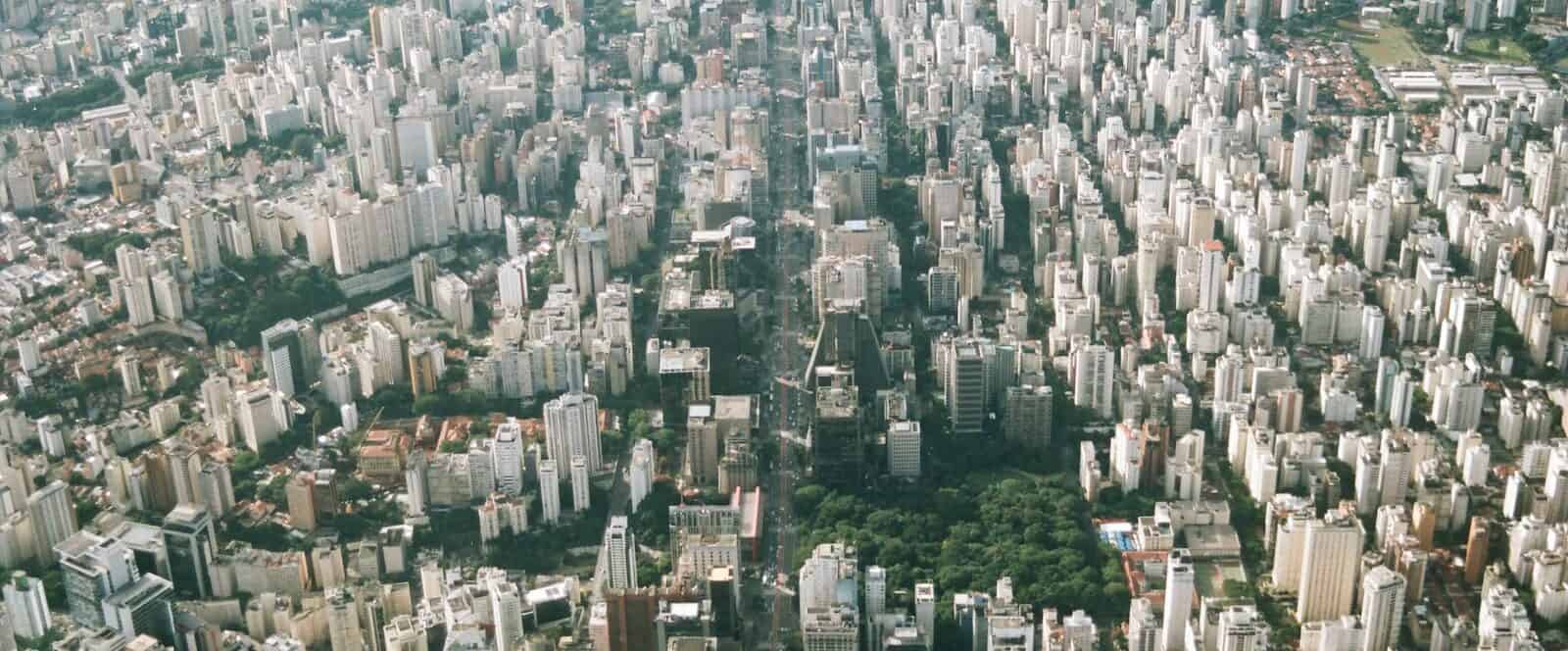
The Best Time to Visit São Paulo
The best time to visit Sao Paulo is during Brazil’s summer months, which run from December to March. This high season is when the city experiences pleasantly high temperatures, nice weather, and fully open amenities.
The ideal time to visit Brazil is from December to March.
While the summer is optimal, the winter months provide comfortable temperatures as well. We visited Sao Paulo in May, and the weather was immaculate. Remember that the Southern Hemisphere’s seasons are opposite of the Northern Hemisphere. Summer in Brazil takes place during winter in the Northern Hemisphere.
Because of its latitude, Sao Paulo is fairly pleasant to visit all year round. The summer months from December to March will provide the warmest temperatures, while the winter months from June to August will be the least crowded.
Because of its latitude, Sao Paulo is fairly pleasant to visit all year round.
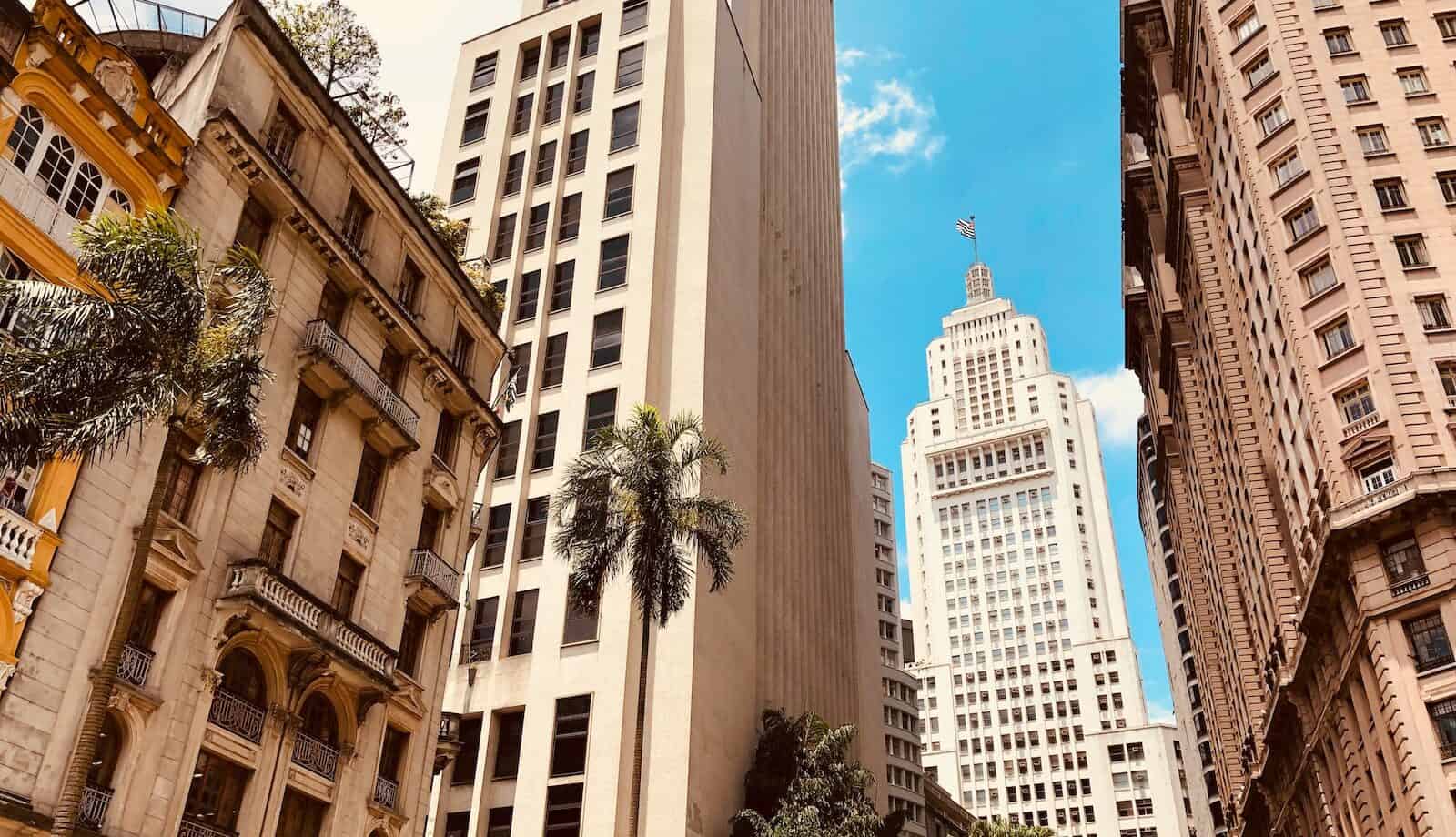
Is São Paulo Worth Visiting?
Brazil is one of the biggest countries in the world, and Sao Paulo is its biggest city by far. Its size doesn’t necessarily mean that it is a good place to visit, though! With all of the other incredible destinations in Brazil and South America, is Sao Paulo worth visiting?
We would certainly say so.
We visited several cities during our time in Brazil, and Sao Paulo was our favorite by far.
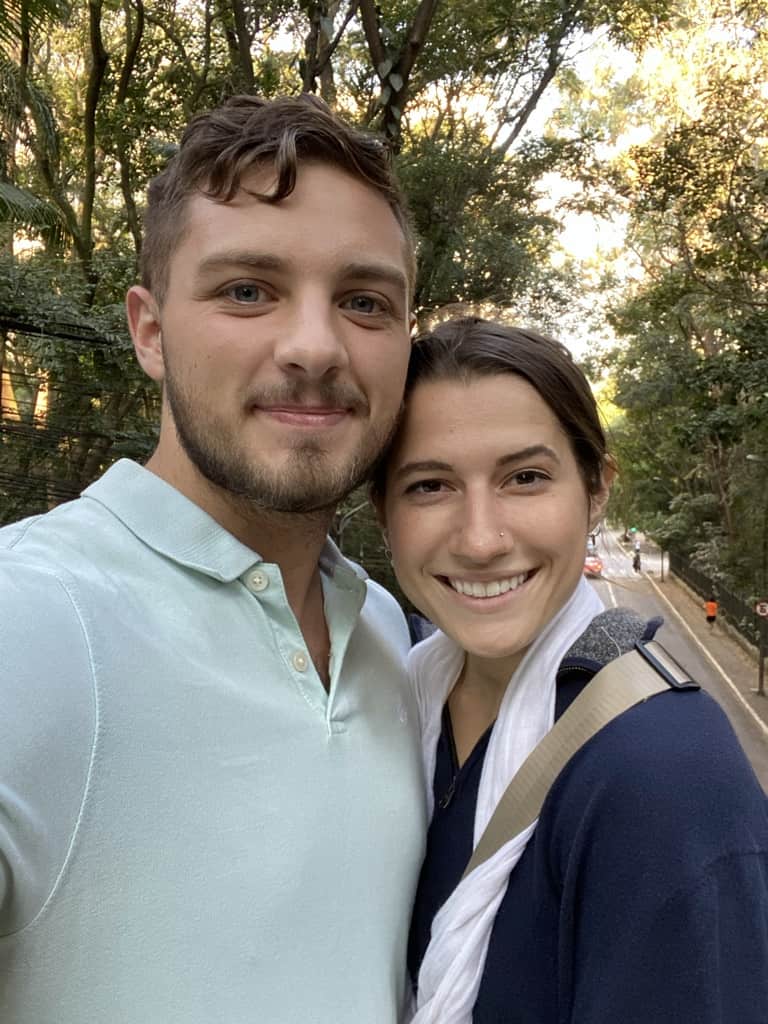
From the diverse Brazilian, Japanese, Chinese, and Italian cuisine to the broad range of fun activities spread throughout the city, Sao Paulo is absolutely loaded with incredible things to do and see. We would return to Sao Paulo in a heartbeat if we had the opportunity!
Sao Paulo is one of the most well-rounded cities that we have ever visited. We even imagine what it would be like living there some day.
Our Final São Paulo Tips
As I said earlier, Sao Paulo is largely a safe city for tourists. We never once had any kind of problem, nor did we feel endangered in any way. While this might not be the case in certain bad neighborhoods on the fringe of the city, you really have no need to visit them anyway.
Beware of Pickpocketers
If you stick to the main things to do in this Sao Paulo travel guide, you shouldn’t experience any threats. Still, you should take the normal precautions that you would take in any big city. There is a pickpocket risk in just about any metropolis on the planet, and Sao Paulo is no different.
Be Cognizant That Sao Paulo Has Major Poverty
Be prepared to see some interesting manifestations of poverty in certain popular areas, too. For example, the Cathedral Square and its surrounding area are notoriously home to hundreds of tents where homeless people are living. While 99% of them are not looking to cause you any harm whatsoever, we were warned that desperate people may do desperate things and that in areas like this you should watch your pockets and keep your phone and other valuables hidden.
Follow the Crowd
We discovered that one of the best ways to get a feel for Sao Paulo was walking around and just following the crowds. By doing this we wound up at open-air markets, awesome street food locations, beautiful parks, and more.
Speaking of parks and doing what the locals do, drinking in the streets is completely legal, but being drunk isn’t. Take your beer with you on your walk or take a bottle of wine to a picnic, but be responsible!
Hi, I'm Greg. I'm an avid traveler who has traveled to over 50 countries all around the world with my wife and kids. I've lived in Italy, Mexico, China, and the United States, and I dream of moving abroad again in the future. With this blog, I provide my audience with detailed destination guides to my favorite places and pro-tips to make travel as stress-free as possible.
Bill Sheikh
Excellent writing, good summary and I am planning to visit. Thank you.
Thanks, Bill! Have an amazing trip and feel free to reach out with any questions!
Leave a comment
Save my name, email, and website in this browser for the next time I comment.
Meet The Author - Greg

Recent Post

Most Famous Churches in Florence, Italy: Where to Visit
July 5, 2024

10 Best Coffee Drinks to Buy From Starbucks in India
April 26, 2024

How Much Does a Trip to Egypt Cost: Budget Breakdown
March 10, 2024

Best Time to Visit the India Gate in Delhi [2024]
March 1, 2024

Flying with a Sinus Infection: Tips to Avoid Pain
February 20, 2024

São Paulo Travel Guide

Courtesy of (c) Conrado Tramontini | Getty Images

Why Go To Sao Paulo
This massive megalopolis of more than 20 million people makes São Paulo one of the largest cities by population in the world. São Paulo (also known as Sampa by its residents) is characterized by its trademark wide avenues and uniquely designed skyscrapers, which showcase its modern appearance. Whether you're interested in exploring museums and parks or discovering the culinary scene, this cosmopolitan city has something for everyone.
So what's the first thing to do? Take in São Paulo's stunning cityscape from the top of the Edifício Itália , which provides a breathtaking panoramic view of this bustling city. Nearby, you can browse the gourmet foods and grab a bite to eat at Mercado Municipal de São Paulo . Also in this neighborhood, the neo-Gothic Catedral da Sé de São Paulo may catch your eye with its enormous spires or the gorgeous Theatro Municipal de São Paulo might pique your interest with is detailed facade.
Next, make your way to Avenida Paulista for a stroll – it's one of the city's premier streets, filled with shops, hotels and the Museu de Arte de São Paulo , home to collections from artists like Vincent van Gogh, Rembrandt, Picasso and Degas. When you tire of the concrete jungle, head to the Parque do Ibirapuera , which offers a relaxing escape from São Paulo's hectic streets and sky-high buildings.
Find Flight and Hotel Deals
Navigate forward to interact with the calendar and select a date. Press the question mark key to get the keyboard shortcuts for changing dates.
Navigate backward to interact with the calendar and select a date. Press the question mark key to get the keyboard shortcuts for changing dates.
Best of São Paulo
Best hotels in são paulo.
- in Pullman Sao Paulo Ibirapuera
- in InterContinental São Paulo
- in Tivoli Sao Paulo - Mofarrej

Best Things to Do in São Paulo
- # 1 in Parque do Ibirapuera (Ibirapuera Park)
- # 2 in Pinacoteca do Estado
- # 3 in Theatro Municipal de São Paulo

Popular Tours

5-hour Private Tour Of São Paulo With Its Main Sights – Optional Airport Pickup
(468 reviews)
from $ 162.00

Amazing São Paulo overview in 4 or 5 hours with a private guide
(158 reviews)
from $ 68.00

5 Hour Private Guided Tour of São Paulo With Fruit Tasting
(61 reviews)
from $ 143.84
São Paulo Travel Tips
Best months to visit.
The best time to visit São Paulo is from March to May or October to November (the fall and spring shoulder seasons) when the temperatures are comfortable, the city sees less precipitation (and less haze) and premier events are in full swing. Because it's located in the Southern Hemisphere, the city sees opposite seasons from those in the Northern Hemisphere (like the United States). Summer in São Paulo (December to February) is hot and wet, with highs hovering around the 80s, while winter (from June to September) sees comfortable temperatures and little precipitation, making it the high season. Overall, the weather year-round in São Paulo is pleasant, with temperatures rarely dipping below 50 degrees Fahrenheit.
Weather in São Paulo
Data sourced from the National Climatic Data Center
What You Need to Know
Sports reign supreme Soccer or futebol is quite popular in São Paulo and the city has several clubs. Consider seeing a game or exploring the Museu do Futebol .
Watch where you go Avoid cortiços , the inner-city slums, and favelas , shantytowns on the outskirts of the city. These are dangerous areas where drug use, violence and crime are widespread.
Stay alert Be aware of your surroundings. São Paulo has a reputation for crime, including armed robberies, pickpocketing and muggings. Leave valuables like laptops and jewelry at home, and keep your cellphone concealed. Carry a copy of your passport with you and leave your passport in your hotel room's safe.
How to Save Money in São Paulo
Do your research Take advantage of the museums, concerts and activities across São Paulo – most are affordable and many are free.
Stick to two feet Walk or use the metro to maneuver around the city during the day. It's easy to navigate and tickets are inexpensive. However, at night it's safest to take a taxi or an Uber.
Stay at a pousada Pousadas are smaller inns that often include breakfast and generally offer cheaper rates than the city's hotels.
Culture & Customs
Paulistanos , or residents of São Paulo, are known as a work-hard, play-hard bunch. Because Sampa (the city's nickname) is the financial and industrial hub of Brazil, it is filled with people of many different backgrounds. Portuguese is the official language, though Paulistanos know some English and many understand Spanish. You should probably learn some essential phrases in Portuguese to help you while you're visiting: olá (hello), bom dia (good morning), ó desculpe (excuse me), não compreendo (I don't understand), por favor (please), obrigado/a (thank you), Você fala inglês? (Do you speak English?) and Onde está o banheiro? (Where is the bathroom?) are a few to memorize. Also, write down the addresses of destinations in case you need to ask for help finding locations.
People in São Paulo typically don casual and comfortable clothing, but seeing as the city is a hotbed for fashion, you'll also notice many Paulistanos dressed to the nines in colorful attire. Since the city is a commercial hub, too, you'll encounter businessmen and women wearing suits to work.
When it comes to money, São Paulo's official currency is the real (BRL); since the real to U.S. dollar exchange range fluctuates, check what the current exchange rate is before you go. Major credit cards are also accepted at most restaurants, hotels and shops, though in smaller eateries and stores you may have more difficulty using a credit card. (Also, keep in mind some ATMs may not accept international debit cards.) Tipping in Brazil isn't required (a tip of around 10 percent is usually included as a service charge on the bill in restaurants), but it is appreciated. If the service charge isn't included on your bill, a tip of 10 to 15 percent should suffice.
As with many of the world's large metropolitan areas, Sao Paulo does have a dangerous side that can plague the unsuspecting tourist. Kidnappings, murders, rapes, muggings and robberies are not uncommon. Travelers should take several precautions to protect themselves while in the city, especially around the tourist areas and at night. Some tips: Do not wear expensive jewelry or watches. Travel with only as much cash as you'll need each day and leave the rest (and your passport) at your hotel or apartment. Keep wallets, purses, cellphones and cameras concealed and stay alert when you need to pull money out. If you're traveling with a laptop, be especially careful to conceal it in a backpack or your luggage. (Laptops are the No. 1 target of criminals in the city.)
What to Eat
Because the city is a melting pot, you can find cuisines from around the world in São Paulo. However, chances are you'll be looking for a traditional taste of Brazil. Try Mani or D.O.M. , both of which consistently earn spots on the World's 50 Best Restaurants list (as voted on by world-renowned chefs, restaurateurs and restaurant critics). Earning its second Michelin star in 2018, Tuju is a standout for its innovative and exquisite seasonal cuisine. These venues spotlight Brazilian cuisine through robust flavors and authentic foods but are typically expensive and booked weeks – if not months – in advance.
Steakhouses (aka churrascarias ) are another staple in Brazil and some of Sampa's best include Varanda Grill (travelers say steaks here are seasoned well and cooked "to perfection") and Barbacoa (visitors praise the salad bar in addition to the meat). Other eateries that win favor with critics, residents and travelers range from Italian classics at Bráz Pizzaria to Japanese fare at Kinoshita . Another excellent option is A Casa do Porco , one more restaurant on the world's best, which serves up pork, in creative and inventive ways to huge success.
If you're looking for more casual or affordable eats, check out one of São Paulo's lanchonetes , which offer savory, light meals for cheap, or swing by a sandwich bar for a mortadella sandwich (a heaping mound of thinly sliced Italian mortadella sausage and provolone cheese on a sourdough roll) and an ice cold chop (beer). Travelers say the best sandwiches can be found in the Mercado Municipal . Whatever your budget, a great way to start any meal is with a refreshing caipirinha, Brazil's national cocktail made with sugar cane liquor, sugar and lime.
Getting Around São Paulo
The best way to get around São Paulo is on foot or via metro. If you plan out your itinerary in advance and group visiting popular attractions , you should be able to traverse between them on your own two feet. The metro is also a fast, clean, relatively safe and efficient option, and connects travelers to many of the city's beloved sights. At night, taxis or Ubers are the best way to get around and likely the best way to get from São Paulo–Guarulhos International Airport (GRU) into the city center, which is about 15 miles southwest (but always factor extra time for the city's notorious traffic). Congonhas Airport (CGH) also services the city with domestic flights; it's located around 5 miles south of the downtown area and will likely be the airport you use to travel to and from Rio de Janeiro (the majority of its flights are to Rio).
Entry & Exit Requirements
U.S. citizens must present a valid passport and a tourist visa upon entering Brazil. You can apply online or through a Brazilian consulate in the U.S. For more information on entry and exit requirements, visit the U.S. Department of State's website .
São Paulo is known for its tall skyscrapers and the expansive Ibirapuera Park .
Explore More of São Paulo

Things To Do
Best hotels.

You might also like

New York City
# 1 in Best U.S. Cities to Visit

# 6 in Best Cheap Vacations in Central and South America

Rio de Janeiro
# 8 in Best Places to Visit in Central and South America
If you make a purchase from our site, we may earn a commission. This does not affect the quality or independence of our editorial content.
Recommended
16 Top Adults-Only All-Inclusive Resorts in Mexico
Christina Maggitas|Rachael Hood|Catriona Kendall September 13, 2024

The 26 Best Beach Resorts in the World
Marisa Méndez|Erin Vasta|Rachael Hood|Catriona Kendall September 5, 2024

30 Fun Fall Weekend Getaways for 2024
Holly Johnson August 29, 2024

The 19 Best Fall Family Vacations for 2024
Amanda Norcross August 27, 2024

The 28 Best Water Parks in the U.S. for 2024
Holly Johnson|Timothy J. Forster May 8, 2024

The 18 Best Napa Valley Wineries to Visit in 2024
Lyn Mettler|Sharael Kolberg April 23, 2024

The 25 Best Beaches on the East Coast for 2024
Timothy J. Forster|Sharael Kolberg April 19, 2024

The 50 Best Hotels in the USA 2024
Christina Maggitas February 6, 2024

The 32 Most Famous Landmarks in the World
Gwen Pratesi|Timothy J. Forster February 1, 2024

9 Top All-Inclusive Resorts in Florida for 2024
Gwen Pratesi|Amanda Norcross January 5, 2024

Rio de Janeiro or São Paulo: Which city should you visit on your first trip to Brazil?

It’s your first trip to Brazil and you’re already faced with a tough choice: Rio de Janeiro or São Paulo? Between golden beaches and skyscrapers, samba and street art, carnival season and vibrant nightlife, here’s a guide to get immersed in the soul of these two cities with a legendary rivalry.
Rio de Janeiro: the wonderful city with a thousand colours
On the Atlantic coast, Rio de Janeiro is a sunny city, where life is best lived outdoors, to enjoy the sun, the ocean and the carnival. You can’t mention the Marvellous City without thinking of its iconic beaches, Copacabana, the most famous beach in the world, and Ipanema , its neighbour where sports fans and party-goers gather. Here, fine sand meets azure waters, surfers partake of the waves on exceptional beach breaks and Cariocas engage in endless games of beach volleyball. In February, Rio also becomes the carnival capital of the world , with its flamboyant parades and street parties lasting until the early hours of the morning. Rio is also a city of contrasts, where you can go from crowded beaches to the steep streets of the bohemian Santa Teresa district , known for its colourful colonial houses and artists’ studios, in the blink of an eye. In Lapa, another facet of Rio comes alive at nightfall. There, historic arches are side-by-side with lively bars and samba clubs in an explosive cocktail of music, dance and happy gatherings.
The Marvellous City has plenty of options when it comes to connecting with nature. Just outside the city, the Corcovado and Sugarloaf mountains offer breathtaking views of the coastline and Guanabara Bay. You can climb to the top of Corcovado to admire the statue of Christ the Redeemer, one of the Seven Wonders of the Modern World . The botanical gardens, east of the lagoon, and Tijuca National Park, the world’s largest urban forest, offer a lush getaway with the chance of seeing monkeys and toucans.

São Paulo: the avant-garde, cultural metropolis
São Paulo is an urban powerhouse with the ceaseless effervescence of a 12-million strong megalopolis. While Rio might entice tourists with its natural landscapes, São Paulo’s charms lie in its cultural and artistic diversity. The Vila Madalena district, the epicentre of Brazilian street art, is a must for discovering the vibrant works by artists from all over the world, daubed over every wall and alley. Surrounded by bars and botecos , the famous Beco do Batman is particularly notable; it is a living wall with constantly renewed frescoes. If your tastes run cultural, you won’t want to miss a visit to the Museo de Arte de São Paulo, with its impressive collection of works by European masters, or the Pinacoteca do Estado , which offers one of the finest panoramas of Brazilian art from the 19 th and 20 th centuries.
The Paulista nightlife will entice music lovers and party-goers with its sheer variety: rooftop nightclubs, cocktail bars, bossa nova concerts, underground rock scenes… São Paulo is an endless playground for night owls! When it comes to gastronomy, Brazil’s economic capital has nothing to be ashamed of: in this cosmopolitan city, there is a host of restaurants, blending Italian, Japanese, Mediterranean and Brazilian influences. In a Michelin-starred restaurant (São Paulo has around fifteen), a churrascaria or a more typical boteco , you can enjoy daring culinary concoctions, from the freshest of sushi to a hearty feijoada . As they say in Brazil: Cariocas at the beach, Paulistanos at the table!

S unny Rio and electric São Paulo: two cities, two faces of Brazil
If you need to recharge your batteries surrounded by nature, Rio de Janeiro is the obvious choice. With its verdant mountains, sun-drenched beaches and natural parks, it’s a city where you can feel like you’re on a perpetual holiday. However, for architecture enthusiasts, São Paulo is also a fascinating place to explore. The city is an open-air architecture museum , a blend of Art Deco, Brazilian Brutalism and modern skyscrapers. Iconic buildings such as the Edifício Copan, designed by Oscar Niemeyer, and the Portuguese Language Museum, inaugurated in 1867, embody this architectural wealth.
Choosing between Rio de Janeiro and São Paulo for your first trip to Brazil means choosing between two very different experiences. Rio is best for those who want to connect with nature, partying in the sunshine and the relaxed atmosphere of beaches and samba clubs. São Paulo, on the other hand, is full of street art, impressive architecture and intense nightlife. Why not enjoy both, and share a holiday between these two magnetic, complementary cities?
Discover Brazil
Book a flight
Share this article

Brazil: The natural wonder of the Pantanal, the largest wetland on the planet

This small paradisiac island in South East Asia was voted the best seaside resort in the continent

4 legendary road trips to experience once in a lifetime in the United States

A new ranking lists the 10 best monuments in Europe to visit once in your life

Where to go in Costa Rica? The most beautiful towns to visit, with nature at its heart

Zaha Hadid’s 6 finest works to see around the world

5 places to visit in Lisbon off the beaten track

The most beautiful cities in the Caribbean for a delightful holiday in the sun

COMMENTS
Brazil Travel Advisory. Reissued with updates to Country Summary. Exercise increased caution in Brazil due to crime. Some areas have increased risk. Read the entire Travel Advisory. Do not travel to: Any areas within 150 km/100 miles of Brazil's land borders with Venezuela, Colombia, Peru, Bolivia, Guyana, Suriname, French Guiana, and ...
6 Essential Adventure Travel Safety Tips for Brazil. There are plenty of adventure destinations in Brazil beyond the Amazon and Iguazu Falls. Find out how to experience Brazil's wild destinations safely. ... Also most people in Sao Paulo do NOT own a car. Reply. Kevin said 5 years ago "Places far from the city center, like Pari, Perdizes and ...
Brazil - safety as a country. São Paulo, the largest city in Brazil has a city population of 11 million and even more than 20 million in the metropolitan region. Many immigrants used to be attracted to this incredible city, so it is one of the most diverse cities in the world. Sao Paulo is the capital of rich people, nightlife and culture.
Secretary of the Treasury Janet L. Yellen's Travel to Brazil; Brazilian Navy to conduct helicopter cargo transfer with the U.S. Navy; Security Alert - Worldwide Caution, May 17, 2024; Sao Paulo. Demonstration Alert for U.S. Citizens; Security Alert - Worldwide Caution, May 17, 2024; U.S. Launches Funding for Projects in Culture, Education ...
All individuals ages 12 and older traveling to Brazil by air must present proof of COVID-19 vaccination (electronic or printed), in addition to a Traveler's Health Declaration (DSV) completed no more than 24 hours prior to boarding, and proof of a negative COVID-19 test, either an RT-PCR test performed within 72 hours of boarding or an antigen test performed within 24 hours of boarding ...
Safety Facts about Sao Paulo, Brazil. Sao Paulo is a big city and not all areas are safe. When it comes to traveling by metro, for example, the green line is usually the safest and both the blue and red lines should be taken with more caution. Numbeo shows that the crime index is 70.37, which is quite high but keep in mind such statistics ...
Effective midnight on April 10, 2025, a visa will be required for U.S. citizens to travel to Brazil, regardless of the purpose of travel. For more information about ... the U.S. Consulate General in Sao Paulo at 011-55-11-3250-5000; See our webpage on help for U.S. victims ... Road Conditions and Safety: Driving on Brazil's roads poses ...
To call for emergency services while in Brazil, dial 192 for an ambulance, 193 for the fire department, and 190 for the police. Write these numbers down to carry with you during your trip. Learn as much as you can about Brazil before you travel there. A good place to start is the country-specific information on Brazil from the US Department of ...
Heavy rainfall. The rainy season runs from November until March in the south and south-east (including Rio de Janeiro - see Regional risks) and from April until July in the north-east of Brazil ...
Your passport must be valid for at least 6 months beyond the date you expect to leave Brazil. Passport for official travel. Different entry rules may apply. ... 16º andar, 04578-000 São Paulo - SP, Brazil Telephone +55 11 5509 4321 Email [email protected] Internet https: ... Avoid non-essential travel. Your safety and security ...
15 Top Safety Tips for Traveling in São Paulo. Know the different neighborhoods - this is one of the most important tips. Avoid places like Capão Redondo, Lapa, Pari, and Campo Limpo. But do your own research before you arrive! Avoid the poor districts - the poorer the district, the more unsafe it is.
5. don't leave your valuables unattended to. Never leave your valuables unattended to in Brazil. This includes at coffee shops where you may have your laptop or iPad out while going to the bathroom. It's not to say that the people around you are bad or won't watch your things when you ask, because they will.
Plan your trip to Sao Paulo by exploring the best things to do, food to eat, and places to stay. ... Safety & Insurance Air Travel Cruises Budget Travel Car Rentals Miles & Points Inspiration ... Sao Paulo is the financial center of Brazil and one of the largest cities in the world. Expect a much faster pace of life, and people letting loose at ...
Violence has been falling in almost every state in Brazil for the better part of a decade. In 2001, there were murders in S*o Paulo comparable to those in Mexico. This number has dropped to a 20-year low of 6.42 in less than two decades. There are a few precautions to take, but in the end, Uber is a very safe service.
Sao Paulo Warnings and Dangers Sao Paulo is home to over 12 million people, and is the financial heartbeat of Brazil. ... consult a travel agent and ask if the area is safe. Most neighborhoods are ...
Personal Safety Tips. While São Paulo is generally a safe city for tourists, it's always important to take personal safety precautions. Here are some tips to help ensure your safety during your visit: Stay Alert and Be Aware: Pay attention to your surroundings, especially in crowded areas or tourist attractions.
Sao Paulo's system of six color-coded subway lines is easy, reliable, and safe. Buses are plentiful but tough to navigate if you don't know Portuguese. Stick to the subway or Uber in Sao Paulo. 3. Expecting natural beauty in Sao Paulo. Ibirapuera Park/Oyster. Sao Paulo is very much not Rio.
Last Updated: August 27, 2024. A lot of travelers skip São Paulo when visiting Brazil, choosing to go to Rio de Janeiro and other parts of the country instead. This sprawling metropolis shouldn't be skipped. Originally inhabited by the indigenous Tupi people, Portuguese Jesuit priests colonized the area in 1554.
r/travel is a community about exploring the world. Your pictures, questions, stories, or any good content is welcome. ... In Sao Paulo they are much more distant. So: Always use uber, be aware of your surroundings and try not to call attention to yourself. ... We can help to pinpoint safer areas in Brazil and safety tips for wherever you want ...
The Best Time to Visit São Paulo. The best time to visit Sao Paulo is during Brazil's summer months, which run from December to March. This high season is when the city experiences pleasantly high temperatures, nice weather, and fully open amenities. The ideal time to visit Brazil is from December to March.
Is São Paulo in Brazil safe or dangerous? Which are the safest places in São Paulo 2023? How to avoid trouble and not get robbed. Complete safety travel guid...
5 Hour Private Guided Tour of São Paulo With Fruit Tasting. (57 reviews) from $ 143.84. Read More. 5-hour Private Tour Of São Paulo With Its Main Sights - Optional Airport Pickup. (451 reviews ...
In 2019, 41635 people were killed in Brazil, for a population of 221.8 million. This is equal to 187.7 per million people. For comparison, in 2019 France had reportedly 970 people killed, for a total population of 64.4 million people. This is equal to 14.4 per million people.
Rio de Janeiro: the wonderful city with a thousand colours. On the Atlantic coast, Rio de Janeiro is a sunny city, where life is best lived outdoors, to enjoy the sun, the ocean and the carnival. You can't mention the Marvellous City without thinking of its iconic beaches, Copacabana, the most famous beach in the world, and Ipanema, its neighbour where sports fans and party-goers gather.